
- Uttar Pradesh
- Uttarakhand
- Himachal Pradesh
- Andhra Pradesh
- Arunachal Pradesh
- Maharashtra
- Chhattisgarh
- Madhya Pradesh
- Andaman and Nicobar
- Lakshadweep
- Jammu and Kashmir
- BUNGEE JUMPING
- PARAGLIDING
- Wild Life Tours
- Restaurants
- Heritage Sites

Journey to Hemkund Sahib Trekking Routes, Tips, and Experiences
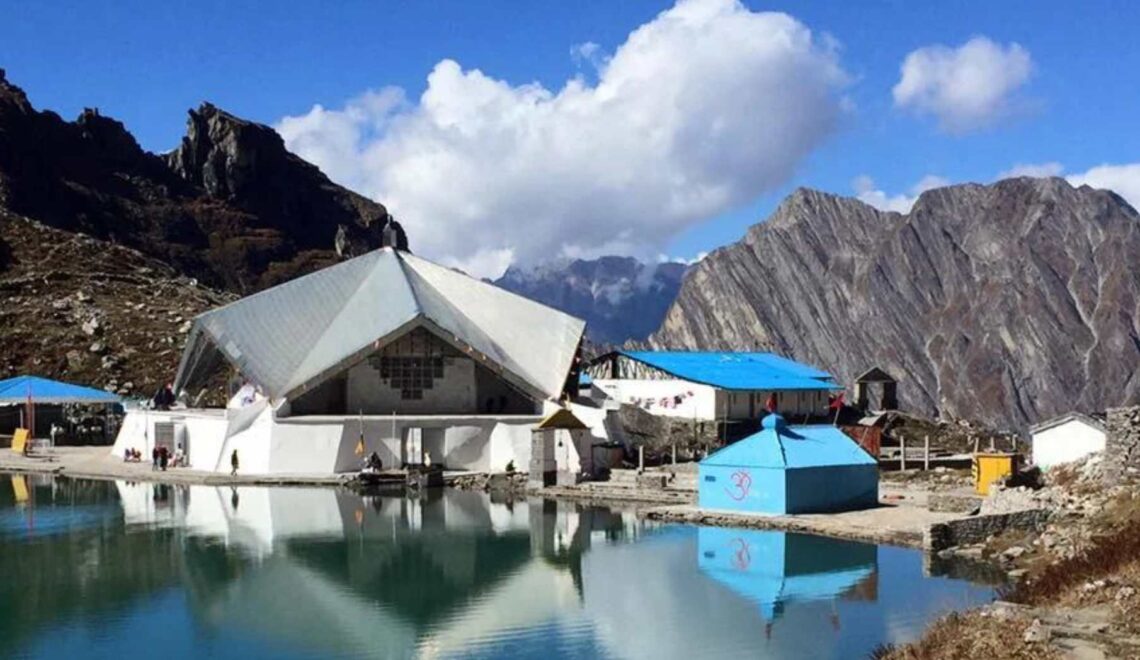
Nestled within the landscapes of the Himalayas, Hemkund Sahib stands as a sacred jewel of Sikh pilgrimage.
Perched over 4,572 meters (13,000 feet) in the Chamoli district of Uttarakhand, India, Hemkund Sahib holds profound spiritual significance for Sikhs worldwide.
The serene glacial lake, surrounded by towering snow-capped peaks, serves as the focal point of this revered site.
Devotees undertake a challenging trek through rugged terrain, symbolizing their spiritual journey towards enlightenment and self-discovery.
Legend intertwines with devotion at Hemkund Sahib, believed to be the meditation site of Guru Gobind Singh, the tenth Sikh Guru.
The gurdwara, gracefully adorned with traditional Sikh architecture, welcomes pilgrims with warmth and hospitality.
Beyond religious devotion, Hemkund Sahib’s ethereal beauty captivates travelers, offering a glimpse into the majestic grandeur of nature.
As a sanctuary of tranquility and reverence, Hemkund Sahib beckons seekers of both spiritual solace and awe-inspiring landscapes.
1. Location and Geography of Hemkund Sahib
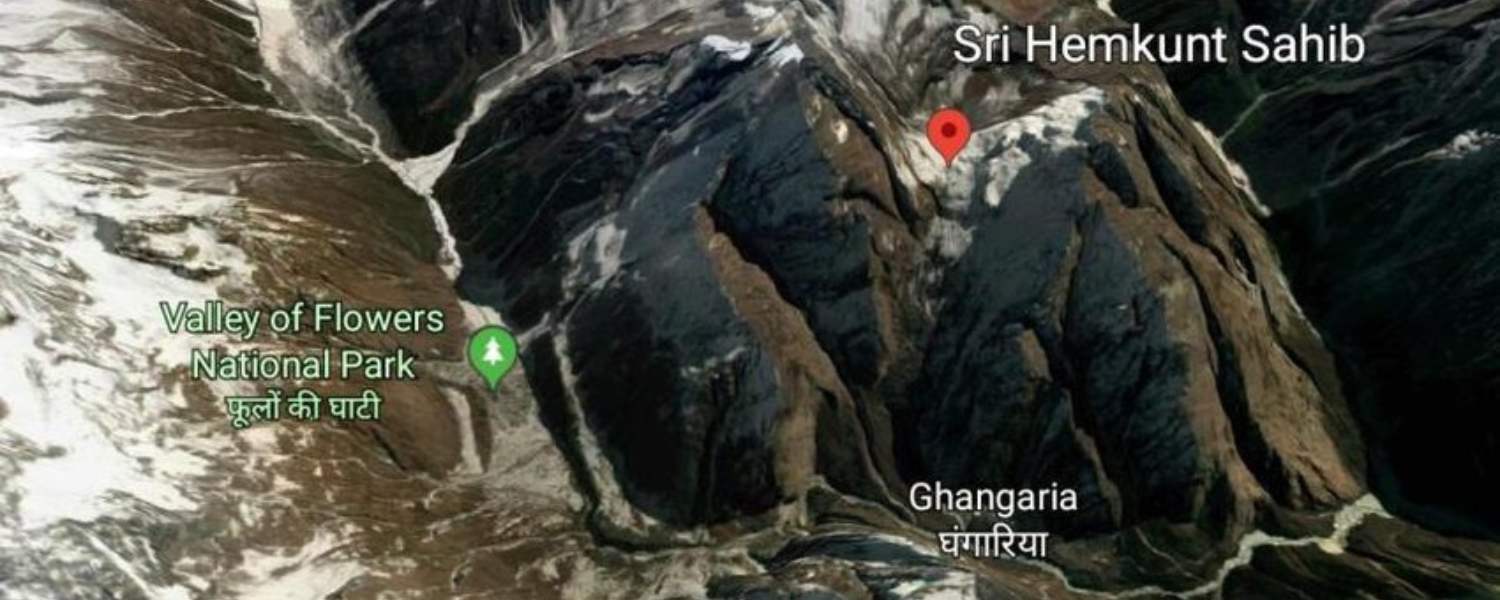
The majestic Himalayan ranges, Hemkund Sahib, or Gurudwara Shri Hemkund Sahib Ji, stand as a revered Sikh pilgrimage destination in the Chamoli district of Uttarakhand, India.
Perched at an awe-inspiring altitude exceeding 15,000 feet above sea level, this spiritual sanctuary attracts crowds of devotees from across the globe, especially during the summer months.
Located within the serene expanse of the Himalayas, Hemkund Sahib offers a breathtaking backdrop of snow-capped peaks.
Lush greenery and calm lakes make it a truly mesmerizing sight for pilgrims and nature enthusiasts alike.
The journey to this sacred site is not merely a physical one but also a spiritual odyssey.
As devotees traverse through rugged terrains and verdant valleys to reach the sanctum.
Surrounded by pristine natural beauty, Hemkund Sahib provides a tranquil ambiance conducive to introspection and prayer.
Pilgrims gather here to pay homage to Guru Gobind Singh Ji, the tenth Sikh Guru, who is believed to have meditated at this very spot.
With its serene surroundings and tranquil lake, the Gurudwara offers a sanctuary for spiritual solace and divine connection.
2. Architecture of Hemkund Sahib
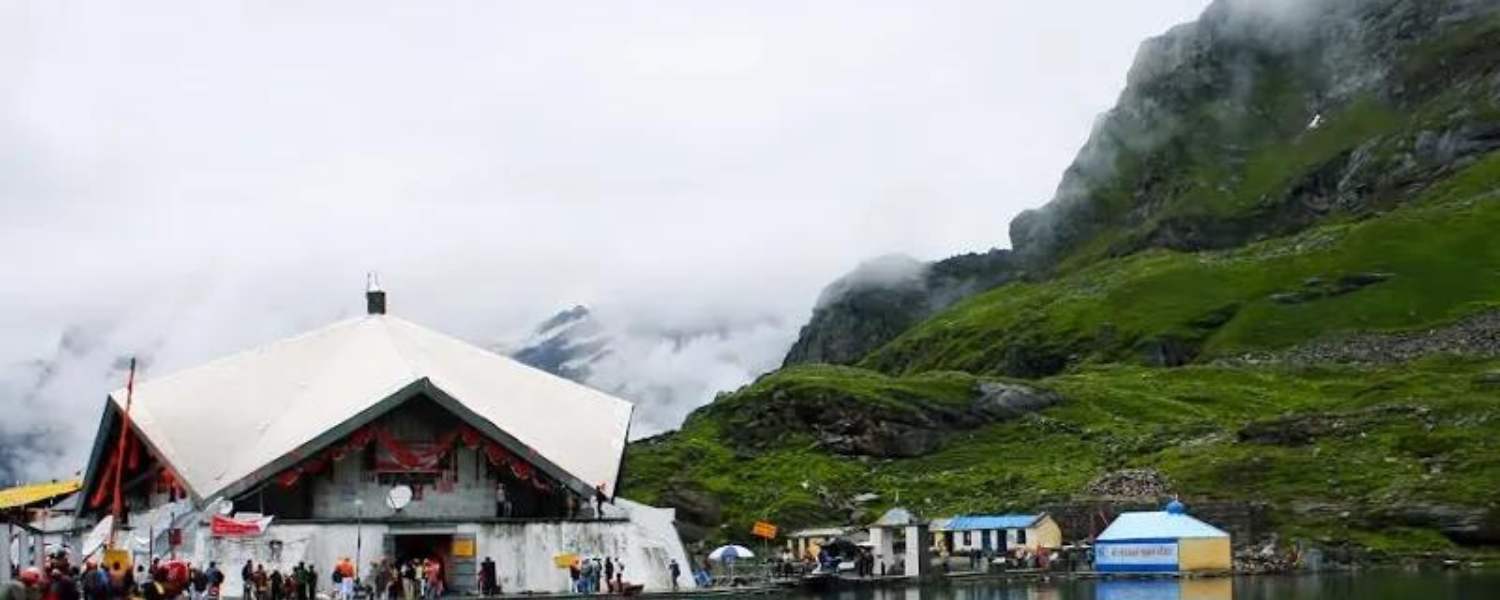
Himalayan peaks lie the unparalleled architectural marvel of Hemkund Sahib.
Perched at a breathtaking altitude of 15,210 feet, this gurdwara is a testament to faith and ingenuity.
Unlike any other gurdwara, its design combines practicality and spirituality, uniquely tailored to its lofty abode.
At first glance, the most striking feature of Hemkund Sahib is its distinctive pentagonal shape, setting it apart from all others in the Sikh faith.
This architectural choice isn’t just aesthetic; it’s a response to its challenging environment.
The pentagonal structure ensures stability against the fierce mountain winds and heavy snowfall that characterize the region.
Every facet of the design is meticulously crafted to harmonize with the harsh Himalayan climate while maintaining the sanctity of the sacred space.
The architecture of Hemkund Sahib isn’t merely about form; it’s deeply rooted in function and purpose.
Every element serves a practical role, from sturdy construction to strategically placing windows for optimal ventilation and natural light.
Despite its remote location, the gurdwara stands as a beacon of spiritual solace and community for pilgrims who brave the arduous journey to reach its hallowed grounds.
3. Flora and Fauna around Hemkund Sahib
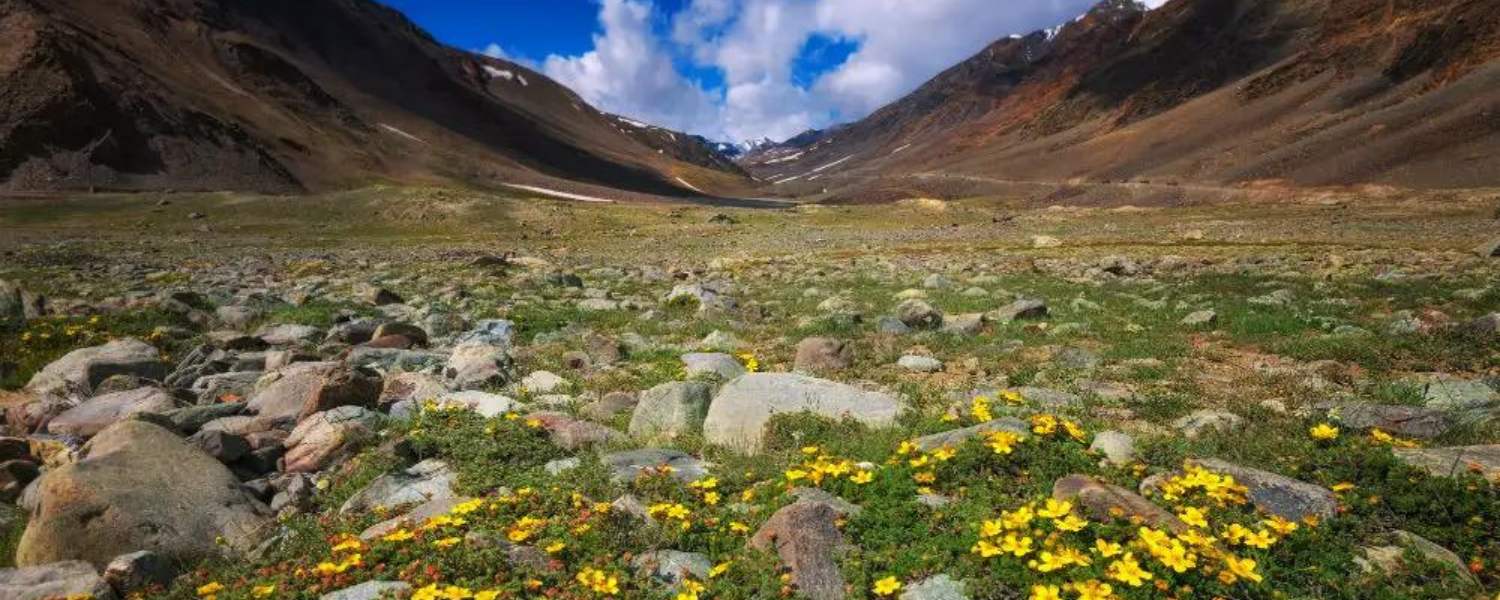
Hemkund Sahib is a sacred pilgrimage site renowned not only for its spiritual significance but also for its breathtaking natural beauty.
Situated at over 4,300 meters above sea level, this pristine location boasts a tapestry of flora/fauna, making it a paradise for nature and wildlife lovers.
Hemkund Sahib is famed for its diverse flora, showcasing a vibrant array of alpine flowers such as the enchanting Vajardanti.
Delicate Marsh Marigold, and the elusive Shomalap.
These exquisite blooms paint the landscape in a kaleidoscope of colors, creating a mesmerizing sight for visitors.
In addition to its floral wonders, Hemkund Sahib is home to various fauna.
Among the notable species found here are the majestic Asiatic black deer, the elusive snow leopard, and the graceful musk deer.
The agile red fox, the formidable brown bear, and the elusive blue sheep.
These animals roam the rugged terrain surrounding Hemkund Sahib, adding to the allure of this natural sanctuary.
Visitors to Hemkund Sahib have the opportunity to immerse themselves in the splendor of nature while embarking on spiritual journeys.
The ambiance, coupled with the abundance of flora and fauna, creates an unforgettable experience, leaving visitors in awe of the wonders of Hemkund Sahib.
Whether one seeks spiritual solace or wishes to revel in the beauty of the natural world.
Hemkund Sahib offers an unparalleled retreat into the heart of Mother Nature’s embrace.
4. Hemkund Sahib Weather and Climate
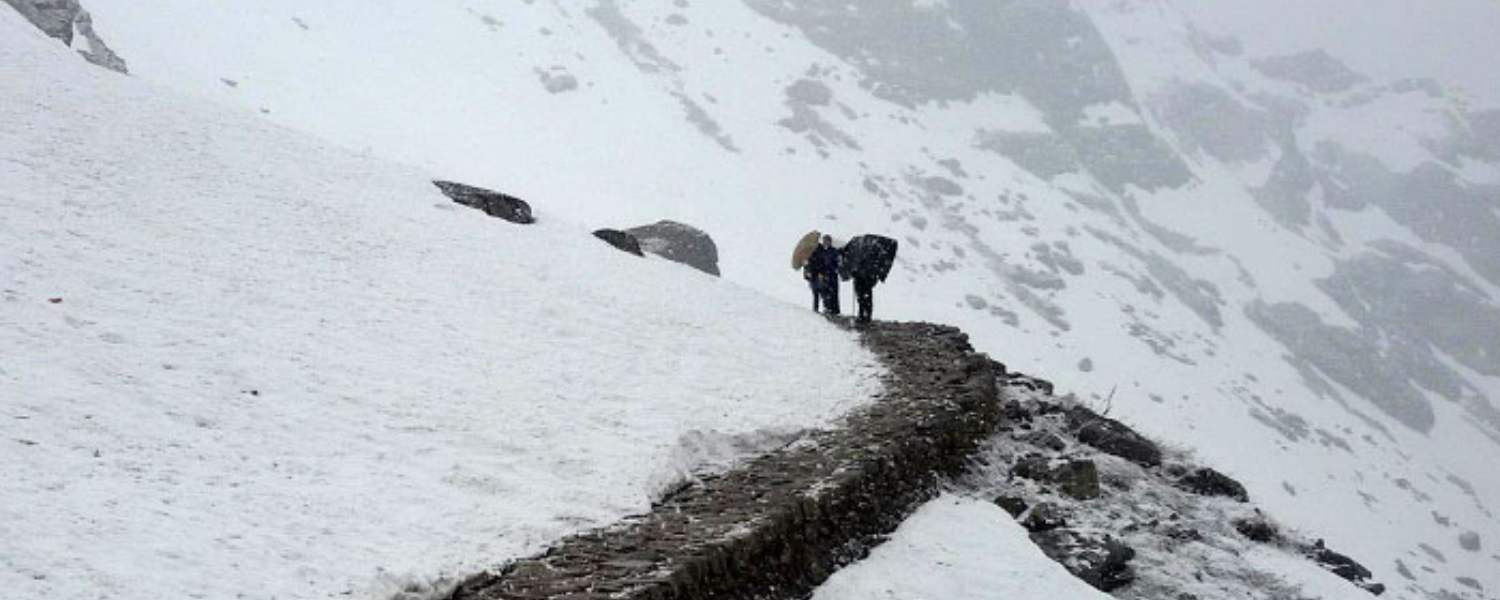
Located in the serene landscapes of the Indian state of monuments of Uttarakhand , Hemkund Sahib boasts a climate that adds to its spiritual allure.
The weather here is characterized by distinct seasons, each offering visitors its unique experience.
During the monsoon season, which typically arrives by the first week of July, Hemkund Sahib is enveloped in lush greenery as the rains rejuvenate the surroundings.
Monsoon showers persist until mid-September, nourishing the region’s flora and fauna and adding to the picturesque charm of the area.
As the monsoon bids farewell, Hemkund Sahib transitions into winter, lasting from mid-November to the end of March.
The winter months bring a stark contrast as the landscape transforms into a winter wonderland blanketed in snow.
Nights can be particularly harsh with sub-zero temperatures, especially in January and February, adding a sense of adventure to the pilgrimage journey.
Visitors to Hemkund Sahib are advised to plan their trip according to their preferences/tolerance for weather conditions.
Whether witnessing the vibrant hues of monsoon or experiencing the tranquil beauty of winter.
Hemkund Sahib offers a captivating retreat for the soul, inviting pilgrims and nature enthusiasts to immerse themselves in its mystical charm.
5. Significance of Hemkund Sahib
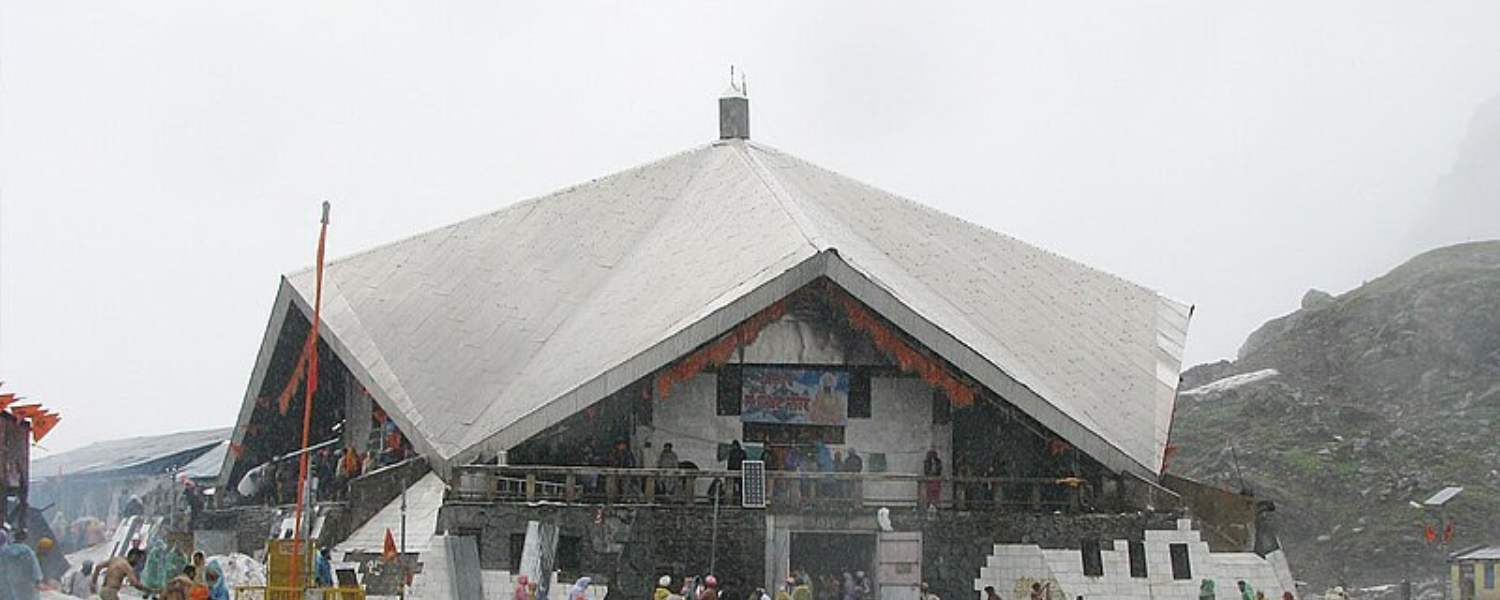
Nestled amidst the picturesque Himalayan ranges, Hemkund Sahib, or Gurudwara Sri Hemkund Sahib.
It is a spiritual solace for devotees, particularly within the Sikh community.
This sacred site is deeply rooted in Sikh Hemkund Sahib’s history and tradition.
The focal point of devotion here is the belief that Guru Gobind Singh Ji.
The revered tenth guru of Sikhism embarked on a spiritual journey, spending a decade in profound meditation within these serene surroundings.
Hemkund Sahib’s tranquil ambiance and breathtaking natural beauty create an atmosphere conducive to introspection/spiritual growth.
Pilgrims from far and wide embark on arduous journeys to pay homage to this sacred spot, seeking blessings and enlightenment.
Often undertaken on foot through rugged terrain, the journey tests one’s devotion and commitment.
The pristine glacial lake, surrounded by seven towering peaks, adds to the mystical aura of Hemkund Sahib.
Devotees dip in the holy waters, believed to cleanse the soul of impurities and bestow blessings upon the faithful.
Apart from its religious significance, Hemkund Sahib also holds ecological importance, being a part of the fragile Himalayan ecosystem.
Efforts towards conservation and sustainable tourism are integral to preserving the sanctity of this revered pilgrimage site for generations to come.
Ready to discover more about the Traditional Taste of Uttarakhand Food and their fascinating culinary traditions? Don’t miss out! Read our blog for an in-depth exploration of these hidden gems.
6. Hemkund Sahib Opening Closing Dates
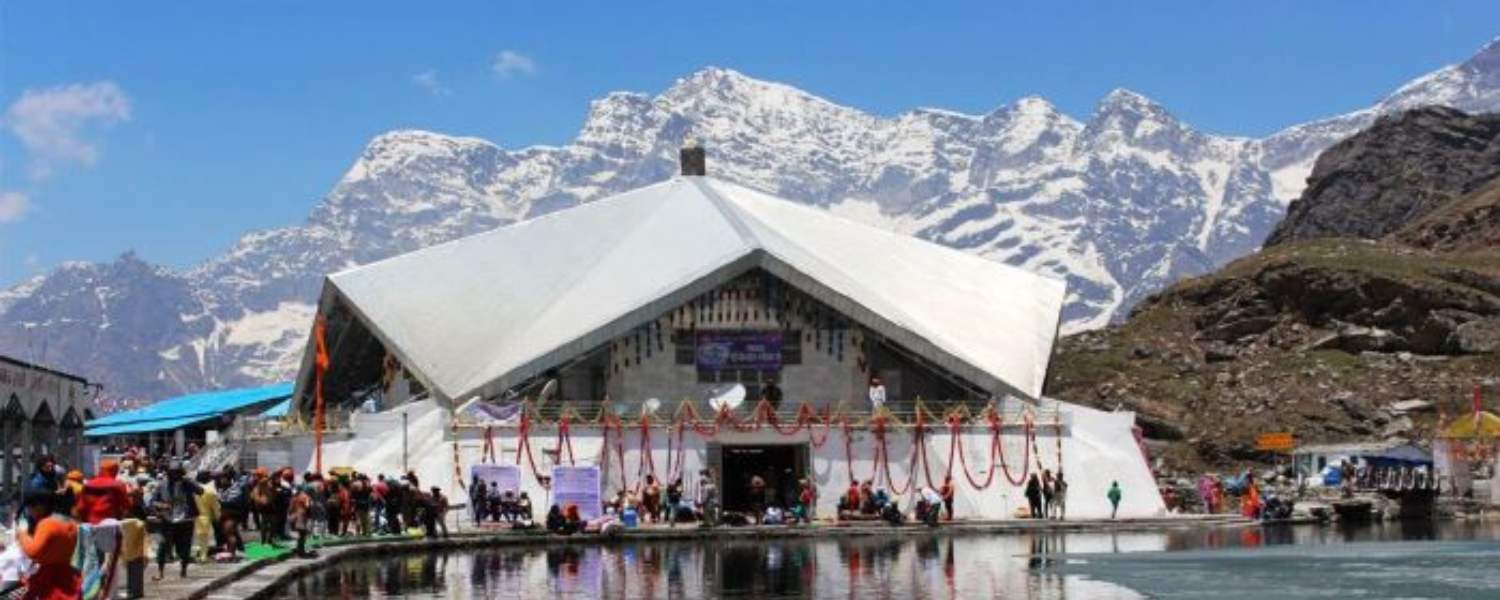
Hemkund Sahib, nestled amidst the serene Himalayas, is a revered Sikh pilgrimage site known for its tranquil ambiance and spiritual significance.
Each year, devout pilgrims eagerly await the opening of Hemkund Sahib, marking the beginning of their journey towards divine enlightenment.
In 2024, the gates of Hemkund Sahib will welcome pilgrims on the 25th of May, a date eagerly anticipated by followers worldwide.
As the snow melts and the pristine beauty of the surroundings unveils, devotees flock to Hemkund Sahib to seek solace and offer their prayers.
The opening date symbolizes a new spiritual journey for many, filled with hope, devotion, and reverence.
However, as autumn approaches and the Himalayan region prepares for the onset of winter, Hemkund Sahib bids farewell to its visitors.
The closing date for 2024 is set for October 10th, marking the end of the pilgrimage season.
Pilgrims pray, cherishing the spiritual experiences gained at Hemkund Sahib before the gates close until the following season.
For those seeking spiritual enlightenment and a connection with the divine, Hemkund Sahib offers a sacred sanctuary amidst nature’s grandeur.
Whether opening its doors to welcome pilgrims or bidding farewell at the end of the season.
The aura of Hemkund Sahib continues to inspire and uplift souls on their quest for spiritual fulfillment.
7. Best Time to Visit Hemkund Sahib
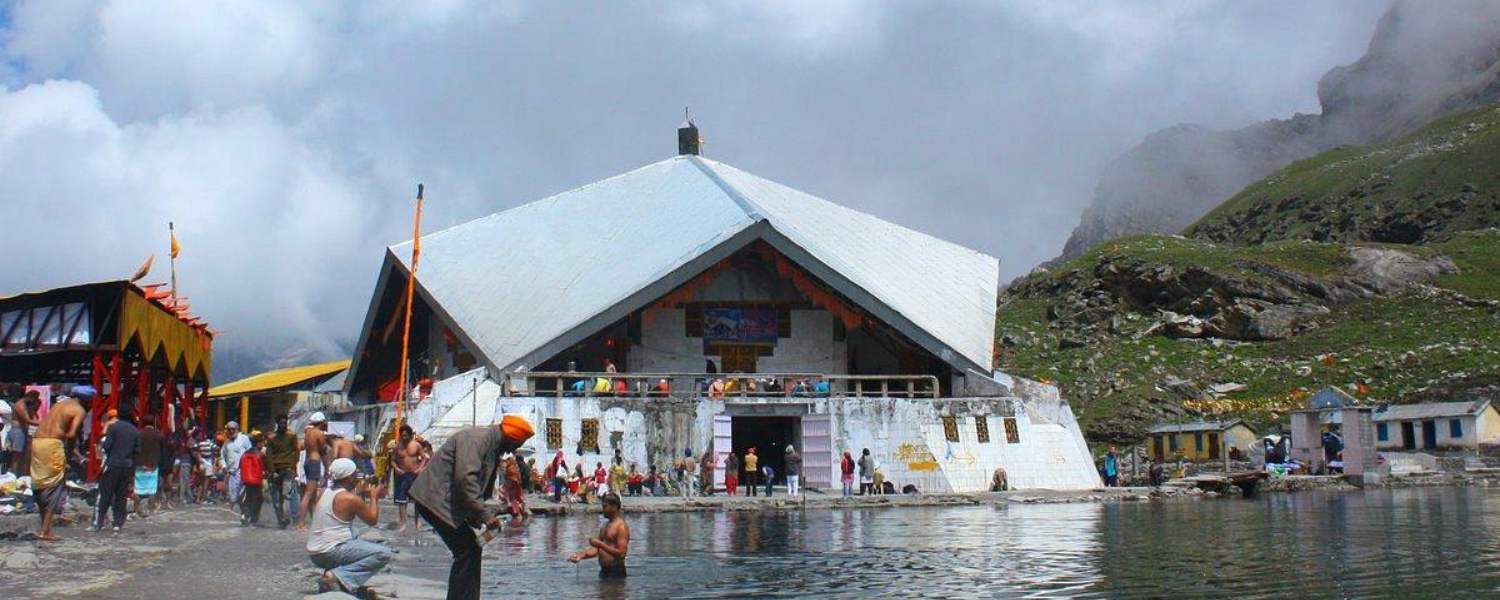
Hemkund Sahib, mark late May to June on your calendar.
This window is the prime time to embark on your spiritual expedition.
During these months, Hemkund Sahib basks in mild and pleasant weather, offering a comfortable environment for pilgrims and tourists alike.
The hold of winter’s icy touch starts to weaken, and the thawing snow paves the way for accessible trekking trails.
Facilitating a smoother pilgrimage experience.
This period boasts ideal conditions for travelers seeking solace amidst the pristine beauty of the Himalayas.
You’ll immerse yourself in a tranquil ambiance as you traverse the lush greenery and breathe in the crisp mountain air.
Perfect for reflection and spiritual rejuvenation.
The surrounding landscapes come alive with vibrant hues, enhancing the scenic charm of the journey.
Whether you’re a devout follower seeking divine blessings or an avid adventurer craving an unforgettable trekking escapade.
Late May to June offers an unparalleled opportunity to explore the sacred and picturesque realm of Hemkund Sahib.
So, pack your essentials, lace up your hiking boots, and embark on a memorable expedition to this revered destination.
Where nature and spirituality intertwine harmoniously.
Apart from that, you can visit the Mountains of Uttarakhand .
8. How to Reach Hemkund Sahib
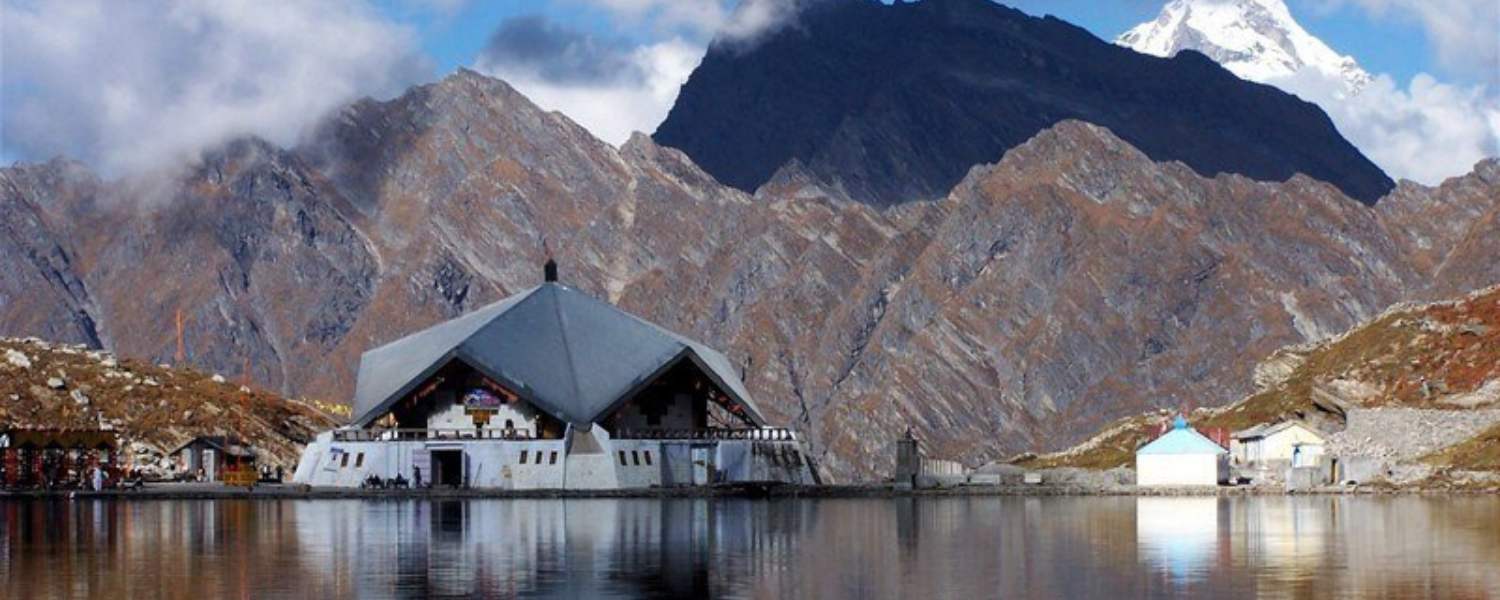
If traveling by air, your journey begins at the Jolly Grant Airport in Dehradun.
It’s approximately 268 kilometers from there to Hemkund Sahib, near Govindghat.
The airport is a gateway for many pilgrims and tourists embarking on their spiritual quest.
Rishikesh, Haridwar, and Dehradun are critical destinations for train travel.
These cities boast well-connected railway stations, offering convenient access to Hemkund Sahib.
Upon reaching any of these stations, you can proceed with your journey to the sacred site.
However, traveling by road is an excellent choice if you prefer the scenic route.
Hemkund Sahib is situated along the Rishikesh-Badrinath national highway, making it easily accessible by road.
The journey promises breathtaking views of the surrounding mountains and lush greenery, adding to the spiritual experience.
Whether you choose air, train, or road travel, Hemkund Sahib awaits with its serene ambiance and spiritual allure.
Embark on this pilgrimage to seek solace and enlightenment amidst the tranquil beauty of the Himalayas.
9. Accommodation at Hemkund Sahib
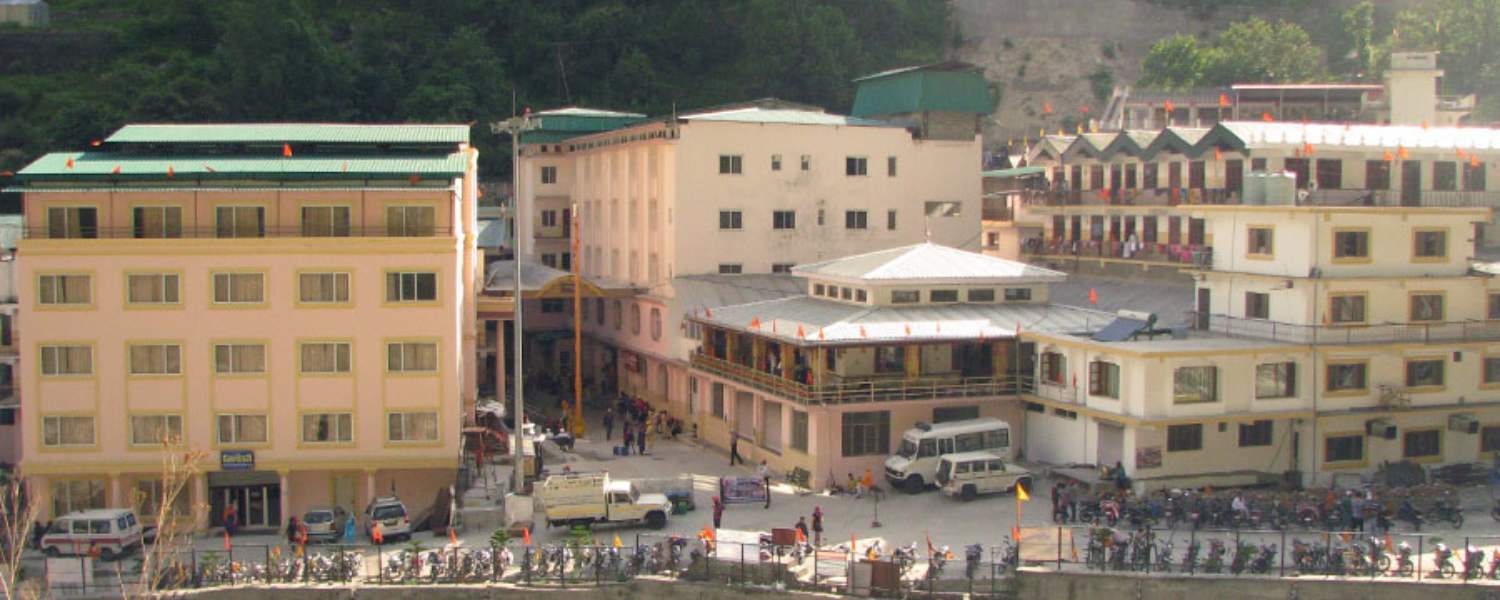
When planning a pilgrimage, it’s essential to understand the accommodation options available to ensure a comfortable and convenient journey.
While the shrine’s religious significance draws devotees from far and wide, due to its elevated location, staying overnight directly at the shrine is not permitted.
However, travelers can find suitable accommodation in the nearby area of Ghagaria, situated 2.2 kilometers behind.
Ghagaria serves as a hub for pilgrims, offering a range of lodging facilities to suit various preferences and budgets.
From simple guesthouses to more luxurious options, there’s something to accommodate every pilgrim’s needs.
Additionally, visitors will find a selection of restaurants and food joints in Ghagaria, providing nourishment after a long day of trekking and spiritual exploration.
While the journey focuses on the sacred site of Ghagaria, it delivers a practical base for travelers to rest and rejuvenate before continuing their pilgrimage.
With its proximity to the shrine and amenities catering to pilgrims, Ghagaria ensures that lodging arrangements do not distract devotees from their spiritual journey.
Plan your visit confidently, knowing that comfortable lodging options await you in Ghagaria, just a short distance from the revered shrine.
10. Things to Carry on Hemkund Sahib
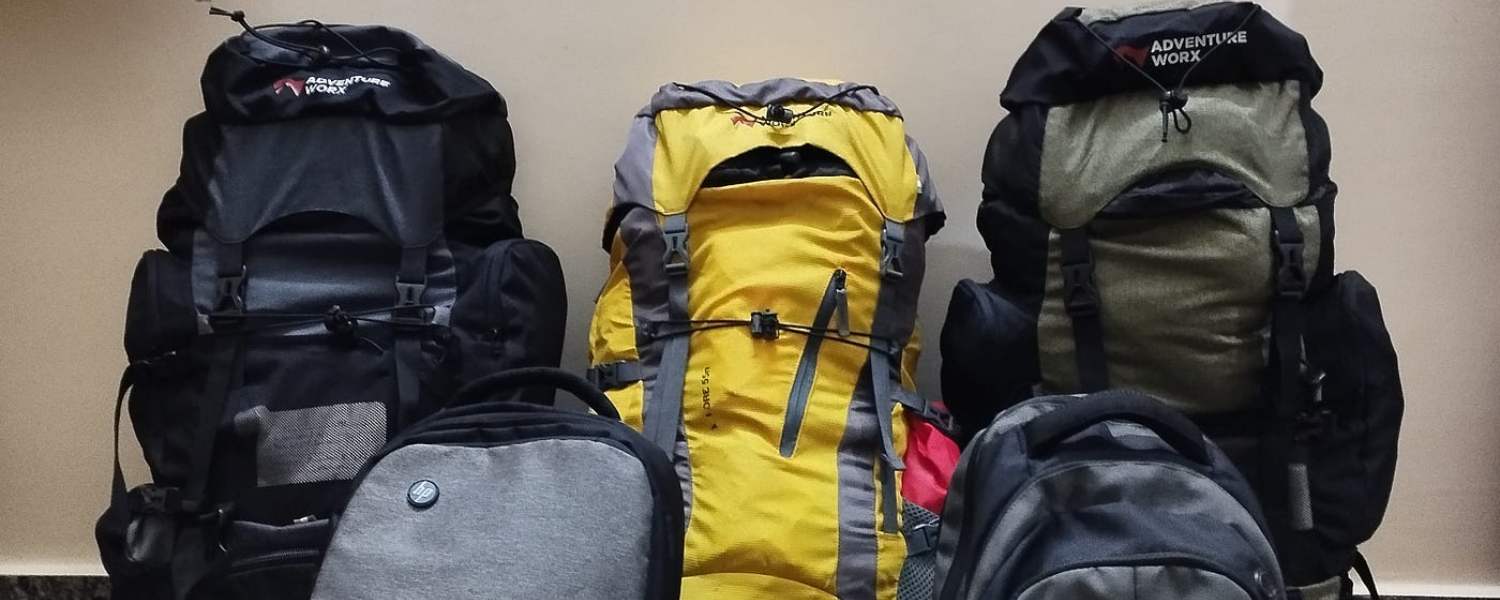
A revered Sikh pilgrimage site demands careful consideration when packing.
Pack essentials tailored to the challenging terrain and varying weather conditions as you embark on this spiritual and adventurous journey.
First and foremost, prioritize clothing.
Pack more than you anticipate needing, especially woolen garments to combat the chilly mountain air.
Consider including a waterproof jacket and rain pants to shield yourself from unexpected showers.
Additionally, carry a hat, gloves, and warm socks to stay snug during your trek.
It’s advisable to dress lightly as you commence your journey from Gobind Ghat, saving your warm, dry attire for when you reach Gobind Dham.
Remember to pack other essentials besides clothing, such as a sturdy pair of trekking shoes, a backpack to carry your belongings, sunscreen, and a first-aid kit.
Stay hydrated throughout your trek with an adequate water supply and energy-rich snacks.
By packing smartly and focusing on the essentials, you can ensure a comfortable and fulfilling pilgrimage
where spirituality intertwines with nature’s grandeur amidst the majestic Himalayas.
11. Hemkund Sahib Trek Difficulty Level
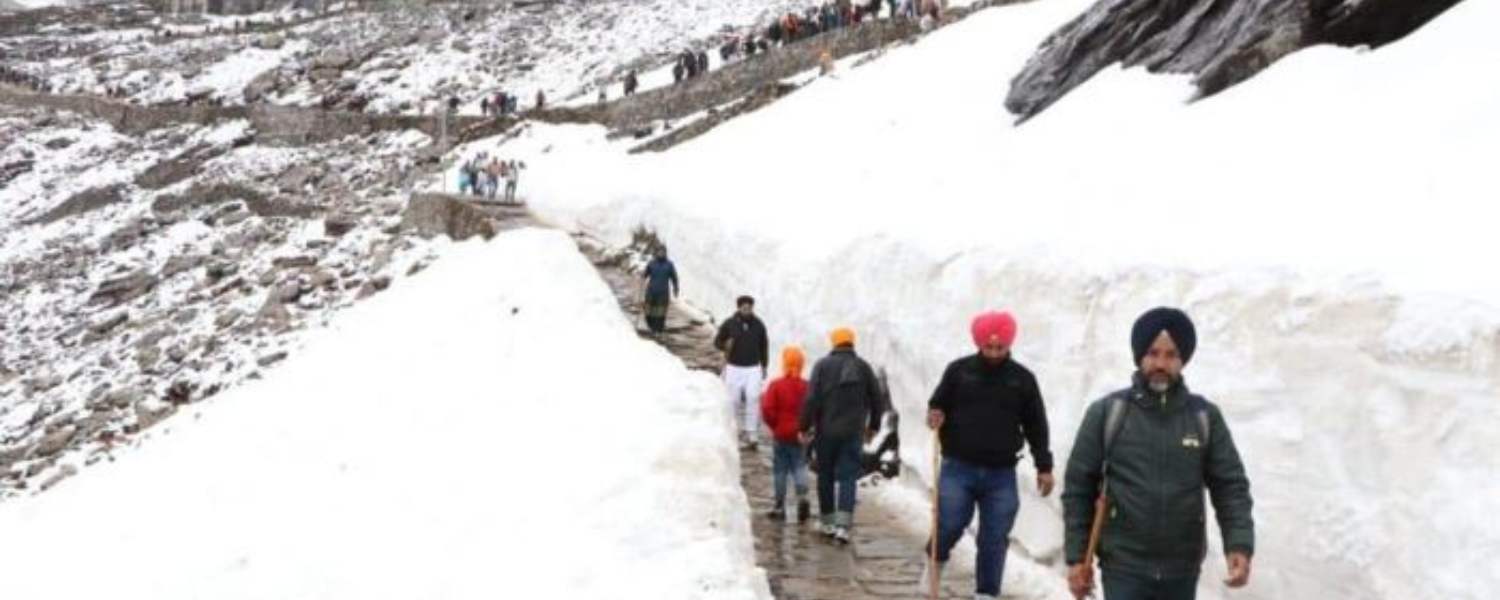
It is a revered Sikh pilgrimage site with the pristine beauty of the Himalayas.
The trek spans approximately 10 kilometers, winding through breathtaking landscapes that will leave you in awe.
Starting from Govindghat, the trail meanders alongside the majestic Alaknanda River, offering serene vistas of lush greenery and cascading waterfalls.
After traversing through picturesque valleys and quaint villages, trekkers arrive at Pulna, a charming town that begins the ascent.
Despite its challenging terrain, the trek is considered moderate in difficulty, making it accessible to novice and seasoned trekkers.
The well-defined path and gradual inclines ensure a manageable journey, allowing ample time to immerse oneself in the natural splendor and spiritual aura.
While the trek typically takes 1-2 days to complete, trekkers are encouraged to pace themselves and embrace the tranquility of the mountains.
At over 15,000 feet, it rewards adventurers with its serene ambiance and panoramic views of snow peaks .
Whether seeking spiritual enlightenment or escaping nature’s embrace, the trek promises an enriching experience of wonder and discovery.
So, lace up your boots, pack your essentials, and embark on a lifetime journey to this sacred sanctuary in the heart of the Himalayas.
In conclusion, A beacon of spiritual significance and natural beauty nestled within the serene landscapes of the Himalayas.
As pilgrims embark on the arduous journey to this sacred site, they are met with the physical challenges of the rugged terrain and the profound sense of peace and enlightenment that permeates the atmosphere.
With its glistening lake and revered Gurudwara, is a testament to Sikhism’s enduring devotion and the universal quest for spiritual fulfillment.
Surrounded by majestic peaks and lush greenery, this divine destination offers a sanctuary for introspection and reverence, inviting visitors to connect with the sacred and themselves.
The journey is not merely a physical expedition but a transformative pilgrimage that marks the hearts and souls of all who tread its sacred paths..
Reaffirming this hallowed sanctuary’s timeless allure and profound significance.
Q. What is famous about Hemkund Sahib?
Hemkund Sahib, a revered Sikh pilgrimage site nestled in the Himalayas, is renowned for its spiritual significance and breathtaking natural beauty. Situated at over 15,000 feet, it holds immense religious importance, as where Guru Gobind Singh Ji, the tenth Sikh Guru, meditated in his previous life. The serene glacial lake, surrounded by seven towering peaks, adds to its allure, drawing devotees and trekkers across the globe.
Q. How high is Hemkund Sahib in feet?
It is one of the highest gurudwaras in the world, standing at approximately 15,200 feet above sea level. Its lofty location amidst the Himalayan ranges contributes to its majestic and awe-inspiring ambiance.
Q. Is Hemkund Sahib trek easy?
While the journey presents challenges, it’s a rewarding experience for those seeking adventure and spiritual solace. The trek, spanning around 6-7 kilometers from Govindghat, involves steep ascents and rugged terrain, demanding moderate fitness. However, the breathtaking vistas of alpine meadows, cascading waterfalls, and snow-capped peaks along the way make the effort worthwhile.
Q. Can we stay at night in Hemkund Sahib?
Yes, accommodation is available for pilgrims and trekkers who wish to spend the night. The Gurudwara Management Committee provides visitors with basic dormitory-style accommodation and langar (community kitchen) facilities. It’s advisable to carry appropriate gear for cold weather conditions, as the temperature can drop significantly at night in this high-altitude region.
Leave a Reply Cancel reply
Your email address will not be published. Required fields are marked *
Save my name, email, and website in this browser for the next time I comment.
Are you looking for help in planning your trip?
Recent posts.

Subscribe and follow
Please go to the Instagram Feed settings page to create a feed.
- Airports (3)
- Archaeological (4)
- Beaches (10)
- Beautiful Places (13)
- Central India (11)
- Cities (17)
- Clothes (1)
- East India (8)
- Heritage Sites (3)
- Hill Stations (11)
- HISTORICAL (14)
- Historical Places (8)
- hotels (12)
- Islands (3)
- MAGICAL PLACES (1)
- Monuments (21)
- Mountains (17)
- North India (33)
- PARAGLIDING (2)
- Places to Visit (52)
- railway station (2)
- Resorts (14)
- Restaurants (5)
- ROAD TRIPS (1)
- Shopping Mall (6)
- South India (51)
- Temples (32)
- Tourist Spots (20)
- TREKKING (5)
- Uncategorized (2)
- UNEXPLORED (15)
- Water Park (7)
- WATER SPORTS (1)
- Waterfalls (18)
- West India (24)
- WILDLIFE TOURS (3)
Recent Comments
- Exploring the Authentic Flavors of Best Dishes in India April 9, 2024
- Discovering the Treasures and Iconic Monuments of Karnataka April 9, 2024
- 23 Top-Rated Attractions & Places to Visit in Jaipur April 9, 2024
Your message (optional)

(c) 2022 Special Places Of India All rights reserved
- Magical Places
- Privacy Policy
Special Places of India is an online blogging website that welcomes travelers, professionals and other readers to read their blogs.
Demo Description
This will close in 220 seconds

- Treks in Himachal Pradesh
- Treks in Uttarakhand
- Treks in Sikkim
- Treks In Jammu & Kashmir
- Uttarakhand
- Himachal Pradesh

Hemkund Sahib Trek Guide 2024: History, Highlights, How to Reach and Itinerary
Table of Contents
The high altitude Lokpal lake, known as Hemkund ( 4329 mts.) lies in the glorious vicinity. An extreme Hemkund Sahib trek from Ghangaria leads one to this spot in about four to six hours. It is an important pilgrimage for both Hindus and Sikhs, as well as for people from other faiths.
There is a Sikh Gurudwara and a Lakshman temple built on the bank of the lake. Encircled by seven snow clad peaks and their associated glaciers, it reflects its surroundings enchantingly on its crystal clear serene waters. The glaciers from Hathi Parvat and Saptrishi peaks feed the lake and a small stream called Himganga flows out of this lake.
Take a bath of hues with Hemkund trekking. The valley of flowers at Hemkund slowly hypnotizes you into the world of colors and hues. This place has numerous reasons to visit. Despite being a long journey this place gives you thousands of reasons to keep yourself energized and enriched.
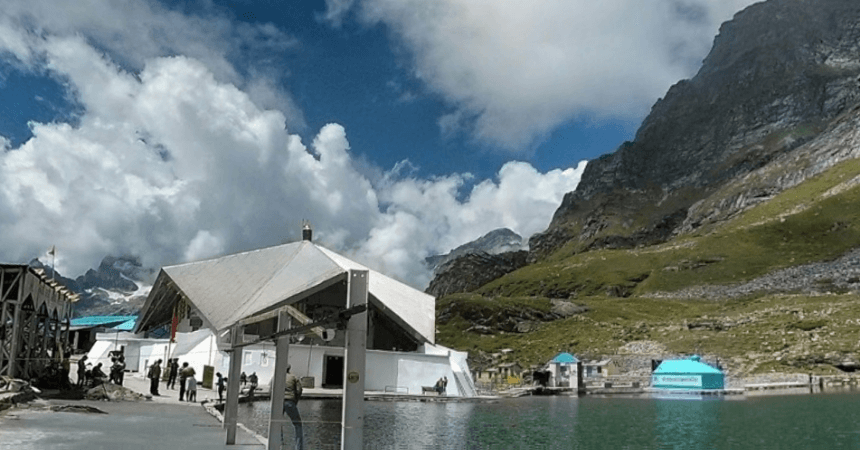
The still mountains and ever flowing river Pushpawati takes you into the world of solace and tranquility. This exceptionally rich destination also gives you the chance to spend a little time on the lap of nature while witnessing the diverse forms of flora.
The trekking route is very interesting if you are on your way to Hemkund. The route starts from Haridwar to Joshimath. The route has so much to offer. After starting your journey from here you have to trek to the Ghangaria. Ghangaria is the base camp for reaching Hemkund Sahib and the valley of flowers.
Throughout the trip from Govind Ghat to Ghangaria, you will have the river as your companion. You can spend your night over here and prepare your journey for the next day towards the valley of flowers. The nightlife of Ghangaria gives you the opportunity to listen to each breath of yours.
History of Hemkund Sahib Trek
Hemkund Sahib (also spelled Hemkunt), formally known as Gurudwara Shri Hemkund Sahib Ji , is a Sikh place of worship and pilgrimage site in Chamoli district , Uttarakhand , India .
It is devoted to Guru Gobind Singh (1666–1708), the tenth Sikh Guru, and finds mention in Dasam Granth , a work presumed to be dictated by Guruji himself, where mythological components exist in the work. With its setting of a glacial lake surrounded by seven mountain peaks, each adorned by a Nishan Sahib on its cliff.
Before the great Sikh’s arrival at this place, the place was known among the Hindu pilgrims. The place was renowned as Lokpal Lake. The lake was named after Hindu Lord Vishnu. Lakshman, the brother of Lord Rama, after facing an injury from Ravana’s son, came here for herbal treatment.
There is another myth regarding Lakshman’s previous birth in the form of seven headed snakes. The snake, known as Sheshnag went for penances for Lord Shiva. Lord Vishnu seated on the snake in that penance. For the name of Lord Vishnu, the lake has been named Lokpal. You will hear these myths from the local people and the faith you will find in them will continue the astonishment you gained from natural beauty.
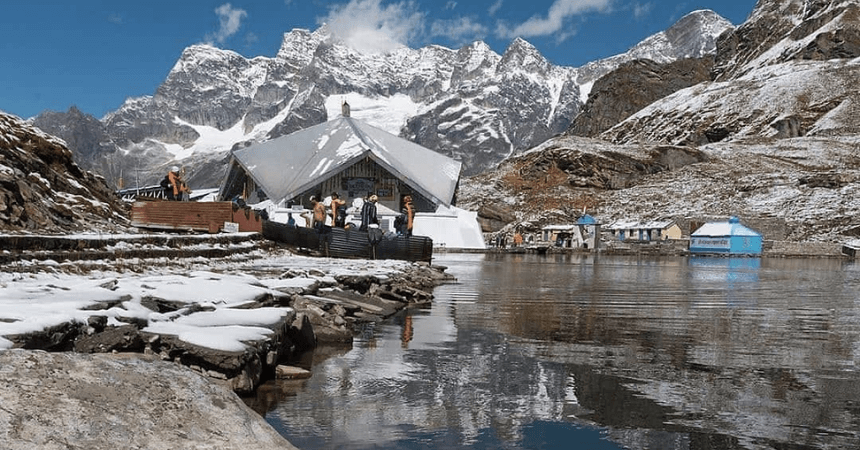
Highlights of Hemkund Sahib Trek
- View the spectacular confluences of Rivers at Devprayag, Karnprayag and Rudraprayag.
- Get the mesmeric view of the high snow-clad mountains like Saptashringa Peaks.
- Witness the high altitude Sikh Shrine, Hemkund Sahib.
- Enjoy trekking on a beautiful trail from Ghangaria to Hemkund.
- Witness the beauty of the remote villages.
Location of Hemkund Sahib Trek
Hemkund Sahib (also spelled Hemkunt Sahib) Situated at a height of over 15,000 feet above the sea level in the Himalayan ranges of northern India, is a Sikh place of worship and pilgrimage site in Chamoli district, Uttarakhand, India.
With its setting of a glacial lake surrounded by seven mountain peaks, each adorned by a Nishan Sahib on its cliff, it is according to the Survey of India, located in the Himalayas at an elevation of 4,632 meters (15,197 feet). It is approached from Govindghat on the Rishikesh-Badrinath highway. The main town near Govindghat is Joshimath.
Best Time to Visit Hemkund Sahib Trek
Hemkund Sahib has a cool climate in most parts of the year and the best time to visit is from May to October.
Summers (May to October) have pleasant cool weather with maximum temperature reaching nearly 25°C. It is a good season for viewing the panoramic beauty.
Winters (November to May) are snow covered and it is difficult to visit the outdoor attractions. Minimum temperature can go well down with an average minimum about -4°C.
June to October is pleasant and ideal for the pilgrimage and also for the visit of the national park. August and September are eye-catching months with blooming flowers. December to May is snow bound and road blocks prevent the tourist from visiting the outdoors.
How to Reach Hemkund Sahib Trek
Jolly Grant Airport is the nearest airport to Hemkund Sahib but the roads are only connected up to Govind Ghat from where you have to commence a trek of 19kms to reach Hemkund Sahib. Govindghat is situated at a distance of 292kms from Jolly Grant Airport.
Jolly Grant Airport is well connected to Delhi with daily flights and Govindghat is well connected by motorable roads with Jolly Grant Airport. Taxis are available from Jolly Grant Airport to Govindghat.
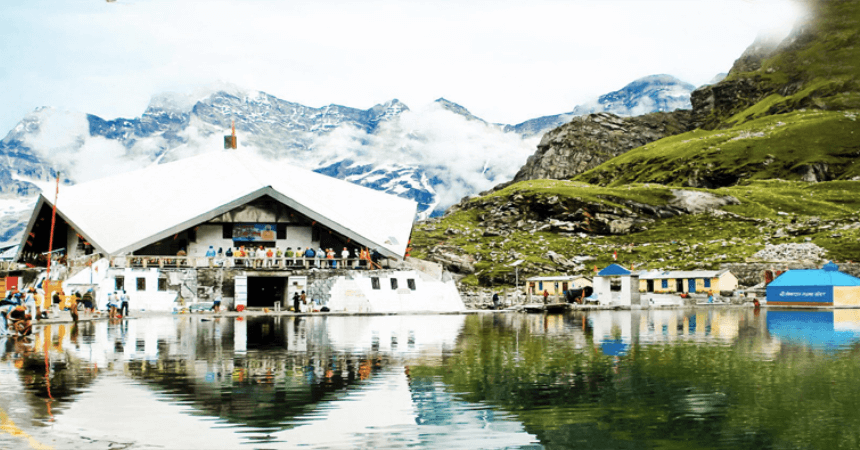
The nearest railway station to HemkundSahib is Rishikesh. Rishikesh railway station is situated 273 km before Govindghat on NH58. It is well connected by railway networks with major destinations of India and trains to Rishikesh are frequent.
Taxis and buses are available from Rishikesh, Srinagar, Rudraprayag, Chamoli, Joshimath and many other destinations to Govindghat.
Hemkund Sahib is connected up to Govind Ghat with motorable roads and from here you have to commence a trek of 19kms to reach HemkundSahib. Govindghat is well connected by motorable roads with major destinations of Uttarakhand state. Buses to Haridwar, Rishikesh and Srinagar are available from ISBT Kashmiri Gate.
Buses and Taxis to Govindghat are easily available from major destinations of Uttarakhand state like Rishikesh, Pauri, Rudraprayag, Karnaprayag, Ukhimath, Srinagar, Chamoli etc. Govindghat is situated on National Highway – 58 making it easy to reach.
Hemkund Sahib Trek Itinerary
Day 01: delhi – haridwar – rishikesh.
In the morning take an AC train for Haridwar at 06:50 AM from New Delhi train station. Arrival at Haridwar by 1:25 PM. Here meet our guide and transfer to Rishikesh, check into your hotel. Evening time is free for leisure activities. Overnight stay at the hotel.
Day 02: Rishikesh – Karnprayag – Joshimath (Driving Distance 245 Kms)
After having a wholesome breakfast, drive towards Joshimath (1874 meters /245Kilometrs) via Devprayag (confluence of Alaknanda and Bhagirathi River, from here the holy Ganges starts), Rudraprayag, Karnprayag and Chamoli. Have lunch on the way. After reaching Joshimath, check-in at the hotel. Enjoy a hearty dinner and stay for the night.
Read more: Panpatia Col Trek
Day 03: Joshimath – Govindghat (18 Kms by road) – Ghangaria (Trek 13 Kms/5 hrs)
After having breakfast, head towards Govindghat (1828metres/22 Kms). Today, start your trek to Ghangaria (14 kms/3049 meters) through Bhyundar Valley and Pulna village. This destination is going to be the base camp for that head towards visiting HemkundSahib and Valley of Flowers.
Day 04: Ghangaria – Hemkund- Ghangaria Trek 6 KM
Today, start the trail in the morning and hike for (6 Kms) to visit the “Hemkund Sahib”. It is a famous Sikh pilgrimage destination. At noon, trek downwards to reach Ghangaria and stay there for the night. The evening time is free and you can utilize this time to explore the stunning surroundings and for getting some rest.
Day 05: Ghangaria
You can visit to explore the Valley of Flowers. The entire picturesque valley is speckled with varied flora, fauna and other plant types. After spending some time in this spectacular picturesque valley turn to Ghangaria for a night stay.
Day 06: Ghangria – Govindghat (Trek 14 Kms) – Rudraprayag (Drive 148 kms)
In the morning begin your return trail to Govindghat. From here, drive towards Rudraprayag through Karanprayag & Joshimath. Once you arrive at this place, check into the hotel. Stay at the hotel for the night.
Day 07: Rudraprayag – Rishikesh – Delhi
It is the last day of our tour. On this day after having an early breakfast, drive back to Haridwar and from there catch the evening Shatabdi train for Delhi at 06:05 PM. Arrival at Delhi.
Frequently Asked Questions (FAQ’s) for Hemkund Sahib Trek
What is the best time to visit hemkund sahib.
Hemkund Sahib pilgrimage is open for only 4 months, from June until October for tourists. Therefore, these four months are the best time to visit Hemkund Sahib. Because of the high altitude location, heavy rainfall is very common in Hemkunt Sahib area. Therefore, check the weather conditions before you start the trek to Hemkunt Sahib.
What are nearby places one can go from Hemkund Sahib?
There are several places to visit nearby in HemkundSahib like Valley of Flowers, Badrinath and much more.
How long is Hemkund Sahib trek?
The trek of Hemkund Sahib lasts for 7 days.
Where is Hemkund Sahib Trek located?
Hemkund Sahib is located in the chamoli district of Uttarakhand
Is Hemkund Sahib trek difficult?
This high altitude trek to Hemkund Sahib has an easy level of difficulty.
Where does Hemkund Sahib trek start and end?
The Hemkund trek starts and ends at delhi.
- Share This Post:
Related Articles
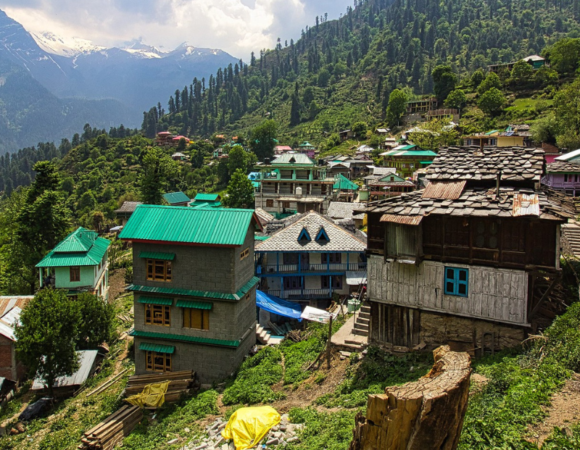
10 Best Hill Station In Himachal Pradesh, Highlights, FAQ’s
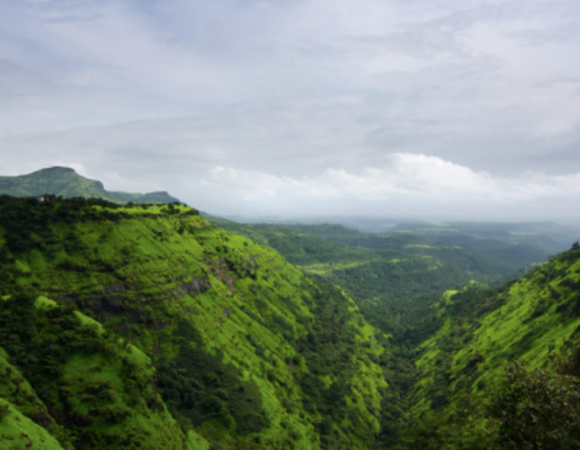
10 Best Hill Stations In Maharashtra, Highlights & FAQ’s
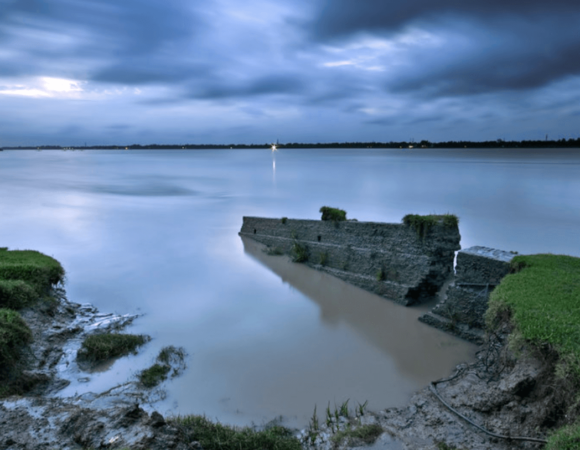
10 Best Hill Stations In West Bengal – Best Time, How to Reach Highlights & FAQs
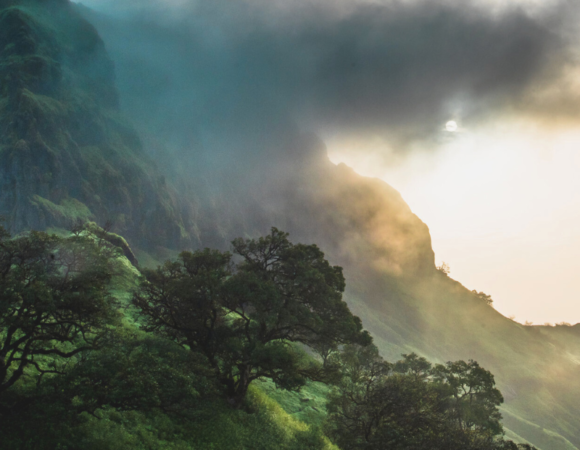
10 Best Maharashtra Trekking Places, Highlights, Treks & FAQ’s
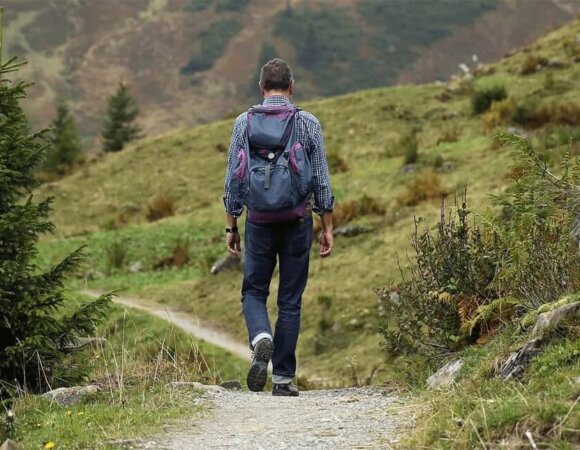
10 Best Trekking Places Near Delhi In 2024 & FAQ’s

10 Best Treks in Himachal That You Can Do in Winters
One thought on “hemkund sahib trek guide 2024: history, highlights, how to reach and itinerary”.
[…] Read more: Hemkund Sahib […]
Add a Comment Cancel reply
Save my name, email, and website in this browser for the next time I comment.
Things To Carry On Your Trek
Book your experience with us.
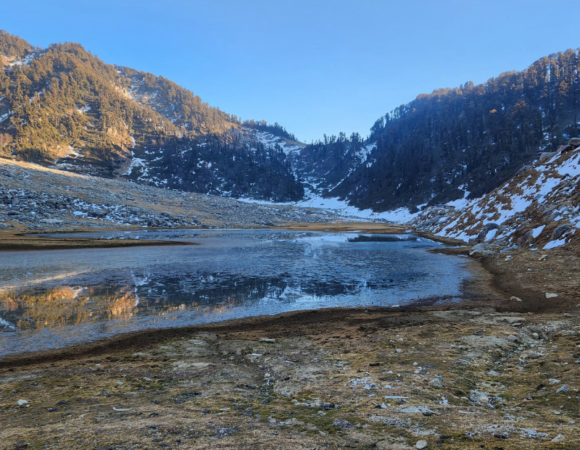
- Amenities 5
Kareri Lake Trek
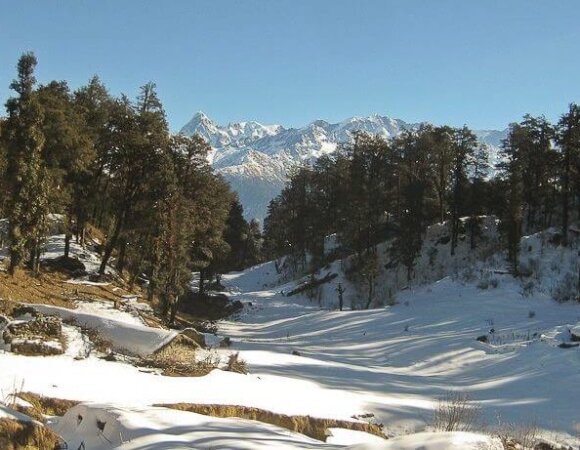
Dayara Bugyal Trek
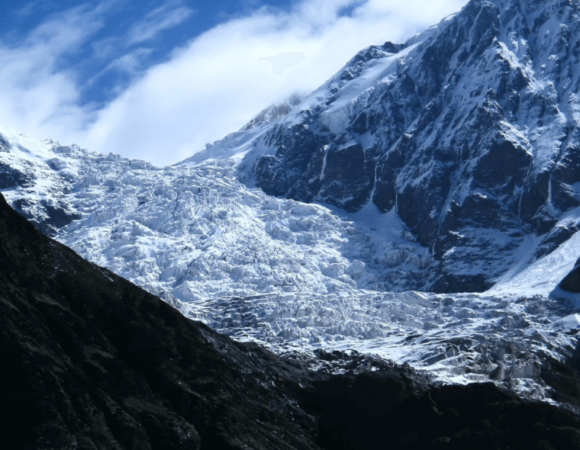
Pindari Glacier Trek

Snowline Trek
Book your unforgettable experience with us, reset password.
WhatsApp Us
- More Networks
Discover, Explore, and Embark on Extraordinary Journeys

- Uttarakhand
Hemkund Sahib Trek: A Spiritual Journey through the Himalayas

Unveiling the Mystique of Hemkund Sahib Trek: Your Comprehensive Guide
The Himalayas, shrouded in mystique and serenity, have been a beacon for spiritual seekers and trekkers alike. Nestled high in the Garhwal region of Uttarakhand, Hemkund Sahib is a revered destination that seamlessly blends spirituality with adventure. In this guide, we’ll embark on a virtual journey to explore everything you need to know about the Hemkund Sahib trek, from its breathtaking altitude to its spiritual significance.

Hemkund Sahib Pilgrimage: A Divine Odyssey
At an awe-inspiring altitude of 4,632 meters above sea level, Hemkund Sahib Trek is one of the highest Gurudwaras in the world. The pilgrimage to Hemkund Sahib is not just a trek; it’s a spiritual odyssey. Devotees from all corners of the globe flock here to seek blessings and solace.
The journey begins with a deep sense of purpose. Pilgrims arrive at the base town of Govindghat, a scenic spot on the banks of the Alaknanda River. From here, it’s a trek of approximately 13 kilometers to reach the sacred shrine. The path takes you through dense forests, charming villages, and gushing streams. It’s not just a physical journey; it’s a journey of the soul.
Hemkund Sahib Trekking Guide:
Trekking to Hemkund Sahib requires meticulous planning. It’s not your average trek; it’s a high-altitude adventure that demands respect for nature and careful preparation.
Gear Up: The first step is to ensure you have the right gear. Sturdy trekking shoes, warm clothing, rain gear, and a good backpack are essential. You’ll also need a trekking permit, which you can obtain in Govindghat.
Acclimatization: At such high altitudes, acclimatization is crucial. Spend a day in Govindghat to allow your body to adjust to the thinner air. Stay hydrated and avoid overexertion.
Fitness Matters: Trekking to Hemkund Sahib is physically demanding. Regular exercise and cardio workouts in the weeks leading up to your trip will help you cope with the altitude.
Pack Light: Remember, you have to carry your backpack. Pack only the essentials, and keep it as light as possible.

Hemkund Sahib Altitude: A Glimpse of the Sky
Hemkund Sahib’s staggering altitude is not for the faint-hearted. At 4,632 meters, the air becomes thin, and oxygen levels drop. This can lead to altitude sickness if you’re not adequately prepared.
The high altitude offers breathtaking views of the surrounding peaks. As you ascend, you’ll notice the landscape changing. Lush forests give way to alpine meadows adorned with colorful flowers. It’s a journey through diverse ecosystems, each more enchanting than the last.
Hemkund Sahib Trek Distance: Every Step Counts
The journey to Hemkund Sahib is as much about the destination as it is about the path. The 13-kilometer trek from Govindghat is not just a means to an end; it’s an experience in itself.
As you hike, you’ll come across picturesque villages like Pulna and Bhyundar. You’ll traverse narrow bridges over bubbling streams and walk through dense forests. The path is dotted with small dhabas (eateries) where you can savor local snacks and rejuvenate with a hot cup of tea.

Best Time for Hemkund Sahib Trek: Seasons of Serenity
Timing is everything when it comes to trekking in the Himalayas. Uncover the best time to embark on your Hemkund Sahib adventure and witness nature’s grandeur at its peak.
The trekking season typically runs from May to October. During this period, the weather is relatively stable, and the trails are accessible. The summer months of June to September are the best for witnessing the Valley of Flowers in full bloom, a celestial experience.
However, monsoon rains can make the trails slippery and challenging. May and October are considered the shoulder seasons, offering a balance between good weather and fewer crowds. Winters are harsh, with heavy snowfall rendering the route impassable.
Hemkund Sahib Trek Itinerary: Mapping Your Spiritual Sojourn
A well-planned itinerary ensures you don’t miss out on the wonders en route to Hemkund Sahib. We provide you with a day-by-day breakdown of this unforgettable journey.
Day 1: Arrival in Govindghat
- Arrive in Govindghat, the starting point of your trek.
- Acclimatize and explore the charming town.
Day 2: Govindghat to Ghangaria
- Begin your trek to Ghangaria, a picturesque village.
- En route, pass through villages like Pulna and Bhyundar.
- Reach Ghangaria, your base for the Hemkund Sahib trek.
Day 3: Hemkund Sahib
- Embark on the trek to Hemkund Sahib.
- Explore the Gurudwara and the pristine lake.
- Return to Ghangaria for an overnight stay.
Day 4: Valley of Flowers
- Visit the enchanting Valley of Flowers.
- Explore the meadows and vibrant flora.
- Return to Ghangaria for the night.
Day 5: Return to Govindghat
- Descend from Ghangaria to Govindghat.
- Your trek concludes here.
Hemkund Sahib Route Map
Navigation is key in the wilderness. We present a detailed route map to guide you through the trails leading to Hemkund Sahib.
The trek from Govindghat to Hemkund Sahib is a well-marked trail. You’ll follow the course of the Pushpawati River, crossing it several times on sturdy bridges. The path is lined with dense forests and alpine meadows, offering stunning vistas at every turn.
After reaching Ghangaria, the path to Hemkund Sahib is a steep ascent. It’s a challenging climb, but the spiritual energy and natural beauty around you will keep you motivated.
Hemkund Sahib Trekking Package: Hassle-Free Pilgrimage
For those seeking convenience, trekking packages are a blessing. Explore the options available to make your pilgrimage as smooth as possible.
Trekking packages for Hemkund Sahib often include transportation from major cities like Haridwar or Rishikesh to Govindghat, accommodation in Govindghat and Ghangaria, meals, permits, and a guide. This takes the stress out of planning and ensures you have everything you need for a successful trek.

Hemkund Sahib Opening Date
The gates of Hemkund Sahib don’t remain open year-round. Know when to plan your visit to ensure you don’t miss out on this spiritual opportunity.
Hemkund Sahib typically opens in May or early June, depending on when the snow clears from the trekking path. The closing date is usually in October before the onset of heavy snowfall. It’s essential to check the exact dates for the year you plan to visit.
Hemkund Sahib Closing Date: Timing Your Descent
Just as the portal opens, it also closes. Discover when it’s time to bid adieu to Hemkund Sahib and descend from the heavens.
As the closing date approaches, the number of visitors decreases, and the weather becomes more unpredictable. It’s advisable to plan your trek in the earlier part of the season to avoid any last-minute changes in weather conditions.
Hemkund Sahib Solo Trek:
Venturing alone into the Himalayas is a transformative experience. Learn about the challenges and rewards of a solo trek to Hemkund Sahib.
Solo trekking to Hemkund Sahib is entirely possible, but it comes with unique challenges. You must be self-reliant, physically fit, and mentally prepared. It’s a journey of self-discovery, where solitude becomes your companion, and nature your confidant.
Hemkund Sahib Group Trek: Camaraderie in the Mountains
For those who prefer company, group treks offer a sense of camaraderie. Explore the advantages of trekking to Hemkund Sahib with fellow seekers.
Group treks provide a supportive environment where you can share the challenges and triumphs of the journey with like-minded individuals. It’s an opportunity to forge new friendships and create lasting memories.
Pilgrimage and Spiritual Aspects: Beyond the Trek
Hemkund Sahib isn’t just about the trek; it’s a holistic experience. Delve into the spiritual and historical aspects of this revered Gurudwara.
Hemkund Sahib Yatra: A Spiritual Sojourn
The yatra (journey) to Hemkund Sahib is a profound experience. Understand the significance and rituals associated with this sacred pilgrimage.
Pilgrims undertake the Hemkund Sahib yatra with deep reverence. It’s a spiritual journey that involves reciting prayers, taking a dip in the sacred lake, and seeking blessings from the Guru Granth Sahib.
Hemkund Sahib Gurdwara: Where Faith Meets the Mountains
The Hemkund Sahib Gurdwara is a spiritual oasis in the Himalayas. Explore its history, architecture, and the heartwarming langar (community meal) tradition.
The Gurdwara stands in stark contrast to the rugged mountain terrain. Its white marble structure exudes serenity and invites weary travelers to find solace within its walls. The langar, a free community kitchen, serves simple yet delicious meals to all visitors, fostering a sense of equality and brotherhood.
Hemkund Sahib History: Tracing the Footsteps of the Past
Unearth the historical significance of Hemkund Sahib and the legends that surround this sacred place.
Hemkund Sahib has deep historical roots. It is believed to be associated with Guru Gobind Singh, the tenth Sikh Guru, who is said to have meditated here. The legend of Hemkund Sahib is entwined with the valor and sacrifice of Sikh warriors.
Hemkund Sahib Spiritual Journey: Inner Transformation
Trekking to Hemkund Sahib is not just a physical journey; it’s a spiritual awakening. Discover the profound impact it can have on your soul.
The serene ambiance, the rhythmic chants, and the pristine surroundings create an atmosphere conducive to introspection and inner peace. Many pilgrims attest to the transformative power of their journey to Hemkund Sahib, leaving with a renewed sense of purpose and spirituality.
Hemkund Sahib Food: Nourishment for the Body and Soul
Feasting at high altitudes is a unique experience. Learn about the simple yet delicious meals served at Hemkund Sahib’s langar and their spiritual significance.
The langar at Hemkund Sahib serves vegetarian meals prepared with love and devotion. It’s not just about nourishing the body but also the soul. Sharing a meal with fellow pilgrims fosters a sense of unity and equality, transcending boundaries and differences.
Weather and Conditions: Nature’s Whims
The Himalayan weather can be unpredictable. Prepare for your trek by understanding the weather patterns and conditions you might encounter.
The weather in the Himalayas can change rapidly. Even during the trekking season, you may encounter rain, snow, or bright sunshine. It’s essential to dress in layers, carry rain gear, and be prepared for sudden changes in temperature.
Accommodation and Travelogue: Resting Amidst the Clouds
Find out about the accommodation options available during your Hemkund Sahib journey, from Gurudwara dormitories to nearby guesthouses.
Accommodation options in Hemkund Sahib are limited but sufficient. The Gurudwara provides dormitory-style lodging free of cost. However, these spaces can fill up quickly during the peak season, so it’s advisable to arrive early.
Visuals and Photography: Capturing the Divine
Explore breathtaking visuals and photography from Hemkund Sahib, showcasing its ethereal beauty.
The Himalayas offer a photographer’s paradise. From snow-capped peaks to colorful meadows, every frame is a work of art. The divine aura of Hemkund Sahib is beautifully captured through the lenses of those who have visited.
Valley of Flowers: Nature’s Color Palette
If Hemkund Sahib is the spiritual zenith, the Valley of Flowers is the natural paradise. Discover the enchanting beauty of this UNESCO World Heritage Site.
The Valley of Flowers, located nearby, is a botanical wonderland. It’s a UNESCO World Heritage Site known for its rich biodiversity and stunning floral displays. Visiting the valley is like stepping into a canvas painted with nature’s vibrant colors.
Travel Tips: Navigating the Spiritual Terrain
Before you set off on your Hemkund Sahib trek, heed these essential travel tips to ensure a safe and fulfilling journey.
- Respect the Environment: Leave no trace. Carry your trash with you and follow responsible trekking practices to preserve the natural beauty.
- Stay Hydrated: At high altitudes, it’s easy to get dehydrated. Drink plenty of water and avoid alcohol and tobacco.
- Pack Essentials: Aside from trekking gear, carry essentials like a first-aid kit, sunscreen, insect repellent, and a power bank for your devices.
- Follow the Trail: Stick to marked trails to avoid getting lost. If you’re unsure, hire a local guide.
- Respect Local Culture: Be mindful of the local customs and traditions. Dress modestly, especially near religious sites.
Now that you’re armed with the knowledge of Hemkund Sahib from every angle, it’s time to embark on this spiritual
Hemkund Sahib, perched high in the Himalayas, is a destination that resonates with spirituality and adventure. As you plan your pilgrimage or trek, remember that this journey is not just about the destination; it’s about the path and the profound experiences that await you.
About Author
See author's posts
More Stories
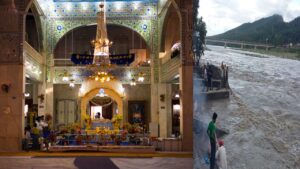
- Himachal Pradesh
Paonta Sahib Bus Stand Time Table, Route,Stopage
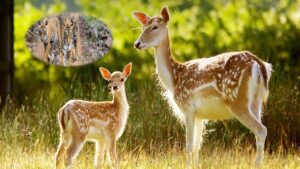
Top 7 National Parks in South India: Tickets, Photo
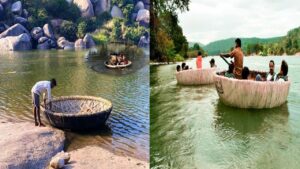
The Thrill of Coracle Ride Hogenakkal:Ticket,Price,Photos
Leave a reply cancel reply.
Your email address will not be published. Required fields are marked *
Save my name, email, and website in this browser for the next time I comment.
You may have missed

9 Resorts in Alibaug: Online Booking, Accommodation, Price
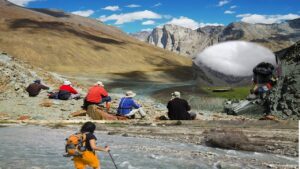
Top 10 Incredible Treks in India to Visit for Adventure

Online Cat food: Price, Brand and Review

VV Puram Food Street:Menu with Price Per shop, Timing

- Lakshadweep
Lakshadweep Airport – Flight Timings, City and Airlines

Dharamshala Himachal Pradesh
- + 9858308506
Hemkund Sahib Trek Tour
Hemkund sahib trek booking, hostel stay in mcleodganj @500, 100% guaranteed triund top camping.
10 Years Experience
Specialized in Triund Camping
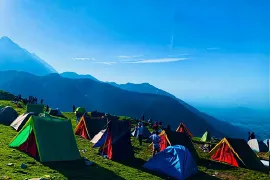
Dharamkot Road
Near Gandhi's Paradise
700 Meters from Main Square
Mcleodganj, Himachal Pradesh
Hemkund Sahib Trek: A Spiritual Odyssey amidst the Himalayas
1. introduction.
The Hemkund Sahib Trek is a sacred pilgrimage nestled in the lap of the Himalayas. It leads devotees to the revered Hemkund Sahib Gurudwara, a high-altitude Sikh shrine surrounded by stunning landscapes. This spiritual journey is a harmonious blend of faith, nature, and tranquility.
2. Starting Point - Govindghat
Govindghat: Serving as the starting point, the trek commences from Govindghat, a small town on the banks of the Alaknanda River. Pilgrims begin their ascent from here, venturing into the breathtaking landscapes of the Garhwal region.
3. Trek Route
The trek unfolds along a well-defined trail that winds through dense forests, charming meadows, and rugged terrain. The journey takes pilgrims along the Pushpavati River, revealing the natural beauty that surrounds the sacred path.
4. Duration and Difficulty
The Hemkund Sahib Trek typically spans around 6 to 7 days, covering a distance of approximately 19 kilometers from Govindghat to Hemkund Sahib. The trek is considered moderately challenging, with steep ascents and high-altitude terrain.
5. Pristine Hemkund Lake
The highlight of the trek is the Hemkund Lake, located at an altitude of over 4,300 meters. Surrounded by snow-clad peaks, the pristine lake is believed to be the meditation site of Guru Gobind Singh, adding to its spiritual significance.
6. Hemkund Sahib Gurudwara
Perched on the shores of Hemkund Lake, the Hemkund Sahib Gurudwara is a tranquil sanctuary. The white-marbled structure against the backdrop of the towering mountains creates a serene and sacred atmosphere for pilgrims.
7. Lush Valley of Flowers
En route, trekkers pass through the Valley of Flowers, a UNESCO World Heritage Site known for its vibrant alpine blooms. The valley transforms into a kaleidoscope of colors during the summer months, offering a breathtaking spectacle to trekkers.
8. Best Time for the Trek
The recommended time for the Hemkund Sahib Trek is from June to October, when the weather is relatively mild, and the landscapes are adorned with blooming flowers. Monsoon months should be approached with caution due to the possibility of heavy rainfall.
9. Gurudwara Hemkund Sahibji Weather Station
Pilgrims often encounter the Hemkund Sahibji Weather Station, which plays a crucial role in monitoring weather conditions in the region. It serves as a reminder of the challenges faced in the high-altitude terrain.
10. Pilgrimage Traditions
Pilgrims participating in the trek engage in traditional Sikh practices, including 'seva' (selfless service) at the Gurudwara. The spirit of community and devotion becomes an integral part of the pilgrimage experience.
11. Responsible Pilgrimage
Pilgrims are encouraged to practice responsible trekking by respecting the fragile ecosystem, adhering to local customs, and ensuring the sanctity of the pilgrimage route. Sustainable practices contribute to the preservation of this sacred environment.
12. Return Journey to Govindghat
After seeking blessings at the Hemkund Sahib Gurudwara and immersing in the spiritual aura of the Himalayas, pilgrims descend back to Govindghat, carrying not just the memories of a trek but a profound spiritual experience etched in the heart of the Garhwal Himalayas.
UTTARAKHAND TREKKING TOURS
Treks in uttarakhand.

TRAVEL TREK
- When you submit your request,
- a Travel Trek expert gives you
- a call to discuss your plans and
- accordingly suggests you an itinerary.
- deals and discounts
+91 9958308506

Get in touch!
- Triund Trek in May
- Terms Conditions
- Privacy Policy
- Bhagsu Waterfall
- Anthargange Trek
- Mcleodganj to Triund
- Tilak Nagar
- Luxury Camping Kasol
- Himachal Tourist Places
- Prashar Lake Trek
- Kalindikhal Pass Trek
- Dzongri Trek
- Kasol Camp Stay
- Bhagsu Nag Temple
- Nanda Devi Trek
- Nahargarh Fort Trek
- Hotel in Dharamshala
- Chadar Lake Trek
- Sar Pass Trek Kasol
- Hotels in Bhagsu
- Hotels in Dharamkot
- Dharamshala Weather
- Triund Altitude
- Best Time to Visit Triund
- Kasol Camping Package
- Rome to Paris
- Adi Kailash
- Valley of Flowers
- Harihar Fort
- Angles Landing Trails
- Triund Trek for Beginners
- Hotels in Mcleodganj
- Camping in Gurgaon
- Leopard Trail Gurgaon
- Hill Station
- Travel by States
- Write For Us
- Need a Writer

- Hemkund Sahib Trek
With Hemkund hiking, you may immerse yourself in a rainbow of colors. Hemkund’s flower valley gradually hypnotizes you into a world of colors and hues. There are several reasons to visit this location. Despite the fact that it is a lengthy journey, this location provides thousands of reasons to be energetic and enlightened. The silent mountains and the ever-flowing river Pushpawati transport you to a realm of peace and serenity. This incredibly diversified site also allows you to spend some time in the lap of nature while admiring the many types of flora.
If you are traveling to Hemkund, the trekking path is quite intriguing. The journey begins in Haridwar and ends at Joshimath. There’s a lot to see and do on this route. You must trek to Ghangaria after commencing your adventure from here. Ghangaria serves as the starting point for visits to Hemkund Sahib and the Valley of Flowers. The river will be your companion during the journey from Govind Ghat to Ghangaria. You can spend the night here and prepare for your trip to the Valley of Flowers the next day. Ghangaria’s nightlife allows you to pay attention to every breath you take.
The drive from Ghangaria to the Valley of Flowers is so gorgeous that you will want to remember it for the rest of your life. The three-thousand-meter-high road provides a beautiful vista of mountains and greenery, with clouds playing hide-and-seek with you as you go. The voyage instills enthusiasm inside you, leading you to a world of colors and happiness. The Valley of Flowers allows you to spend some time in the middle of vibrant hues and a natural garden where you can smell the flowers. After the valley of flowers, you may now prepare for the Hemkund sahib, which is the second hiking destination.
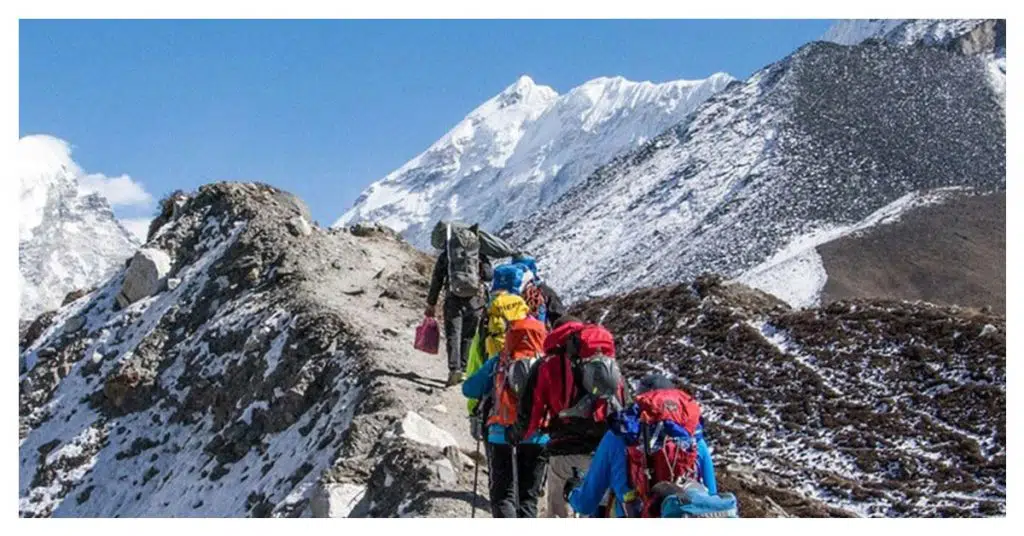
Hemkund Sahib Journey
For Sikhs and Hindus, Hemkud Sahib is a holy site. Every Hindu wants to go on the Chardham yatra at least once in his life, while every Sikh wants to go on the Hemkund yatra at least once. Guru Gobind Singh, the tenth Sikh Guru, is honored at this pilgrimage location. Hemkund is a Sanskrit name that means “Snow Lake” and is formed from the words Hem (Snow) and Kund (bowl). According to Dasam Granth, this is where Pandu Raja performed Yoga. In addition, the Dasam Granth claims that God told Sikh Guru Gobind Singh to bathe while meditating on Hemkund’s mount.
The Hemkund is located at a height of 15000 feet (4329 meters) above sea level and is encircled by seven big mountains, as well as a sacred lake that freezes in the winter. Devotees immerse into this magnificent holy lake beside the Gurudwara Sahib before entering the Gurudwara Sahib. Devotees thought that immersing in the lake washed away all sins. Due to excessive snowfall, this location is inaccessible after September. Hemkund Sahib Yatra is usually only accessible for 4–5 months. Due to a severe snowfall zone, the Hemkund Sahib Yatra begins in June and concludes in September/October. The finest aspect is that visitors to Hemkund Sahib may also visit the Valley of Flower, which is about 3–4 kilometers from Ghangariya base camp.
Valley of Flowers
Rest when you get to Ghangaria in the evening. Acclimate to the temperature and take advantage of the blissful times in the highlands. Ghangaria is around 4 kilometers away from the Valley of Flowers. The path is winding and narrow, passing through lush forests and upward mountain routes. Once you arrive at the valley, you will see Himalayan blue poppies and lilies strewn throughout the landscape, creating a spectacle you will never forget. While traveling into the valley, there are several cascading waterfalls to be seen, as well as the Pushpwati river rushing through the valley.
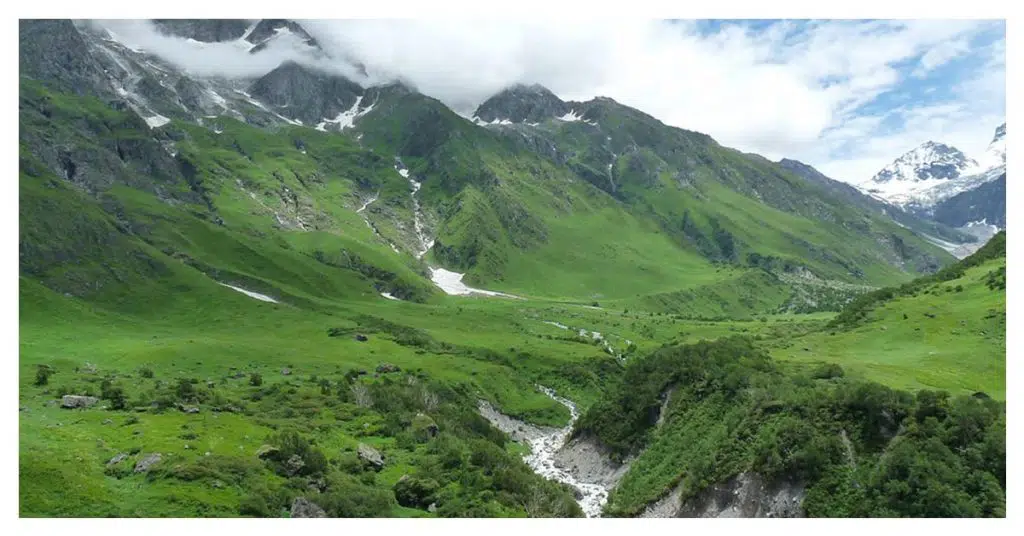
When is the best time to visit Hemkund Sahib?
Every year, the Hemkund Sahib Gurudwara opens in May and shuts right before the start of the winter season, around October. This is the time of year when pilgrims flock to the temple. During these months, the weather in Hemkund Sahib shifts from snow to monsoon.
The optimum time to tackle the Hemkund Sahib trek as a trekker is around July/August. The rainfall would have begun to chill things down. You also have the option of doing the breathtaking Valley of Flowers hike.
Difficulty of the Hemkund Sahib Trek
The complete trip from Ghangharia hamlet to Hemkund sahib is 6 kilometers, and the ascent takes around 3 hours. The whole hike distance from Govindghat to Hemkund Sahib Gurudwara is around 14 kilometers.
Because the trail is mostly straight and the elevation is moderate, this walk may usually be completed in a day. It is not recommended, however, because the height climb from Govindghat to Hemkund is around 2800 meters. So, if you don’t stop at Ghangharia for a night, you could become sick. The Hemkund Sahib walk is moderate in difficulty. It is not a very tough trip, but due to the constant rain and the concrete stairs built up for pilgrims, it can be a little exhausting.
One of the nicest things about the Himalayas is that you can’t simply visit once; you’ll be drawn back again and again. It is critical to build up stamina before embarking on any expedition. Muscle stretching and exercise are beneficial. Travel light as much as possible and learn as much as you can about the destination before you travel. The mountains are gorgeous, and they provide you with tremendous strength to help you progress in life.
Things to carry in Hemkund Sahib Trek
It’s a good idea to bring floaters or sandals with you to the camp or hotel so you can roam around freely. Aside from that, you should invest in a good pair of hiking shoes. They should be light, strong, and comfortable to hold. Always attempt to acquire a new pair of shoes if your walk is more than 10 kilometers on one side. Medical supplies, woolen clothing, a pair of T-shirts and jeans, a water bottle, a small torch, a waterproof/windproof jacket, a raincoat, hand sanitizer, lip balm, and cold cream should all be included in your bag.
Related Articles
The best resorts in coorg for a fun family vacation, 7 best hotels in varanasi to discover tranquil luxury along the sacred ganges, 7 best resorts in pondicherry to visit in 2024, leave a reply cancel reply.
Save my name, email, and website in this browser for the next time I comment.
Stay Connected
Latest articles, 7 amazing resorts in wayanad for a perfect stay, top 6 hotels in ooty for an unforgettable getaway in 2024.

About Tripnomadic
Your next adventure in the United States can be planned with the help of Tripnomadic. Enhance your experience with our carefully curated list of the most popular and must-see locations. Prepare yourself with an improved Travel Buddy. Here we go…
- Colorado Mountains
- Florida Mountains
- Hawaii Mountains
- Maine Mountains
- Montana Mountains
- Nevada Mountains
- South Carolina Mountains
© Tripnomadic. All Rights Reserved.

- Apr 17, 2023
Hemkund Sahib
Hemkund Sahib is a Sikh pilgrimage site located in the Chamoli district of Uttarakhand, India. It is situated at an altitude of 15,200 feet above sea level and is known for its scenic beauty and spiritual significance. The main attraction at Hemkund Sahib is the Hemkund Sahib Gurudwara, which is a Sikh shrine dedicated to Guru Gobind Singh, the tenth Sikh Guru.

The Hemkund Sahib Trek is a popular hiking route that attracts thousands of visitors each year. The trek begins from the town of Govindghat and passes through scenic landscapes, including forests, waterfalls, and rivers. The trek is moderately difficult, with steep climbs and rocky terrain, and takes around 4-5 days to complete.
Hemkund Sahib is open for visitors from May to October, as during the winter months the area receives heavy snowfall and is inaccessible. The best time to visit is during the summer months, between June and September when the weather is mild and pleasant. However, it is important to check the weather conditions before embarking on the trek as weather can be unpredictable and can affect the trekking experience.
Overall, Hemkund Sahib is a beautiful and spiritually significant destination that offers a unique combination of natural beauty and cultural significance, making it a must-visit destination for trekkers and spiritual seekers alike.
How to reach Hemkund Sahib?
Hemkund Sahib is located in the Chamoli district of Uttarakhand, India, and can be reached by a combination of road and trekking.

The nearest airport to Hemkund Sahib is Jolly Grant Airport in Dehradun, which is about 294 km away. From the airport, one can hire a taxi or take a bus to Govindghat, the starting point of the trek.
The nearest railway station to Govindghat is Rishikesh railway station, which is about 273 km away. From the railway station, one can hire a taxi or take a bus to Govindghat.
Govindghat is the starting point of the trek to Hemkund Sahib. It is well connected by road to major cities in Uttarakhand and neighboring states. Buses and taxis are available from cities like Rishikesh, Haridwar, and Dehradun to Govindghat.
Once you reach Govindghat, you can start the trek to Hemkund Sahib. The trek is about 19 km long and takes around 4-5 days to complete. The trek passes through scenic landscapes, including forests, waterfalls, and rivers, and involves steep climbs and rocky terrain.
Overall, reaching Hemkund Sahib requires a combination of road and trekking, and can be accessed from major cities in Uttarakhand and neighboring states.
Hemkund Sahib Trek Itinerary
Here's a sample itinerary for the Hemkund Sahib Trek :
Day 1: Arrive in Haridwar/Rishikesh
Arrive in Haridwar/Rishikesh by morning and check in to your hotel.
Explore the local market and the Ganga Aarti at Har Ki Pauri in the evening.
Overnight stay in the hotel.
Day 2: Haridwar/Rishikesh to Govindghat (Approx. 290 km / 10 hours)
Leave early in the morning for Govindghat, the starting point of the trek.
Stop at Devprayag, Rudraprayag, and Joshimath on the way for breakfast and lunch.
Reach Govindghat by evening and check in to your hotel.
Day 3: Govindghat to Ghangaria (Trek - Approx. 13 km / 6-7 hours)
Start the trek from Govindghat to Ghangaria.
The trek passes through beautiful forests and river streams.
Reach Ghangaria by evening and check in to your hotel.
Day 4: Ghangaria to Hemkund Sahib (Trek - Approx. 6 km / 4-5 hours)
Start the trek early in the morning to Hemkund Sahib.
The trek is steep and challenging, but the beautiful views make it worth it.
Reach Hemkund Sahib by afternoon and explore the gurudwara and the surroundings.
Trek back to Ghangaria in the evening.
Day 5: Ghangaria to Govindghat (Trek - Approx. 13 km / 4-5 hours)
Start the trek back to Govindghat after breakfast.
Reach Govindghat by afternoon and check in to your hotel.
Relax and explore the surroundings in the evening.
Day 6: Govindghat to Haridwar/Rishikesh (Approx. 290 km / 10 hours)
Leave early in the morning for Haridwar/Rishikesh.
Stop at Joshimath, Rudraprayag, and Devprayag on the way for breakfast and lunch.
Reach Haridwar/Rishikesh by evening and check in to your hotel.
Day 7: Departure
Depart for your onward journey after breakfast.
Note: This itinerary is a sample and can be modified according to your preferences and requirements. The duration of the trek can also be extended by adding rest days or side trips.
What is Hemkund Sahib famous for?
Hemkund Sahib is famous for its spiritual significance and natural beauty. The main attraction at Hemkund Sahib is the Hemkund Sahib Gurudwara, which is a Sikh shrine dedicated to Guru Gobind Singh, the tenth Sikh Guru. The gurudwara is located at an altitude of 15,200 feet above sea level, making it one of the highest gurudwaras in the world.
Hemkund Sahib is also famous for its scenic beauty. The trek to Hemkund Sahib passes through picturesque landscapes, including forests, waterfalls, and rivers. The area is also surrounded by snow-capped peaks, which add to the natural beauty of the region.
Hemkund Sahib is a popular destination for both spiritual seekers and trekkers. The trek to Hemkund Sahib is moderately difficult, with steep climbs and rocky terrain, making it a challenging but rewarding adventure for trekkers. The gurudwara also attracts thousands of Sikh devotees each year, who come to pay their respects to Guru Gobind Singh.
Overall, Hemkund Sahib is famous for its spiritual significance, natural beauty, and challenging trekking routes, making it a must-visit destination for both spiritual seekers and trekkers.
What is the right time to visit Hemkund Sahib?
The best time to visit Hemkund Sahib is between June and October, during the summer and autumn months. During this time, the weather is mild and pleasant, with clear skies and warm temperatures during the day. The snow has melted, making the trekking trails more accessible, and the natural beauty of the region is at its peak, with the surrounding mountains and valleys covered in lush greenery.
The monsoon season in Hemkund Sahib starts in July and continues until September. During this time, the region receives heavy rainfall, and there is a risk of landslides and flash floods, which can make trekking dangerous. It is advisable to avoid trekking during the monsoon season.
During the winter months, from November to May, Hemkund Sahib is covered in snow and is inaccessible. The region experiences heavy snowfall, making trekking impossible. It is best to avoid visiting Hemkund Sahib during the winter months.
Overall, the best time to visit Hemkund Sahib is between June and October, during the summer and autumn months, when the weather is mild and pleasant, and the natural beauty of the region is at its peak.
Which is the world's highest Gurudwara?
The world's highest gurudwara is Hemkund Sahib Gurudwara, located in the Chamoli district of Uttarakhand, India. It is situated at an altitude of 15,200 feet (4,633 meters) above sea level in the Himalayan region. The Gurudwara is dedicated to Guru Gobind Singh, the tenth Sikh Guru, and is considered a sacred place for Sikhs. Hemkund Sahib is a popular pilgrimage destination for Sikhs, who trek for miles to visit the gurudwara and pay their respects to Guru Gobind Singh.
What to wear in Hemkund Sahib?
As Hemkund Sahib is located at a high altitude and the weather can be unpredictable, it is important to dress appropriately and in layers. Here are some clothing items that you should consider bringing:
Warm Jacket: A warm jacket is essential, as the temperature can drop significantly at night and at high altitudes.
Thermal Wear: Thermal wear is a great option to keep you warm during the trek.
Trekking Pants: Trekking pants are comfortable and provide protection against insects, thorns, and rocks.
Fleece Sweater: A fleece sweater is another warm layer that you can wear on top of your thermal wear.
Waterproof Jacket: A waterproof jacket is essential, as there can be sudden rains during the trek.
Gloves and Woolen Caps: Gloves and woolen caps are important to keep your hands and head warm.
Trekking Shoes: Trekking shoes with good grip are important, as the terrain can be slippery and rocky.
Sunglasses and Sunscreen: Sunglasses and sunscreen are important to protect your eyes and skin from the harsh sun at high altitudes.
Overall, it is important to dress in layers and to bring warm clothing, as well as waterproof and protective gear.
#hemkundsahib #gurudwara #uttarakhand #himalayas #trekking
Recent Posts
Adi Kailash and Om Parvat: Mystical Peaks of Devotion
Amarnath Yatra 2023
- Travel Stories

Journey to World’s Highest Altitude Gurdwara – Hemkund Sahib

Can you imagine a place, where a four years old child and an eighty years old man are both equally enthusiastic to visit a 4,632 m high glacial lake? Yes, it is a very common sight for anyone who is travelling to the holy shrine of Hemkund Sahib (also spelled Hemkunt); the Gurdwara at the highest altitude in the world.
[Also read about my experience at Kedarnath]
The glacial lake Hemkund (literally means ‘snow lake’) is surrounded by seven mountain peaks. It is a place which radiates its own spirituality. Long ago, Lakhsman; the brother of Lord Ram (Hindu deity and the 7 th Avatar of Lord Vishnu) had meditated here for God realization. As per legends, back then this place was known as Lokpal and it was a popular pilgrimage destination for local villagers, but was known only to a handful of people.

Guru Govind Singh is the tenth Sikh guru, who is highly respected due to his tremendous work for mankind. Dasam Granth is a religious book written by Guruji. In that book, he had mentioned about his previous life and a holy place, where he had meditated and realized god. But the actual place was not known to anyone.
In 1934, Sant Sohan Sigh had identified ‘Lokpal’ as the holy place Hemkund, and it was then that the place came into limelight. Later in 1960, a Gurdwara dedicated to Guru Govind Singh ji was built beside the lake. Due to the very high altitude, this holy shrine remains inaccessible in the winter and remains open only for six months. In spite of a very challenging road, bone rattling cold, and other difficulties, at least 1,50,000 visitors visit Hemkund Sahib every year.

I was planning to visit Hemkund Sahib for the last couple of years, and finally got the opportunity this year. I was overjoyous, as I was looking forward to witness two remarkable and unique places in the same trip, The Valley of Flowers and Hemkund Sahib. My journey started from Govindghat; a small hamlet on the way to Badrinath. From Govindghat the trek route starts for Ghangaria; the base camp for the Valley of Flowers and Hemkund Sahib.

Midway I took a tea-break and learned a sad story from the tea vendor. In this valley, there was a beautiful small village, Bhyundar. But in the 2013 natural disaster, the whole village was completely washed away. In that incident, entire area of the Valley of Flowers (read about the Valley of Flowers ) and Hemkund Sahib were severely affected. Effects were still prominent, even after four years of the disaster.

After trekking few more kilometers, I reached Ghangaria at late afternoon. It is a very small hamlet with few hotels, shops and the holy Gurdwara. Throughout the journey from Govindghat to Hemkund, I was blessed with the offerings of the Gurdwara. It was really a humbling experience.

Ghangaria is about 3,000 meters and Hemkund Sahib is close to 4,700 meters, and the trek route distance is only six kilometres. I was somewhat worried about the next day, as I had heard so many terrifying stories about the difficulties of this short trek.

I started very early in the morning the next day. After trekking for a couple of kilometers, I found an old man. He was also on the way to Hemkund Sahib and was alone. I greeted him with a Namaste . He offered me Roti (the Indian bread), which I accepted and started chatting with him. Talking to him and listening to his story was something that kept my mind away from the arduous trek that I was on.
The gentleman was ‘only’ 80 years old and was travelling to Hemkund Sahib for the 3 rd time. I was really amazed by his passion; it seemed that age had made an impression on his body but his spirit was still unaffected, as I could sense the excitement in his voice.
I asked “ Don’t you feel tired as this is really a hard trek? Are not you scared? ” To this, he gave an answer that still resonates with me. He exalted “ I am going to meet my teacher, why should I worry about the road. My duty is to walk and rest will be taken care by Guruji” . I was fascinated by his answer – when we are in the middle of our journey, we got so attached to the challenges of the path that we forget the true purpose of our journey.
Undoubtedly the trail was tough, but at the same time it was truly beautiful. The Serpent like trail, the hide-and-seek of the clouds amongst the mountains, super green plants with small flowers, the petrichor of the mountain soil after the rains…they are all heavenly when experienced together. I decided to forego the heaviness of the difficulty and rather enjoy the lightness of the beauty.

I started walking farther. After some time, I found few small cute looking blue flowers; they all are looking very shy as they all were hiding their faces. I took some images, but then I was ‘blissfully unaware’ that those flowers are none other than Himalayan Blue Poppy , one of the rarest flowers of the Himalaya!

In the meanwhile, I was busy in search of another flower, Brambha Kamal; the iconic flower of Uttarakhand. I was almost close to the top, but still I could not found any good looking flowers. Later on, one guide told me that it is because of the tourists, who pluck the flowers just for their momentary pleasure. I don’t know when people will understand the nessecity of preserving mother Earth’s jewels.

Finally, I was at the top; I was feeling tired, but happy as I had made it. The weather was changing rapidly and it was cloudy and becoming cold. I was thinking of my next steps hereon, when suddenly another old man came in front me just like an angel would. He had a bowl of khichri (Indian food mixed with Dal and Rice), which he readily offered to me. The hot khichri tasted just like nectar.

He suggested me to take a holy dip in the lake and then to visit the Gurdwara. What will happen if you bath in a freezing glacial lake? The first thing that came to my mind was PNEUMONIA! Slowly I walked towards the lake and just dipped my finger; I felt it was colder than ice! I was in doubt, but I wanted to do it. Quickly changed my clothes and slowly got into the water. I have travelled to many mountains where the wind would drive shards through your skin, spent nights in a freezing cold, icy valley, but the freezing water of this lake simply cannot be compared to any of my previous experiences.
Finally, I took a dip and the experience was like getting a shock of 1000 Volts! I sprang out of the water, cursing myself. However, with the initial fear subsided, and the cold water no more an overbearing factor, I was feeling really relaxed and rejuvenated. I took a few more dips and prepared for the Gurdwara visit.

The Gurdwara was very peaceful and calm on the inside. I sat there for a while and started enjoying the divinity of the place.

After some time I visited the old Lakhsman temple, which is just beside the Gurdwara. There was almost no crowd there. The temple priest was very young; almost at my age, and went about telling me another interesting story of this place. When Lakhman was severely injured by the son of Ravana in the battleground, Lord Hanuman brought medicinal herbs from Himalaya, which saved the life of Lakhsman. In celebration, god showered flowers from heaven that was the way the Valley of Flower was originated.

The weather has started changing again, and the clouds have enveloped everything. Normally, the Gurdwara closes at 2 pm every day. But I decided to climb down early. Just as I walked a few steps, it started to rain. Which didn’t stop till the end of my journey.

Towards the late afternoon, I came back to the guest house and I was contemplating about the day. Hemkund is an amazing place for any spiritual seeker.
But what if you are not at all spiritual?
Even then the beautiful glacial lake, surrounded by seven big mountains, is going to take a permanent space in your mind’s hard disk.

Few tips for your visit to Sri Hemkund Sahib
– Trek trail is little difficult. Basic level of fitness is highly recommended for this trek.
– Pony services can be opted in case of any difficulty. However, I will recommend for trekking to enjoy the nature.
– Start early. Gurdwara closes everyday at 2 pm.
– And finally, please do not litter plastic in the trail. Remember, if we care mother nature, then only mother nature will care us.
Have you visited Hemkund Sahib before or planning to visit? Please share your thoughts in the comments.
Share this:.
- Click to share on Twitter (Opens in new window)
- Click to share on Facebook (Opens in new window)
- Click to share on WhatsApp (Opens in new window)
- Click to share on Pinterest (Opens in new window)
- Click to share on Pocket (Opens in new window)
- Click to share on Tumblr (Opens in new window)
Similar Posts

Abode of Badri Vishal – Badrinath
I was sipping a cup of coffee at my home. It was a lazy rainy...

The Bridge of Life – Netala
“You taught me the courage of stars before you left How light carries on endlessly,...

Kedarnath – where mythology blends with divinity
The Himalayan Mountains have had a predominant role in Indian culture, mythology, and religion. If...

The Highest Point of West Bengal – Sandakphu
I checked my watch and sure enough, the time was 5:30 AM, meaning that I...

World’s highest Shiva temple – Tungnath
When I stood outside the ancient temple to find a mountain valley bathed in moonlight,...

The Moon Rock – Chandrashila
It was dark and still night. I adjusted my head torch and started walking towards...
2 Responses
I found getting lot of takeaways . The author has contributed everything wholeheartedly which explains about this inevitiable journey .Will be looking forward for more of these incredible expeditions.
Incredible Place to explore
Leave a Reply Cancel reply
You must be logged in to post a comment.
Hemkund Sahib and Valley of Flowers: Ideal Solo Trekking Destinations

It had been close to 2 years since I went on a himalayan trek. It was already August and I knew even few days could make a difference now as flowers blossom season would be over at Valley of Flowers. Finally, I made up my mind and was ready to start this 5 day long journey using public transport and stay in normal hotels/lodges.
A long Bus Ride:
On the night of Aug 24th, I took the bus from Delhi to Rishikesh. The bus ride was uneventful as I slept for most of the time. I reached Rishikesh at around 4 AM. It was pitch dark, obviously. I love such not so crowdy and noisy bus stand. As soon as I enquired and finalised my next bus to Govindghat, I looked for a tea stall. You would be able to locate only a handful of passengers during these hours and that adds to this amazing feeling of being part of a group who is going to some place of their own which might be far from their usual stuff.
Buses to Joshimath/Govindghat leave quite early in the day. Last bus probably leaves at around 6 or 7 AM. After enjoying early morning tea, I boarded the bus which had few passengers already occupying the best seats. I managed to get a window seat at around middle of the bus. The long bus journey started at 5 AM. Bus stopped at a couple of places in between where I had breakfast and lunch, primarily comprising of parathas and daal roti. As soon as you get out of Rishikesh, beautiful mountains and valleys start appearing all around. Most of the time, my eyes were enjoying the nature outside bus. After a day long journey, I reached Govindghat at 5 PM. Bus was actually going to Badrinath which is close to 1.5 - 2 hrs journey from Govindghat.
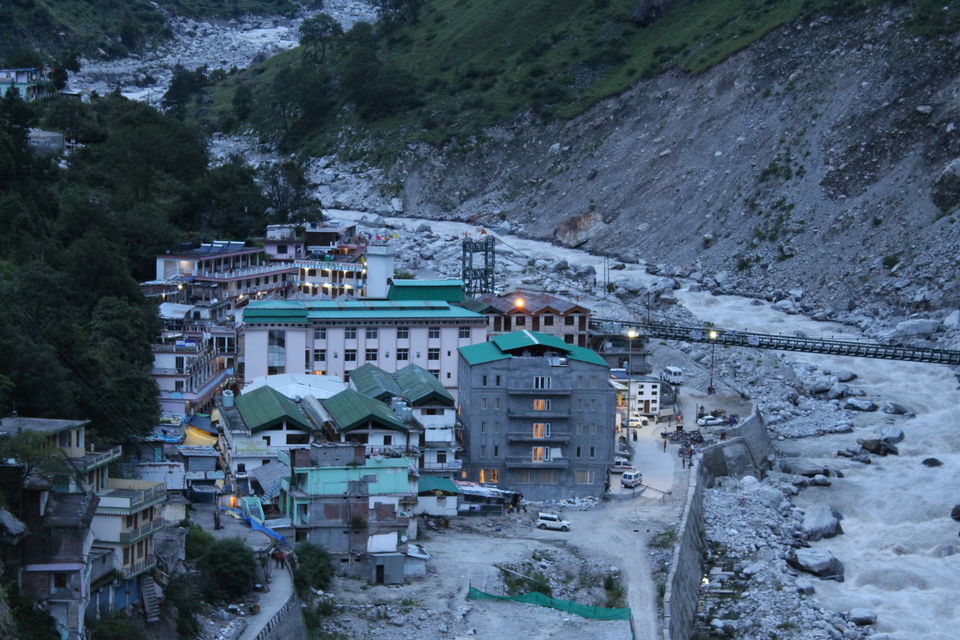
Govindghat, at a height of 6000 ft above sea level, is a 2 fold place. The upper fold has few shops and hotels. This fold is right on the main road which connects Joshimath with Badrinath. The lower fold is right beside the Alaknanda river. This fold has a Gurudwara, which hosts tourists with accommodation and langar, and few shops cum hotels. It is rather a pretty small place which becomes operative during this time of the year (May to September). Apparently, Joshimath is the last place on this route where you can find an ATM. I came to know this when I checked with hotel staff. As I was short of cash, I made a quick visit to Joshimath with a taxi and withdrew necessary cash for my rest of the journey. After dinner at the hotel, I took a few shots of this beautiful place from my DSLR before calling it a day.
Trekking starts
Next day, I got up early and left the place at 7 AM for 14 km trek to Govinddham (Ghanghria). The trek started by going to the lower fold and taking the ascend alongside the river. It was a bit cold morning with sun hiding behind the clouds. As I went away from the sight of Govindghat, it turned out to be a nice pakka road for the first 4 Kms which was quite a steep climb.
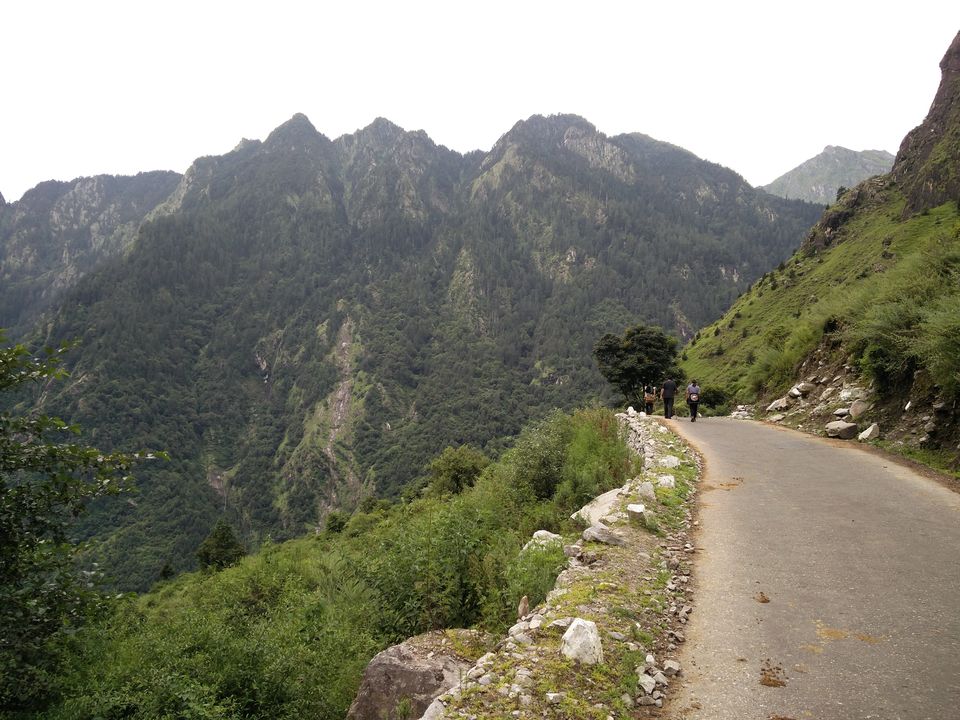
On my way up, I realised there were shared taxis available from Govindghat to Pulna i.e. for the first 4 Km of this trek. I was happy I didn't know that as the uphill trek was a scenic delight. It was a sight of green mountains all around and Alaknanda river flowing along the valley of Govindghat. Pulna is a small aggregation of houses and tea shops. I grabbed something to drink as keeping yourself hydrated is the recommendation you would get on any trek where you are gaining altitude. After Pulna, it was a dirt trail with manageable ascent. Now, more people were around me trekking to Ghangaria. Many people were opting for mule or porter services as many sikh pilgrims visit Hemkund Shaib in this period.
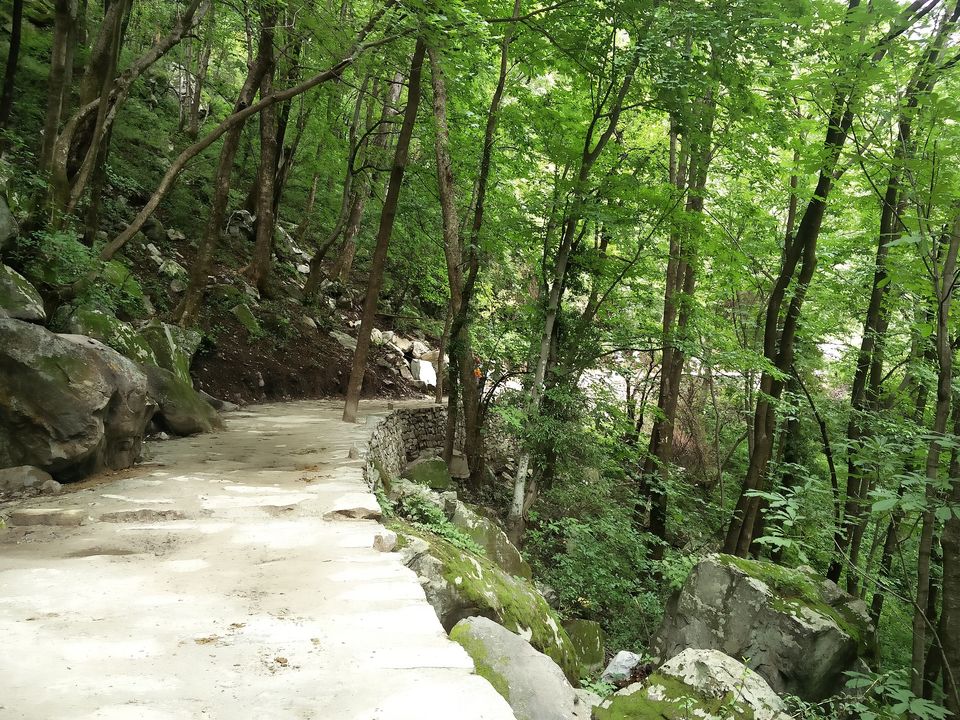
There were quite a few shops on the way where you can take a bite as well as have a full fledged meal. I had paranthas at Byundar which was around 4 kms before Ghangaria. The complete trail takes you through a beautiful trek with trees covering the path and large sheds with benches installed at every 1 km for trekkers to stop and take rest. It is the only trail I have seen where one can find public washrooms as well and the trail is kept clean by the sweepers all through the day. Byundar is an exciting place as one has to cross bridge and get on the other side of the river. Also, you would lose sight of the river for rest of the trek. The trail ahead was again quite steep but it was worth it. The colourful tents were making themselves visible as I was nearing Ghangaria.
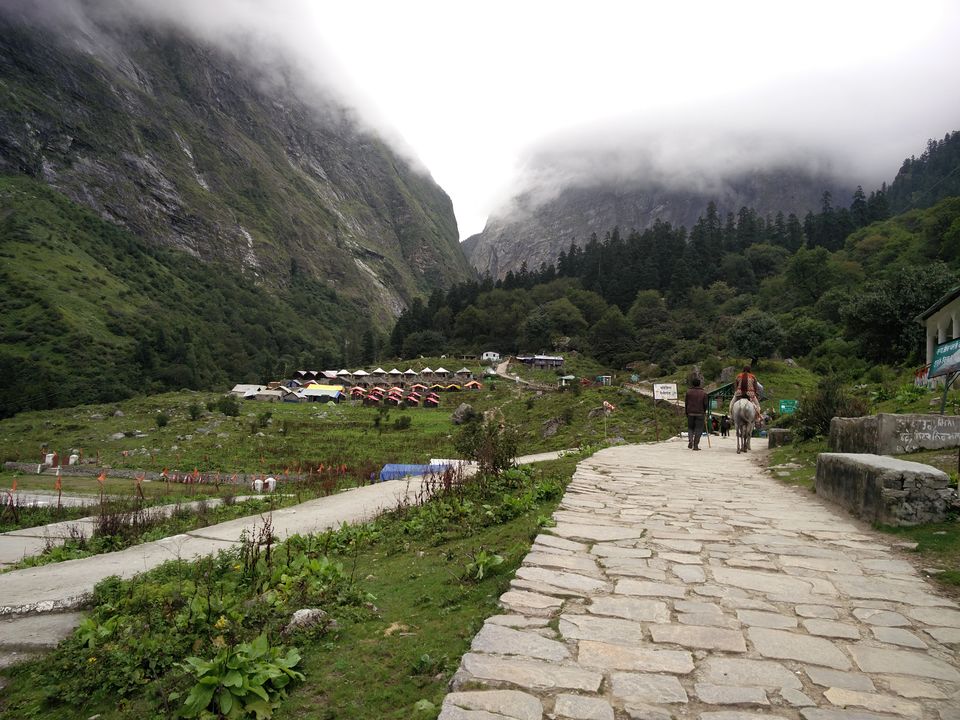
After a long day's trek, I finally reached Ghangaria around 2 PM. Ghangaria is a beautiful small place. The whole of this place is built around the trail. You would find shops, hotels and a Gurudwara as you start and end your visit to this place. It is merely a 500 metre kind of trail along which Ghangaria has established itself. After checking few hotels and GMVN guest house, I finalised Hotel Deepak and went to bed for a quick nap after a much needed hot shower.
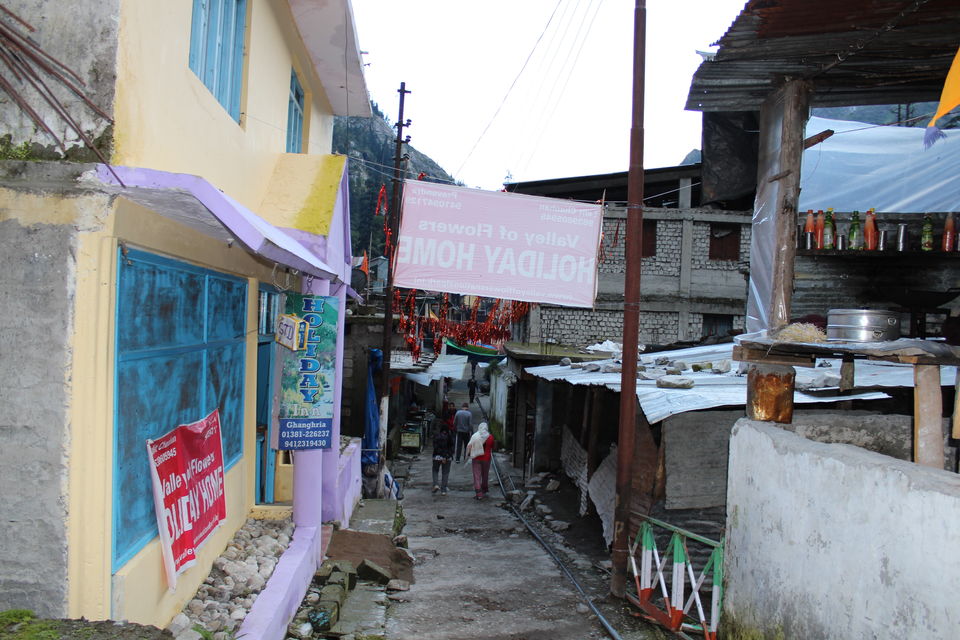
As sun was calling it a day, the beauty of Ghangaria increased multifold and place was lighting up like a small bunch of candles in a wide mountain range. As I came outside my room and visited small restaurant of the hotel at the entrance, it started pouring. I took a stroll around, visited Gurudwara (had hot tea there), bought a wooden trekking pole and a poncho (in case rain doesn't stop). I had dinner quite early, to my standards, at around 7:30 PM and it was still raining. I enquired and got to know that rain might continue tomorrow morning as well. I was wandering how would I trek to Hemkund Sahib if it didn't stop raining. With these wandering thoughts, I went to bed.
Hemkund Sahib
The mobile alarm at 4:30 AM woke me up. Soon, I realised that it was still raining and raining heavily. Anyhow, I freshened up and went downstairs at 5 AM. I knew people start their trek from the Gurudwara. I reached Gurudwara with my poncho and saw close to 40-50 people having tea wearing different colours of ponchos. I quickly had hot tea and started trek in the rain. It was my first such experience and honestly speaking, I was loving it. The serene beauty of the trail ahead and clouds all around gave me goosebumps and I wished to capture this moment forever in my heart. It was getting cold as I was moving ahead and higher. At one point, the sight ahead me was pure and scared. The rocky trail was visible for 20 to 30 metres, mountain on one side and only white clouds on the other side. It seemed like going to some place straight out of fantasy dreams.
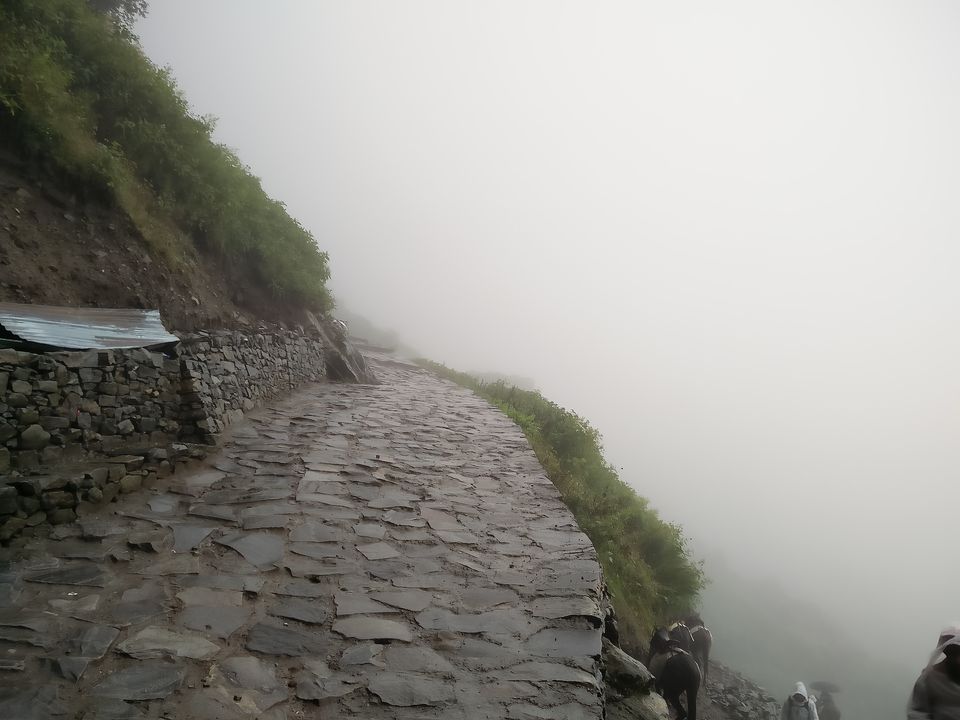
There were some small shops selling tea, milk, maggi etc. on the trail. I stopped at one of those shops after around 2 kms of steep ascend. I had tea and looked around only to admire the beautiful nature. As I was around 1 km from Hemkund Sahib, I was able to hear kirtan from the distant speaker installed. After an arduous trek, finally I reached Hemkund Sahib (at a height of 16000 ft) at around 8:00 AM. The holy place, which I had seen only on TV or other photographs, was right in front of me. The light drizzle was only adding to beauty of the place. The Gurudwara is in the centre with langar hall (food serving place) near the front side and Hemkund (lake) at the backside. The whole place was surrounded by snow capped mountains. I felt like being on the top as mountain range was little visible in the haze weather. To my surprise, there was a small hydroelectric power generating station to provide electricity to the Gurudwara.
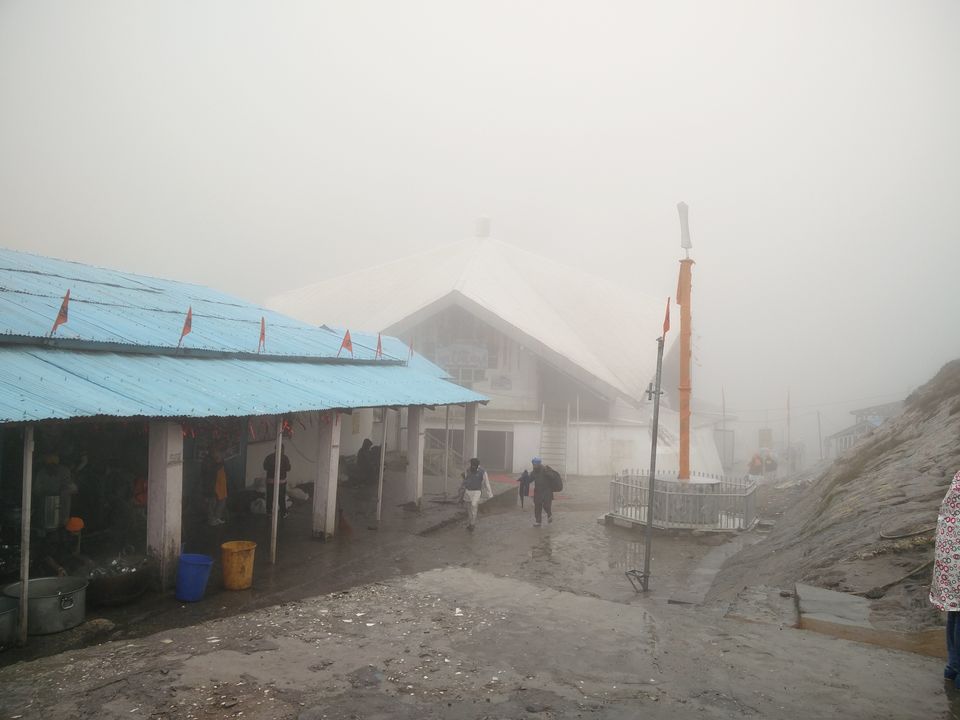
I said the prayer in the Gurudwara before having hot khichdi and tea. Then, I spent quite some time just observing the place near Hemkund lake. I wished to capture and memorise this experience only to relive it later. With heavy heart, I left the place to start my descent at around 9:30 AM. During my descent, I saw lot more people ascending. Some of them were amused to see me descending so early. I guess I was one of the first ones to descend among that day's trekkers. I completed my descent in around 3 hours. I had full meal at the hotel and went for a quick nap. I took an evening stroll around and there was a feeling of accomplishment that I had completed the trek successfully. I picked up a spot for taking some evening shots of Ghangaria. After dinner, I retired to bed early.
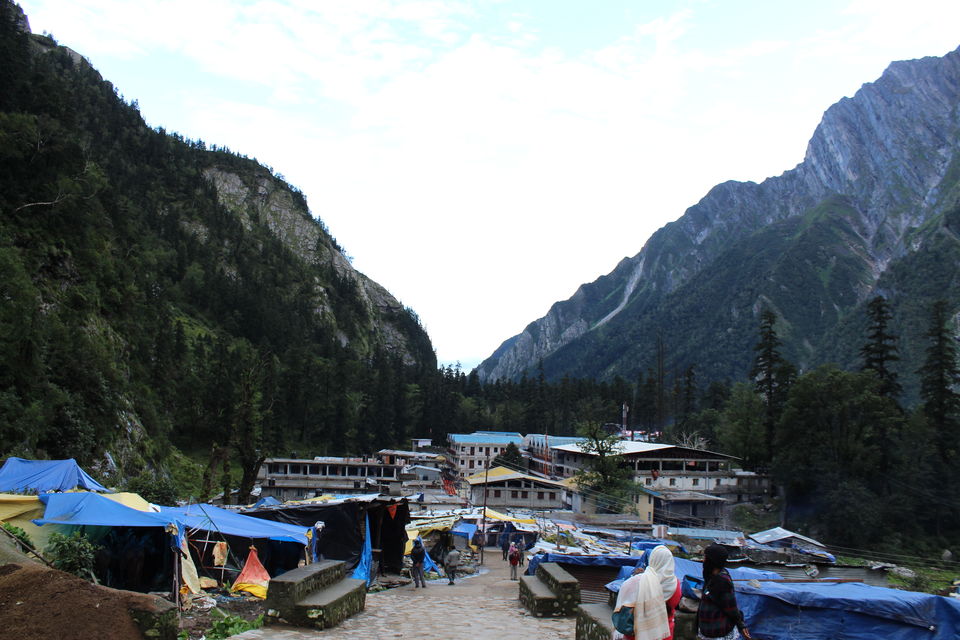
Valley of Flowers
Next day, I geared up for Valley of flowers trek which is shorter and easier as compared to Hemkund Sahib trek. It is a 3 to 4 km trek from Ghangaria, where valley opens up and one can go as deep inside the valley as he/she wants to. I reached at the check post at around 6 AM where I bought the entry ticket and got a piece of advice from the forest officer about the animal movement at this time. As informed by them, a group of 9 people had already entered the forest. After understanding the trail from the officer, I looked at the dense forest trail ahead and started my trek. I had never seen such a beautiful trail. It was narrow with nature's green colour all around and there was a fusion of birds chirping with sound of river flowing somewhere. As I covered 1 km, there was a small bridge beneath which river was flowing with strong current.
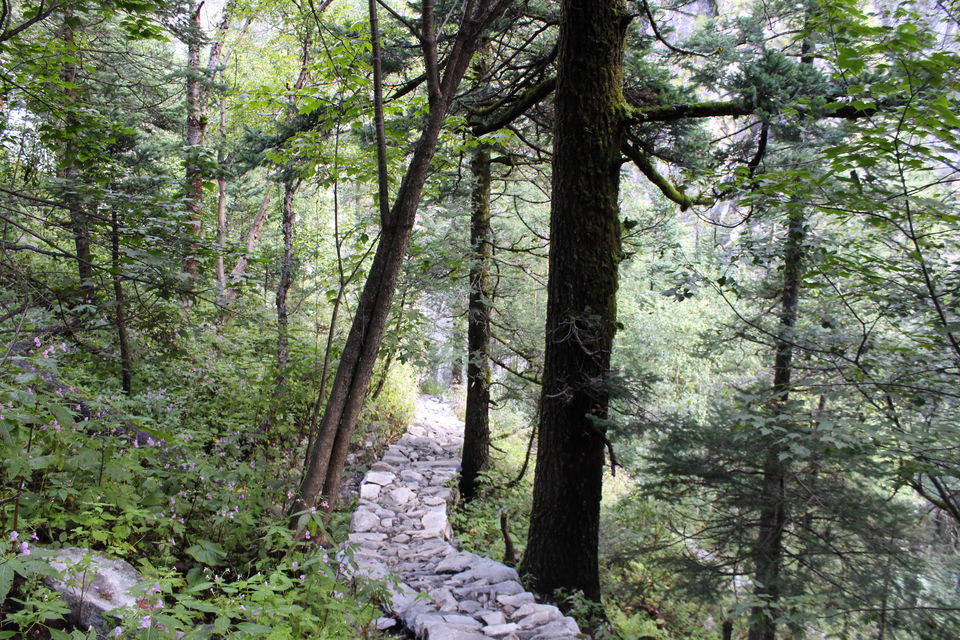
Now, it was a steep climb in even more dense forrest. After covering around 2 to 3 kms further, the valley opened up suddenly. The valley was lush green with visible distant mountains. The flowers started showing all around. Although it was not a full blossom season for the flowers, I found more than 10 types of flowers.
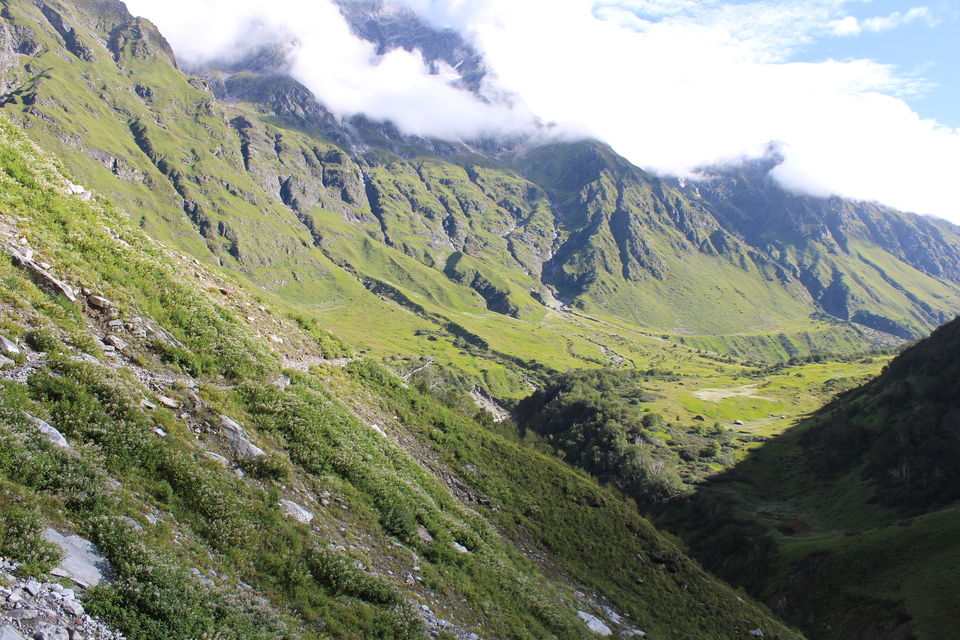
After spending some time in the valley, I turned back as I had to leave for Govindghat the same day. I reached back at the hotel at around 11 AM and started my trek back from Ghangaria to Govindghat after checking out. I never loved trekking back the same way I came. Throughout my way back, the milestones reminded me of the day I was going to Ghangaria. I whispered multiple times:- "I would miss you Ghanagria". I reached Govindghat at around 5:30 PM and checked in the Hotel Ganga for the night.
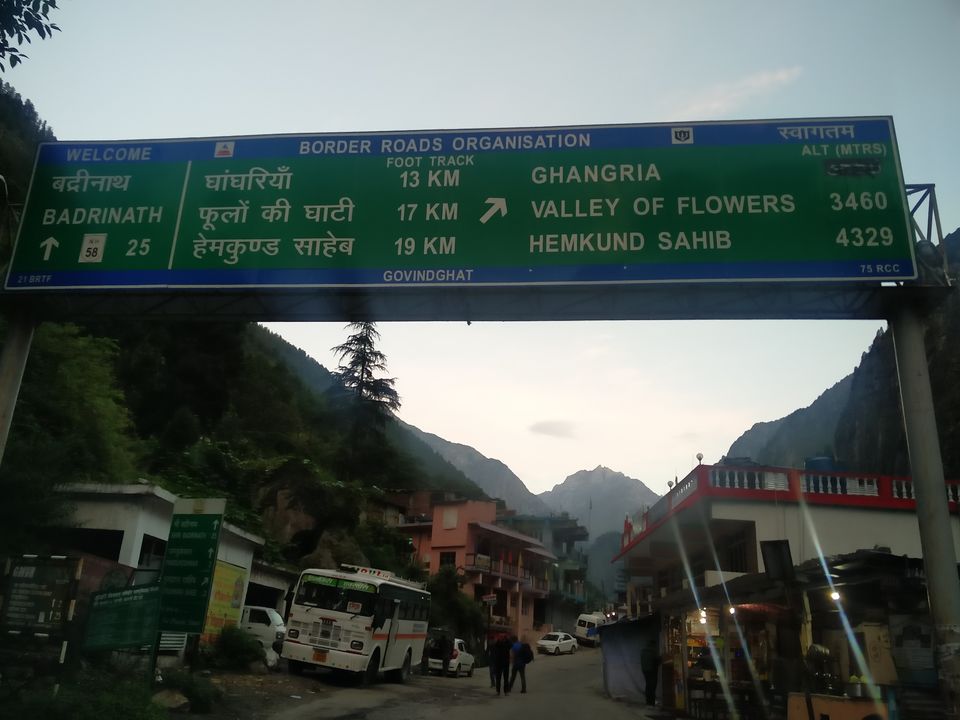
Next day, I started bus journey back to Rishikesh and then to Delhi in the night. I reached Delhi at around 1:00 AM with heart full of memories that I would cherish throughout my life.
Uttarakhand Packages
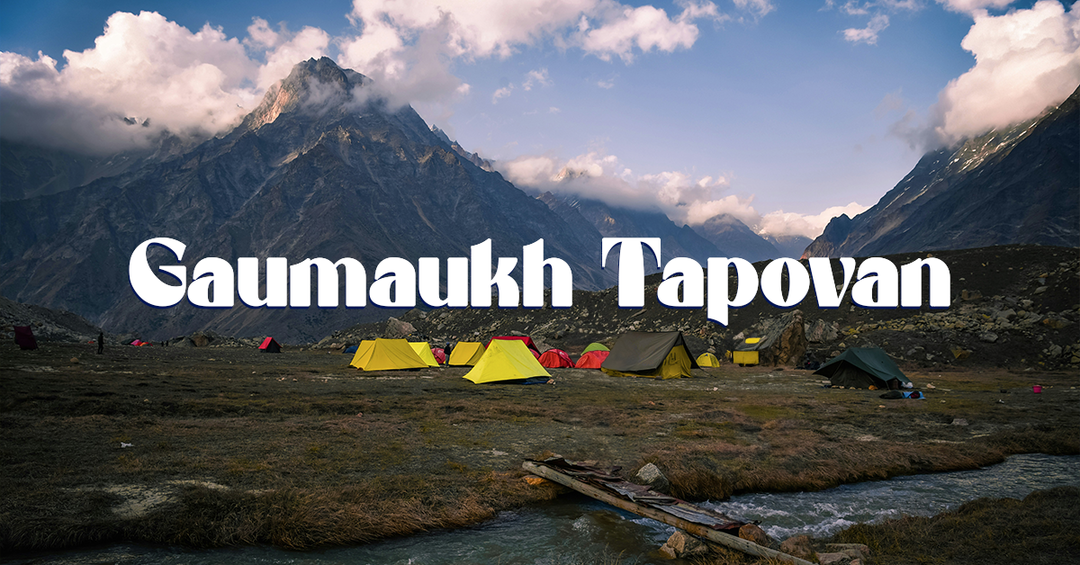
More Stories For Uttarakhand
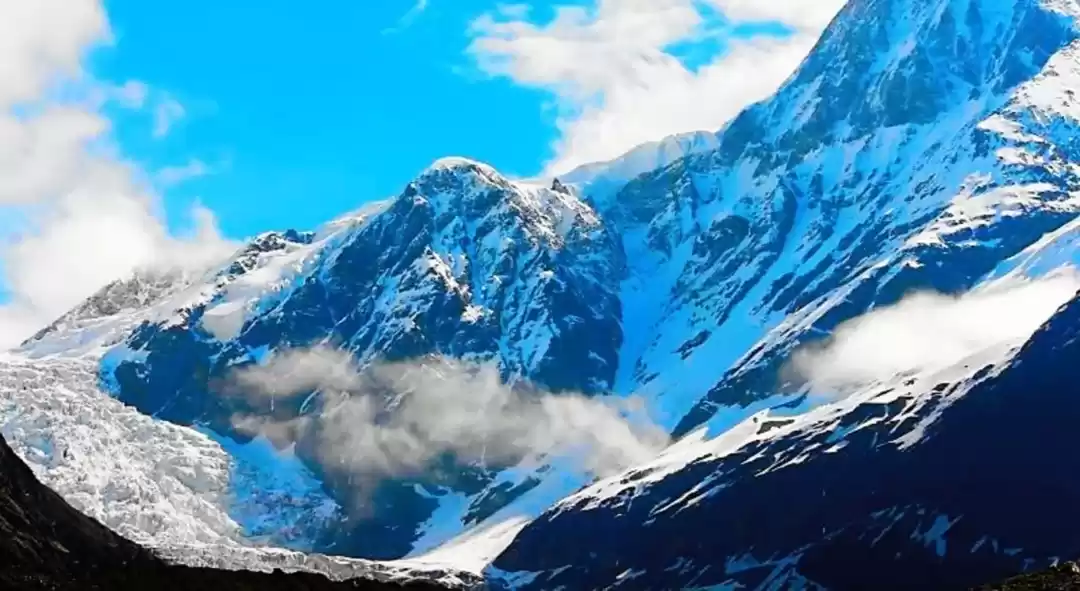
More By This Author
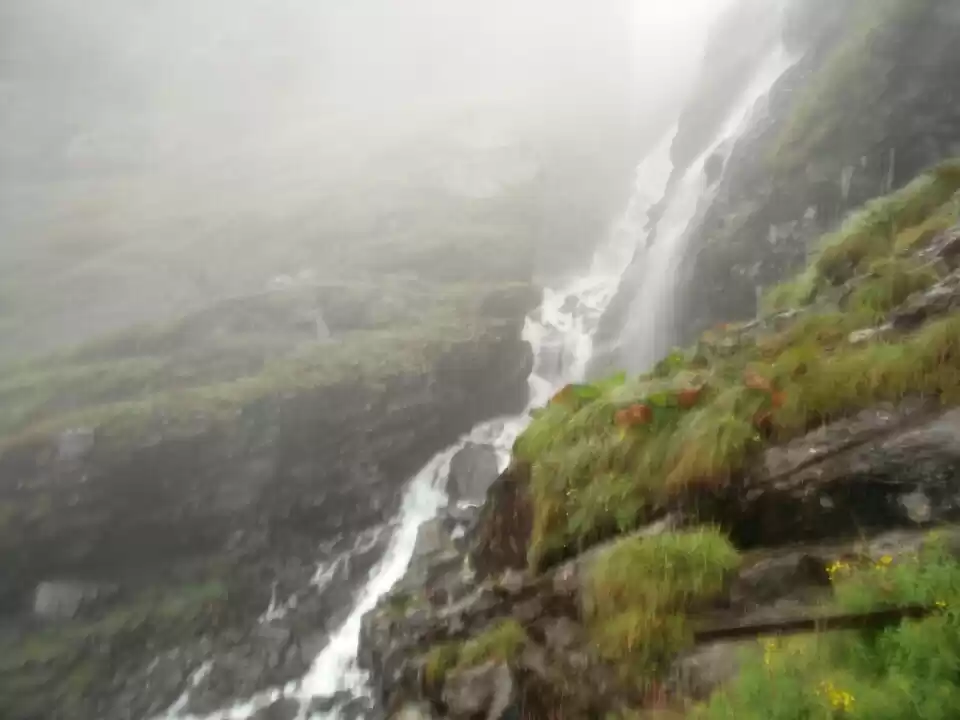
Further Reads
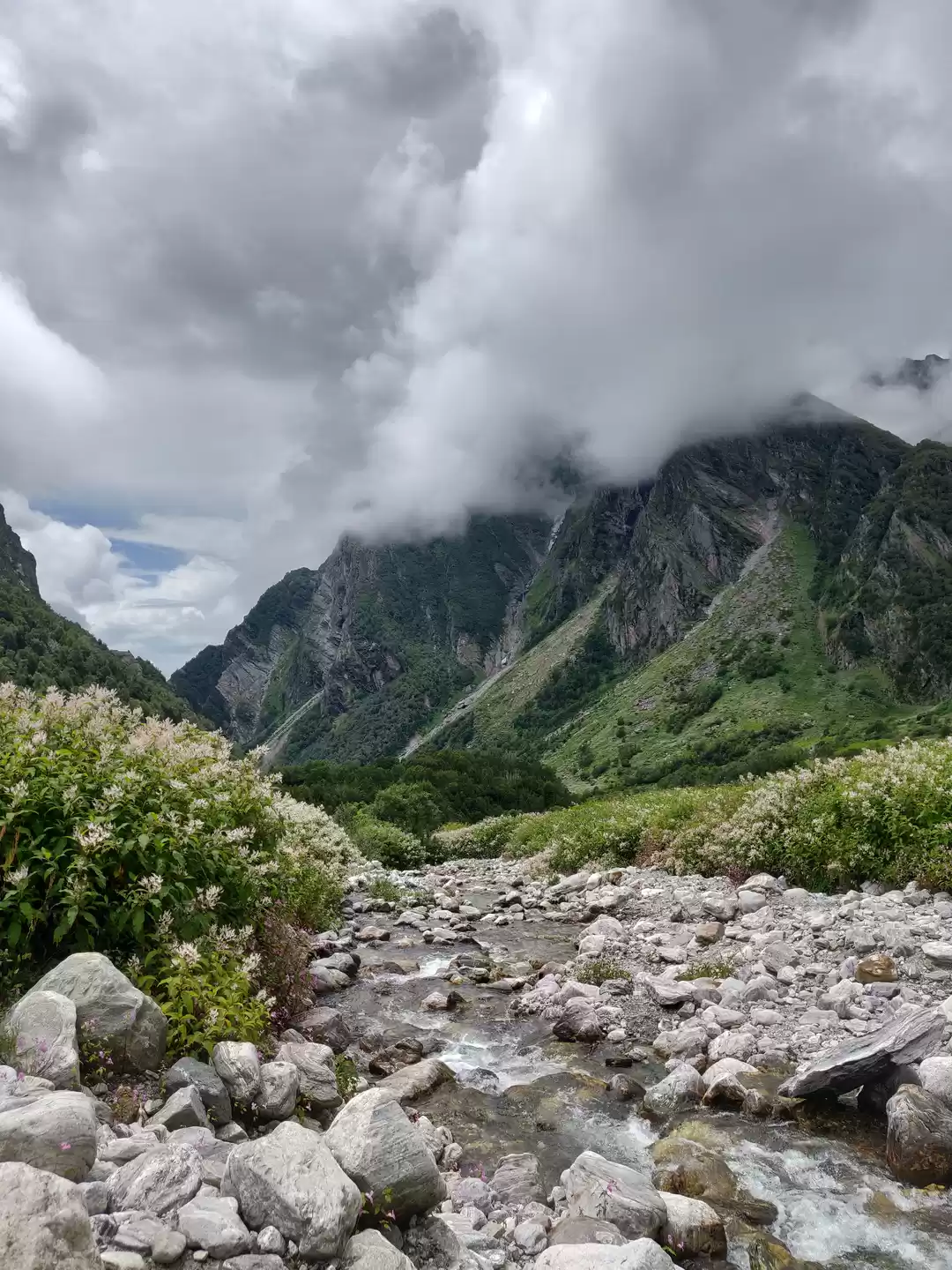
A Complete Guide to Trekking Tours in India
India Tours
International tours, destination wedding, medical tourism, plan your trip.
- Trekking in India
Hemkund Sahib Trek
- Accommodation
- Sightseeing
- Trip Highlights
- Best Time to Visit
About Hemkund Sahib Trek
Take a bath of hues with Hemkund trekking. The valley of flowers at Hemkund slowly hypnotizes you into the world of colors and hues. This place has manifold reason to visit. Despite being a long journey this place gives you thousands of reasons to keep yourself energized and enriched. The still mountains and ever flowing river Pushpawati takes you into the world of solace and tranquility. This exceptionally rich destination also gives you the chance to spend a little time on the lap of nature while witnessing the diverse forms of flora.
The trekking route is very interesting if you are on your way to Hemkund. The route starts from Haridwar to Joshimath. The rout has so much to offer. After starting your journey from here you have to trek for the Ghangaria. Ghangaria is the base camp for reaching Hemkund Sahib and Valley of flowers. Throughout the trip from Govind Ghat to Ghangaria, you will have the river as your companion. You can spend your night over here and prepare your journey for the next day towards valley of flowers. The nightlife of Ghangaria gives you the opportunity to listen to each breath of yours.
The journey from Ghangaria to Valley of flowers is so beautiful that you will never want to forget the memories in your full life. The three thousands meters high road offers the picturesque view of mountains and greeneries where the clouds play hide and seek with you on your journey. The journey creates the excitement within which finally takes you into the world of colors and happiness. The valley of flowers gives you the chance to spend some time in the midst of colors and natural garden where you can witness the natural fragrances. After the valley of flowers, you can now get ready for the second trekking point which is called the Hemkund sahib. The peaceful Hemkund Sahib Lake and Gurudwara takes you in the world full of peace and consort. You will never feel like returning from this holy place. It takes four hours to reach Hemkund Gurudwara from the lake.
The best time to visit valley of flowers is in the time of monsoons which is during the month of July and August. At this time the flowers bloom, indicating the blooming of the myth. Before the great Sikh arrival at this place, the place was known among the Hindu pilgrims. The place was renowned as Lokpal Lake. The lake is named so for Hindu Lord Vishnu. Lakshman, brother of Lord Rama, after facing an injury from Ravana’s son came here for herbal treatment. There is another myth regarding Lakshman’s previous birth in the form of seven headed snake. The snake, known as Sesnag went for penances for Lord Shiva. Lord Vishnu was seated on the snake in that penance. For the name of Lord Vishnu, the lake has been named as Lokpal. You will hear the myths from the local people and the faith, you will find in them will continue the astonishment, you gained from natural beauty.
Hemkund Sahib Trekking Tour Highlights
- View the spectacular confluences of Rivers at Devprayag, Karnprayag and Rudraprayag
- Get the mesmeric view of the high snow-clad mountains like Saptashringa Peaks
- Witness the high altitude Sikh Shrine, Hemkund Sahib
- Enjoy trekking on a beautiful trail from Ghangria to Hemkund
- Witness the beauty of the remote villages
Best Time to Visit Hemkund Sahib
Best time to go for Hemkund Sahib Trek is in summers (May – June) and Post Monsoon (September – mid October). In May and June, the weather becomes tolerable and the snow also melts, thus making it a bit easier to do the trek. In September and October, the weather becomes cold but the trail is lush with alpine vegetation making it a charming experience to attempt.
Summers : The weather of Hemkund remains salubrious and pleasing during summers. The Himalayas are distinctly visible and the cool breeze adds charm to the vacation. Carry woolens with you.
Post Monsoon : Serenity and solitude are at its best during post monsoon at Hemkund. The region is blessed with snowfall during winters.
Where is the Hemkund Sahib ?
Hemkund Sahib (also spelled Hemkunt) is a Sikh place of worship in the Chamoli district of Uttarakhand. This Sikh pilgrimage site is at an elevation of 4,632 meters (15,197 feet) and can be approached from Govindghat on the Rishikesh-Badrinath Highway. The main town near Govindghat is Joshimath.
Hemkund Sahib Trek (Detailed Itinerary)
Delhi – haridwar - rishikesh, other benfits (on arrival).
- Stay Included
In the morning take an AC train for Haridwar at 06:50 hrs from New Delhi train station. Arrival at Haridwar by 1:25 hrs, here meet our guide and transfer to Rishikesh, check into your hotel. Evening time is free for leisure activities. Overnight stay at the hotel.
Rishikesh - Karnprayag - Joshimath (Driving Distance 245 Kms)
After having wholesome breakfast, we will drive towards Joshimath (1874 metres /245Kilometrs) via Devprayag (confluence of Alaknanda and Bhagirathi River, from here the holy Ganges starts), Rudraprayag, Karnprayag and Chamoli. We will have lunch on the way. After reaching at Joshimath, check-in at the hotel. Enjoy hearty dinner and stay for the night.
Joshimath - Govindghat (18 Kms by road) - Ghangaria (Trek 13 Kms/5 hrs)
After having breakfast, we will head towards Govindghat (1828metres/22 Kms). Today we will start our trek to Ghangaria (14 kms/3049 metres) through Bhiyundar Valley and Pulna village. This destination is going to be the base camp for that head towards for visiting Hemkund Sahib and Valley of Flowers.
Ghangaria - Hemkund - Ghangaria Trek 6 KM
Today we will start the trail in the morning, and hike for (6 Kms) to visit at the “Hemkund Sahib”. It is a famous Sikh pilgrimage destination. In the noon we will trek downwards to reach Ghangaria and stay there for the night. The evening time is free and you can utilize this time to explore the stunning surrounds and for getting some rest.
An Optional Trip : you can visit to explore the Valley of Flowers. The entire, picturesque valley is speckled with varied flora and fauna and other plant types. After spending some time in this spectacular picturesque valley we will return to Ghangria for night stay.
Ghangria - Govindghat (Trek 14 Kms) - Rudraprayag (Drive 148 kms)
After having wholesome breakfast, we will begin our return trail to Govindghat. From here, we will drive towards Rudraprayag through Karanprayag & Joshimath. Once you arrive at this place, you will check into hotel. Arrangements made for dinner& a night stay at the hotel.
Rudraprayag - Rishikesh - Delhi
It is the last day of our tour. On this day after having early breakfast we will drive back to Haridwar and from here catch evening Shatabdi train for Delhi at 18:05 hrs. Arrival at Delhi by 22:45 hrs.
Fill Enquiry Form Below
Why tmi for trekking holidays, experienced.
An experienced trekking tour operator, with a team of an experienced adventure enthusiast ensure to give our clients well-designed trekking tour packages.
We are certified by major tour and travel associations in India and world like IATA, IATO, TAAI, IMF & MOT (Ministry of Tourism, Govt of India).
Happy Customers
TMI has received numerous accolades from its happy customers for its excellent services and best adventure holidays.
Local Offices
We have local office in Ladakh, Uttarakhand, Sikkim, Jammu & Kashmir, & Himachal Pradesh for our customers to find assistance anytime and anywhere.

Related Tour Packages
08 Nights - 09 Days
Adi Kailash Trek
17 Nights - 18 Days
Auden’s Col Trek
6 Nights - 7 Days
Auli Gorson Bugyal Trek
Auli snow view trek.
8 Nights - 9 Days
Bagini Glacier Trek
12 Nights - 13 Days
Bali Pass Trek
5 Nights - 6 Days
Brahmatal Trek
Chenap valley trek.
4 Nights - 5 Days
Chopta Chandrashila Trek
11 Nights - 12 Days
Darma Valley Trek
Dayara bugyal dodital trek, dayara bugyal trek.
14 Nights - 15 Days
Dhumdhar Kandi Pass Trek
Dodital lake trek.
7 Nights - 8 Days
Dodital Yamunotri Trek
Gangotri kedarnath trek.
9 Nights - 10 Days
Gangotri Nandanvan Trek
Gangotri tapovan trek, gulabi kantha trek.
10 Nights - 11 Days
Har Ki Dun Ruinsara Tal Trek
Har ki dun trek, kafni glacier trek, kalindikhal trek, kanari khal trek, kedar kantha trek, kedarnath trek, kedarnath vasuki tal trek, kedartal trek.
15 Nights - 16 Days
Khatling Sahasratal Trek
Kuari pass tapovan trek, kuari pass trek, lamkhaga pass trek, masar tal lake trek via khatling glacier, mayali pass trek, milam glacier trek, nag tibba trek.
16 Nights - 17 Days
Nanda Devi East Base Camp
20 Nights - 21 Days
Nanda Devi Inner Sanctuary Trek
Nanda devi trek, nandi kund trek, panch kedar trek, panchachuli bc trek, pangarchulla peak climb trek.
13 Nights - 14 Days
Panpatia Col Trek
Panwali kantha trek, pindari glacier trek, pithoragarh sin la pass trek, pithoragarh to lipulalekh trek, roopkund trek, rupin pass trek, satopanth lake trek, shivling base camp trek, sunderdhunga bc trek, valley of flowers trek, more about trekking in garhwal, our latest informative travel blogs, explore the hidden natural treasure of himalayas with these unexplored treks in uttarakhand, india trekking guide: best informative blogs on india himalayas trekking tour, where to visit in uttarakhand and himachal for adventure, chilling, and finding peace for a post-lockdown holiday, india trekking information at a glance, trekking destinations.
- Uttarakhand
Special Interests Treks
- Wildlife Treks
- Spiritual Treks
- Weekend Treks
- Cultural Treks
- Family Treks
Best Time for Trekking in India
- Best Time to Do Ladakh Trek
- Best Time to Do Uttarakhand Trek
- Best Time to Do Sikkim Trek
- Best Time to Do Himachal Trek
- Best Time to Do Kashmir Trek
- Best Time to Do Garhwal Trek
Fixed Departure Tours
- Fixed Departure for Ladakh
- Fixed Departure for Uttarakhand
- Fixed Departure for Sikkim
- Fixed Departure for Himachal
- Fixed Departure for Kashmir
Seasonal Treks
- Spring Season Treks
- Summer Season Treks
- Monsoon Season Treks
- Autumn Season Treks
- Winter Season Treks
Essential Links
- Things to Carry
- Terms & Condition
- Trekking Equipment
- Trekking Permit
How It Works
- Tell us details of your holiday plan.
- After you submit the form, one of our travel experts will get back to you with customised holiday package based on your requirement, within 24 hours.
- Grab the deal and start packing your bags for an indelible holiday with Tour My India.
Call Us for details
+91-9212553106
Request a quote.
Shri Hemkund Sahib Yatra
Hemkund sahib yatra opening date 2024.
20th May - October (Exact date yet to be decided)
About Hemkund Sahib Yatra Trek
Distance Covered: 19 kilometre Palkis/Ponies/Pitthus: Available Duration: 8-10 hours Difficulty Level: Last 2 kms to reach Ghangaria and 6 kms from Ghangaria to Hemkund Sahib can get challenging
How to Reach

Religious Significance
Where to stay, what else to see.
This post was published by Simranjeet Kaur
Share this post on social media Facebook Twitter
Top Hotels In Hemkund Sahib
9.0 (74 reviews)
₹ 6,175 onwards
7.9 (42 reviews)
₹ 16,633 onwards
9.4 (21 reviews)
₹ 9,720 onwards
7.5 (24 reviews)
₹ 4,480 onwards
4.8 (20 reviews)
₹ 3,341 onwards
9.2 (13 reviews)
₹ 13,000 onwards
Comments on this post
Get the best offers on travel packages.
Compare package quotes from top travel agents
Compare upto 3 quotes for free
- India (+91)
*Final prices will be shared by our partner agents based on your requirements.
Log in to your account
Welcome to holidify.
Forget Password?
Share this page

Hemkund Sahib Trek
About hemkund sahib – highest gurudwara in the world.
Hemkund Sahib is the Gurudwara situated at the highest altitude of 4329 metres. It is located in the Chamoli district of Uttarakhand near Valley of Flowers. This holy shrine got its name from the glacial lake Hemkund, adjacent to the Gurudwara whose literal meaning is the ‘Lake of Snow’. This pilgrimage place of Sikhs is dedicated to the tenth Sikh Guru, Sri Guru Gobind Singh Ji (1666-1708) and also finds its mention in Dasam Granth, a work dedicated to Guru Ji himself. A small temple of Lakshman, the brother of Lord Rama is also bedecked on the shore of Hemkund Lake.
About Hemkund Sahib Trek
The Gurudwara, Hemkund Sahib is situated at a height of about 15,000 feet above sea level and the motorable road extends from Rishikesh to Srinagar, then to Joshimath and to Gobind Ghat from where the rest of the journey has to completed either on foot or by riding mules.
The road to Hemkund Sahib has on its way the Panch Prayag. After crossing Joshimath the route to Badrinath via Alaknanda is also covered. Gurudwara authorities offer food and lodging facilities to all pilgrims. One can trace their way back to stay at Gobind Dham or Gobind Ghat before sunset. The route starts from Haridwar to Joshimath. On reaching Joshimath you start your journey to trek for Ghangaria. Ghangaria is the base camp for reaching Hemkund Sahib and Valley of flowers. After the valley of flowers you finally reach the peaceful Hemkund Sahib Lake and it takes approximately four hours to reach Hemkund Gurudwara from the lake.
Hemkund Sahib Trek Route
Road Route from Delhi : Delhi – Meerut – Haridwar – Rishikesh – Rudraprayag – Joshimath – GovindGhat – Trekking (19 kms) – Hemkund Sahib Road Route Via Haldwani Ranikhet (Kumaon Region) : Haldwani – Ranikhet – Karnaprayag – Joshimath – Govindghat
History of The Hemkund Sahib Gurudwara and Hemkund Sahib Lake
Hemkund Sahib Lake : The place was renowned as Lokpal Lake. It is named after The Hindu Lord, Vishnu. Legend says that Lakshman, brother of Lord Rama, after facing an injury came here for herbal treatment. According to another myth regarding Lakshman’s previous birth in the form of a seven headed snake where the snake, known as Sesnag, went for penances for Lord Shiva. Lord Vishnu was seated on the snake in that penance.
Hemkund Sahib Gurudwara : The area of Gurudwara, as mentioned in Guru Gobind Singh’s autobiography, the tenth and final Sikh guru, has not been explored and has not been touched for nearly two centuries. Local people have greatly admired the lake and respected the surrounding area, known as “Lokpal”. It was Bhai Santokh Singh (1787-1843), a Sikh historian-poet, who with his clear thought explained and narrated the story of Dusht Daman meaning “conqueror of evil”. It is also believed that this is the place where Guru Gobind Sigh Ji meditated in his earlier life. After the concerted efforts of the Sikh community, a large gurudwara was built on the site known as the Hemkund Sahib.
Best Time to Visit Hemkund Sahib
Hemkund Sahib Opening Date 2024 : Opening date of Hemkund Sahib was announced and it opened on 22 May (Tentative) this year. Summer in Hemkund Sahib from April to mid June is pleasant and ideal for visiting the shrine revered by the Sikhs. Monsoon here arrives a little late, by the first week of July and continues to pour down till mid September.
Hemkund Closing Date 2024 : This shrine is closed annually for the winter season during which the area becomes snowbound and difficult to access. Winter in Hemkund Sahib from mid November to the end of March is severe. Sub-zero night temperature is observed during the months of January and February.
It is a pilgrimage town which is situated in the state of Uttarakhand. Check the daily weather – current temperature, rainfall, wind speed, humidity, air-quality along with hourly, weekly and 15-days weather forecast. While the weather in March will have temperatures ranging from 5 to 36 °C. The best months for visiting Hemkund Sahib are June, July, August, September, October.
Best Places to Visit During The Hemkund Sahib Trek
Joshimath : In the Chamoli district of Uttarakhand, the sacred town of Joshimath is situated in Garhwal region of Uttarakhand. The two mighty rivers, the Alaknanda and Dhauliganga meet at the confluence of Vishnuprayag overlooking the town of Joshimath. And the view of Hathi Parvat and other Himalayan Peaks is mystifying. The town of Joshimath is also nicknamed as Jyotirmath and is the winter seat of Lord Badri, whose idol is brought down from Badrinath temple to Vasudeva temple at Joshimath. This holy town is revered by the Hindus for being an important pilgrimage centre of the country. The 8th-century Jyotirmath math or the Shri Shankaracharya monastery is manifested in the town itself.
Govindghat : Govindghat is in the Chamoli district of Uttarakhand state, perched at an altitude of 1800 metres above sea level. It is located on the way to Badrinath at the confluence of Alaknanda and Lakshman Ganga rivers. Govindghat is also the starting point of the trek to Hemkund Sahib and the Valley of Flowers. Govindghat is the starting point of many treks in the Garhwal region of Uttarakhand. The world-famous Valley of Flowers trek commences from Ghangaria which can be reached from Govindghat. The holiest shrine of Badrinath is just 25 kms from Govindghat while the pilgrimage on foot to the revered Sikh shrine Hemkund Sahib at an elevation of 4,600 metres goes via Govindghat.
Ghangaria : Located in the Chamoli district, the small hamlet of Ghangaria is a popular base camp for trekkers. It is the meeting point of Pushpawati and Hemganga rivers, which then flow as Lakshman Ganga. The last human habitation on the way to the Valley of Flowers, Ghangaria is a bustling village with a popular gurudwara. You can reach Ghangaria, which is perched at an altitude of 3,050 m, via an easy trek of 13 km from Govindghat. Ghangaria also has a helipad for the ease of travellers. Ghangaria is nestled on the confluence of River Pushpawati (coming from Valley of Flowers) and River Hemganga (coming from Hemkund Sahib, also known as Lakshman Ganga).
Valley of Flowers : Valley of Flowers is nestled in the West Himalayan region of Uttarakhand, situated at a height of 3600 metres above sea level. With an opportunity to spot the very rare blue Primula, the Valley Of Flowers trek is one of the best-known treks in the world. In 1980, the Indian government created the Valley of Flowers National Park, and later in 2002, it was recognized as a UNESCO World Heritage Site, since then it attracts trekkers from around the world. The valley is also blessed with various colours of Flowers, taking on diverse shades of colours as time advanced. Brahma Kamal is one of the most famous. Himalayan flower which can be seen in the month of July- August.
Rishikesh : Rishikesh is one of the major tourist and pilgrimage hubs in northern India, set against the backdrop of the Himalayas and with the pristine Ganga flowing through it where people from across the world arrive to offer their prayers to the holy river and in search of peace. Rishikesh is commonly referred to as the ‘yoga capital of the world’ and rightly so. The destination is abuzz with visitors, who come here to learn yoga and meditation. Rishikesh is home to numerous ashrams, some of which are internationally recognised as centres of philosophical studies, yoga and other ancient Indian traditions of wellness. The Uttarakhand Tourism Development Board organises the annual International Yog Festival (IYF) here, which attracts thousands of yoga enthusiasts.
Rudraprayag : Named after Lord Shiva’s Rudra avatar (incarnation), Rudraprayag is an ancient holy town situated at the confluence of Alaknanda and Mandakini rivers, at a distance of 34 km from Srinagar in the Garhwal region. It is perched at an average elevation of 895 metres about 2,936 feet above sea level.. Rudraprayag marks the fourth confluence of the five between Alaknanda and Mandakini rivers. Whole of Augustmuni & Ukhimath block and part of Pokhri & Karnaprayag block from Chamoli District, Part of Jakholi and Kirtinagar block from Tehri District and Part of Khirsu block from Pauri District. Shri Kedarnath Temple is at North, Madmaheshwar at East, Nagrasu at Southern East and Srinagar at extreme South. The holy Mandakini originated from Kedarnath is the main river of the district.
Karnaprayag : It is also known as ‘The City of Karna of Mahabharata’. It is famous for connecting the Garhwal region with the Kumaon region of Uttarakhand via NH 109. Adorned at an elevation of 1451 m above the sea level in the Chamoli district of Uttarakhand and on the confluence of river Alaknanda and the Pindari River, Karnaprayag is one of the Panch Prayag or the ‘five confluences’ of river Alaknanda. It lies in the midst of Nandprayag and Rudraprayag. Karnprayag is also known for its high altitude markets and if you are heading to Badrinath, then Karnaprayag is an ideal place to buy the necessary things.
While on a visit to the Himalayas, Swami Vivekananda also meditated here with his gurus.
How to Reach Hemkund Sahib
Hemkund Sahib by Flight/Air
The nearest airport to Hemkund Sahib is Jolly Grant near Dehradun . From there, one must reach Govind Ghat by road, which is 292-km from the airport. Taxis are easily available. Roads, which are well constructed and motorable, are only connected till Govind Ghat. Post that, there is a 19-km trek to reach Hemkund Sahib.
One can also take a helicopter service to the holy shrine from Govind Ghat.
Hemkund Sahib by Road
Hemkund Sahib is well connected till Govind Ghat, post which one must undertake a trek of around 19-km to reach the holy shrine. Buses and taxis from cities like Delhi, Punjab, and Dehradun are easily available till Govind Ghat.
Hemkund Sahib by Train
The nearest railway station to Hemkund Sahib is Rishikesh. From there, one must reach Govind Ghat by road, which is 273-km from the railway station on NH58. Taxis are easily available. Roads, which are well constructed and motorable, are only connected till Govind Ghat. Post that, there is a 16-km trek to reach Hemkund Sahib.
Add Comments and Suggestions or Ask Questions about "Hemkund Sahib Trek"

Destinations
Char dham yatra tour packages.
- Char Dham Packages
- Badrinath Packages
- Kedarnath Packages
- Gangotri Packages
- Yamunotri Packages
- Teen Dham Tours
- Do Dham Packages
- Chardham Helicopter Packages
- Chardham Leisure Hotels
- Fixed Departure Tours
- GMVN Tour Packages
- Hemkund Tours
- Winter Chardham Packages
- Chardham Packages 2024
Char Dham Hotels
- Chardham Hotels
- Hotels in Badrinath
- Hotels in Kedarnath
- Hotels in Gangotri
- Hotels in Yamunotri
- Hotels in Barkot
- Hotels in Joshimath
- Hotels in Auli
- Hotels in Srinagar
- Hotels in Devprayag
- Hotels in Guptkashi
- Hotels in Harsil
- Hotels in Ukhimath
- Hotels in Uttarkashi
- Hanumanchatti
- Rudraprayag
- Sayanachatti
- Srinagar Garhwal
- Karanprayag
- Jankichatti
Packages
tours, book now, get tour details.

Hemkund Sahib Trek Blog
Devbhoomi Uttarakhand is well known for its natural beauty, the Himalayas, and for its pilgrimages. Chardham Yatra and Hemkund Yatra are the two most sacred yatras that start every year in the month of May and June. Thousands of devotees take part in these yatras every day to get salvation. Hemkund Sahib is considered the 5th Dham of Uttarakhand which is why many devotees prefer to do the Chardham yatra with Hemkund Sahib. Hemkund Sahib is an important pilgrimage site in the region, and revered as the 5th Dham of Uttarakhand. In the year 2024, the doors of Hemkund Sahib is open for devotees on 20 May, and it will remain accessible for the next five months. Whereas it will be closed on 11 October, marking the conclusion of the pilgrimage season.
Hemkund Sahib Opening Date 2024
Hemkund sahib yatra opening date 2024: 20 may 2024.
The Fifth Dham of Uttarakhand, Hemkund Sahib yatra 2024 opening date is announced. The Hemkund Sahib opening date 2024 - is 20 May. That means, from May 20, devotees will be able to visit Gurudwara Hemkund Sahib and will be open for darshan for the next 5 months.
Hemkund Sahib Closing date 2024: 11 Oct 2024
Hemkund Sahib Yatra 2024 Registration Link registrationandtouristcare.uk.gov.in
About Hemkund Sahib Yatra:
Shri Hemkunt Sahib is a sacred place for Sikh devotees and Hindus as well. Like every Hindu wants to do the Chardham yatra at least once in his whole life similarly every Sikh follower wants to do the Hemkund sahib yatra at least once. This pilgrimage site is devoted to Guru Gobind Singh, the tenth Sikh Guru.

Hemkund is a Sanskrit name derived from Hem (Snow) and Kund (bowl) which means “ The Lake of Snow ". Dasam Granth says this is the place where Pandu Raja practiced Yoga. In addition, the Dasam Granth says God ordered Sikh Guru Gobind Singh to take bath while he was in deep meditation at the mount of Hemkunt . The Hemkund is settled at 15000 ft (4329 m) above sea level and is surrounded by the seven great mountains there is a holy lake as well which gets frozen in winters. This beautiful holy lake is near the Gurudwara sahib and devotees dip into this before entering the Gurudwara Sahib. Devotees believed that by dipping into the lake, all the sins are washed away. After September this place is inaccessible because of heavy snowfall. Usually, Hemkund Sahib Yatra is open for only 4–5 months. The Hemkund Sahib Yatra starts in June and ends in Sept/October due to a heavy snowfall zone. And the best part is those who came for Hemkund Sahib also visit the Valley of Flowers which is 3–4 km from the Ghangariya base camp.
Hemkund Sahib Helicopter Yatra:
The Hemkund Sahib yatra is going to start soon. If you are planning to visit Hemkund Sahib via helicopter then this is the perfect opportunity to grab. There are two places from where you can do the yatra Hemkund sahib by helicopter - Dehradun & Govindghat. From both places Hemkund sahib helicopter ticket prices are different. If you have less time for yatra then you can take the chopper service from Dehradun. It is a bit costlier because the company arranges a private chopper for your tour. So if time is your concern not money, then you should go with this option. On the other hand, if you want to just skip that 14 km trek then you can avail this chopper service from Govindghat to Ghangaria. To know the Hemkund sahib helicopter price, ticket booking, or for any travel-related query, call us or simply draft mail on our given contact details.
How to reach Hemkund Sahib:
To reach Hemkund you have the first visit to Govindghat. You can reach Govindghat in the following ways- By Air: If you travel from Delhi, then you can fly to Dehradun Airport. After that, you can take a cab/taxi to Rishikesh. Govindghat is well connected by motorable so you can take a bus/cab/taxi from Rishikesh to Govindghat. By Rail: The Nearest railway to Govindghat is the Rishikesh Railway Station which is 270 km before Govindghat. Govindghat is accessible by motorable road so you’ll get cabs and busses for Srinagar, Joshimath, and many other destinations in Govindghat. By Road: If you travel from Delhi then you’ll easily get busses for Haridwar, Rishikesh, and Srinagar. After reaching these places then it is easy to get transport to Govindghat which is connected by NH-58.

Hemkund Sahib Trek Information:
The total Hemkund Sahib trek distance from Govindghat is 20 Km. It is divided into two parts: first Govidnghat to Ghangaria & second Ghangaria to Hemkund Sahib. Govindghat is the starting point of the Valley of Flowers and Hemkund Sahib yatra. You’ll find hotels, a gurdwara and a small market there. To reach Hemkund Sahib you have to trek 14 km from Govindghat. You can also skip a 4 km trek by reaching Pullna village through your car/taxi. If you want to skip the whole Ghangaria trek, then you can take a Helicopter service that drops you at the Ghangaria helipad and you can continue your second part of the yatra.
The First 8–9 km of the trek is easy, 9–14 km is a bit difficult because of the increase in altitude. Ghangharia is the base camp for all the devotees and travelers who want to visit the Hemkund Sahib Valley of Flowers. Here you’ll find a few hotels and a guest house with basic and budget facilities. Also, there is a gurdwara, helipad, couples of dhabas, and small restaurants where you can enjoy the evening with tasty cuisine. A few meters from Ghangaria, there is an intersection point where the Valley of Flower and Hemkund Sahib trek joins.
Stepping into the Hemkund trek is a moderate steep trek. The Hemkund Sahib trek km is 6 km which is the most difficult part of the whole Hemkund Sahib Yatra. The atmospheric pressure and less oxygen at 15000 ft make it harder. So it is advised to take small steps during the 2nd part of the trek and don’t hurry to reach early. Take a pause during the trek, after every 500m or 1000m trek.

Pictures Courtesy:- Akshat Panwar | Srishty Malhotra | Aruna Choudhary | Sagar Mehta | Benazir Salma Jamin | Amit Sah | Tejaswini Rabha | Raja Singh Via Instagram
Hemkund Sahib Hotel Options:
Govindghat and Ghangaria are the two base camps for devotees where you can find some basic hotels, restaurants, and dhabbas. Ghangaria is at 14000ft of altitude. So it is quite hard to get star-category hotels there, even it is difficult to get hotels there in peak season. So try to book your accommodation if you are traveling in peak season. Click Here to check Hemkund Sahib Hotels - Hotels in Ghanghariya | Hotels in Govindghat
Short Itinerary for Shri Hemkund Sahib Ji:
- Day 01: Rishikesh - Joshimath (Drive – 260 Km/ 8Hr approx.)
- Day 02: Joshimath - Govindghat (Drive 25 Kms) Govindghat- Ghangaria (Trek 14 km)
- Day 03: Ghangaria - Hemkund Sahib (Trek 06 Kms)- Ghangaria
- Day 04: Ghangaria - Govindghat (14 km trek), Govindghat - Joshimath (Drive 25 Kms)
- Day 05: Joshimath to Rishikesh (Drive – 260 Km/ 8Hr approx.)
- Day 06: Rishikesh
Click here for - Hemkund Sahib Trek Package 2024
Things to Carry For Hemkund Trek:
- Do you like to carry that backpack that can be torn during your trip? Exactly no. Nobody wants to create a mess by carrying a torn backpack. So if you already have a bag, check it properly from all sides and if you have any doubts, replace it. Your backpack must have enough space which can hold all the necessary stuff.
- It’s good to carry floaters or sandals to help you move freely at the camp or hotel. Apart from this, you should have high-quality trekking shoes. They should be lightweight, sturdy, and have a good grip. When your trek is more than 10km from one side then always try to buy a new pair of shoes.
- Medical kit, woolen clothes, pair of T-shirts & pants, water bottle, small torch, waterproof/windproof jacket, raincoat, hand sanitizer, lip balm, and cold cream are the things which must be in your backpack.
Related Packages

HEMKUND SAHIB YATRA PACKAGES
Accommodation.
- Breakfast & Dinner

VALLEY OF FLOWERS & HEMKUND PACKAGE

HEMKUND YATRA PACKAGE FROM HARIDWAR
Char dham yatra 2024.
- Complete Chardham Yatra
- Do Dham Yatra
- Kedarnath Yatra
- Badrinath Yatra
- Chardham Yatra by Helicopter
- Do Dham Yatra by Helicopter
- Kedarnath Yatra by Helicopter
- Badrinath Yatra by Helicopter
- Rishikesh Rafting Package
- Kanatal Uttarakhand Package
- Chopta Package
- Valley of Flowers
- Corbett Safari Packages
- Kedarkantha Package
- Har ki Dun Trek
- Dodital Trek
Hill Station
- Rishikesh Auli Package
- Mussoorie Holiday Packages
- Nainital Packages
- Nainital-Jim Corbett Package
- Chopta Tour Package
- Shimla Packages
- Auli Tour Packages
- Manali Tour Packages
- Uttarakhand Taxi Service
- Haridwar Car Rental
- Delhi to Uttarakhand Service
- Dehradun Taxi Service
Char Dham Car Rental
- Complete Char Dham
Experiential Travel
- Spiti Valley Tour
- Shimla Honeymoon Tour
- Manali Volvo Tour
- Dalhousie Dharamshala Tour
- Camps in Uttarakhand
- Hotels in Uttarakhand
- Hotel & Resort in Jim Corbett
- Hotels in Himachal Pradesh

- Payment Policy
- Login / Register
- 98731-52953
- +91-9897-581-113
- +91-7252-885-525
- [email protected]
Member Login
Forgot password, register account.
Shikhar Blog
Travel Experiences – Sharing Travel Memories Around the World
Gurudwara Shri Hemkund Sahib, Uttarakhand
Hemkund Sahib is a sacred Sikh shrine located in the Chamoli district of Uttarakhand, India. It is situated at an altitude of 4,329 meters above sea level and is surrounded by seven snow-clad mountains, collectively called the Hemkund Parvat. The shrine is dedicated to Guru Gobind Singh, the tenth Sikh guru, and is visited by thousands of pilgrims every year. The main attraction of Hemkund Sahib is the picturesque Hemkund Lake, which is believed to have healing properties. The trek to Hemkund Sahib is a challenging but rewarding experience, as visitors get to witness the breathtaking beauty of the Himalayan mountains and immerse themselves in the peaceful ambiance of the shrine.
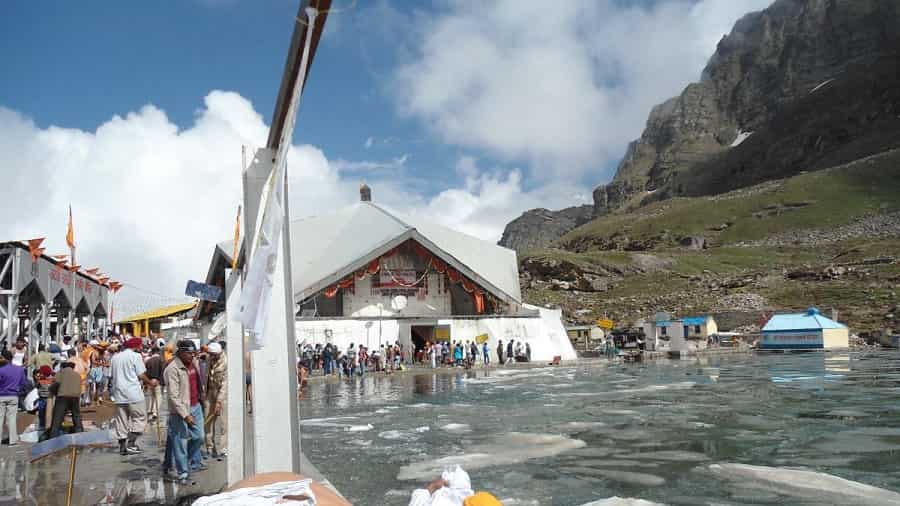
Significance of Hemkund Sahib
Hemkund Sahib is significant for Sikhs as it is believed to be the place where Guru Gobind Singh, the tenth Sikh Guru, meditated in his previous life. The shrine is also dedicated to the tenth Sikh Guru and is one of the most important pilgrimage sites for Sikhs. The glacial lake near the shrine is believed to have medicinal properties and is said to cure many ailments.
- Suggested Tour : Hemkund Sahib Tour Packages
Hemkund Sahib Opening Closing Dates
Hemkund sahib opening dates.
Hemkund Sahib opens for visitors every year in the month of May. The exact opening date of the shrine varies every year as it is dependent on the weather conditions. The opening date is decided by the Hemkund Sahib Management Trust and is announced a few weeks before the actual opening date. In 2023, the shrine opened on May 20th.
Hemkund Sahib Closing Dates
Hemkund Sahib closes for visitors in the month of October. The exact closing date of the shrine also varies every year and is dependent on the weather conditions. The closing date is announced by the Hemkund Sahib Management Trust a few weeks before the actual closing date. In 2023, the shrine closed on October 10th.
Best Time to Visit Hemkund Sahib
The best time to visit Hemkund Sahib is from June to September. During these months, the weather is pleasant, and the trekking conditions are favorable. The temperature during the day ranges from 10°C to 20°C, and the nights are chilly, with the temperature dropping to 0°C or below.
- Suggested Tour : Mountaineering Expeditions In The Indian Himalayas
How to Reach Hemkund Sahib
The nearest airport to Hemkund Sahib is Jolly Grant Airport in Dehradun, which is about 295 km away. The nearest railway station to Hemkund Sahib is Rishikesh, which is about 276 km away. From Rishikesh, you can hire a taxi or take a bus to reach the base camp at Govindghat. From Govindghat, the trek to Hemkund Sahib begins.
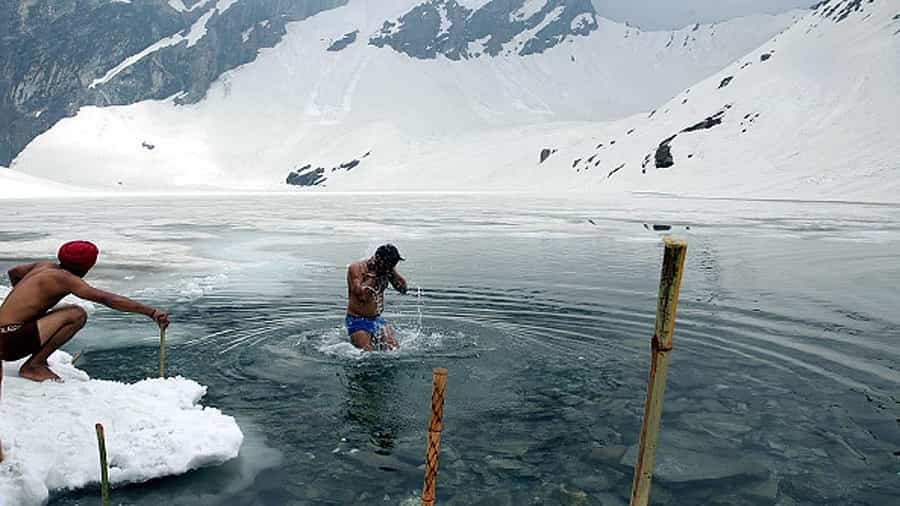
Accommodation at Hemkund Sahib
There are no hotels or guesthouses at Hemkund Sahib, and the only option for accommodation is the Gurudwara, which provides free accommodation and food for pilgrims. However, during peak season, the accommodation gets full quickly, and you might have to sleep in a dormitory with other travelers.
Things to Carry on Hemkund Sahib Trek
The trek to Hemkund Sahib is a challenging one, and you should be well-prepared for the journey. Here are some essential things that you should carry on the trek:
- Warm clothes
- Trekking shoes
- First aid kit
- Water bottle
- Snacks and energy bars
Hemkund Sahib Trek Difficulty Level
The trek to Hemkund Sahib is considered a moderate to difficult trek. The trek is about 19 km long and involves a steep climb of about 6 km. The altitude gain is significant, and the air gets thinner as you climb higher, making it difficult to breathe.
Safety Measures on Hemkund Sahib Trek
The trek to Hemkund Sahib is a challenging one, and you should take some safety measures to ensure your safety on the trek. Here are some safety tips that you should keep in mind:
- Acclimatize yourself before starting the trek
- Carry enough warm clothes to keep yourself warm
- Drink enough water to keep yourself hydrated
- Take breaks at regular intervals to rest and catch your breath
- Follow the instructions of your trek leader
Hemkund Sahib Trek Cost
The cost of the Hemkund Sahib trek depends on various factors, such as the mode of transportation, accommodation, food, and guide charges. On average, the cost of the trek can range from INR 8000 to INR 12000 per person.
Hemkund Sahib Trek Itinerary
Here is a typical itinerary for the Hemkund Sahib trek:
Day 1: Drive from Rishikesh to Govindghat (276 km, 9-10 hours) Day 2: Trek from Govindghat to Ghangaria (14 km, 6-7 hours) Day 3: Trek from Ghangaria to Hemkund Sahib (6 km, 4-5 hours) Day 4: Trek from Hemkund Sahib to Ghangaria (6 km, 3-4 hours) Day 5: Trek from Ghangaria to Govindghat (14 km, 4-5 hours) Day 6: Drive from Govindghat to Rishikesh (276 km, 9-10 hours)
Hemkund Sahib Trek Distance
The trek to Hemkund Sahib is a challenging one, and it is important to be physically fit and well-prepared for the journey. The trek covers a distance of around 19 kilometers, and it takes about 6-7 hours to reach the shrine from Govindghat, which is the starting point of the trek. The route is a steep climb, and it is advisable to take breaks at regular intervals to avoid exhaustion.
Hemkund Sahib is a place of spiritual significance and natural beauty, and the trek to this holy shrine is an experience of a lifetime. Before planning your trip, make sure you are well-prepared for the journey and follow all the necessary safety measures. The opening and closing dates of Hemkund Sahib are important factors to consider before planning your trip, as the shrine is only open for a limited time during the year. The trek to Hemkund Sahib is a challenging one, but the breathtaking views and the spiritual experience make it all worth it.
Q-1 What is the best time to visit Hemkund Sahib? Ans: The best time to visit Hemkund Sahib is from May to October, when the weather is pleasant, and the shrine is open for visitors.
Q-2 Is there any age limit for the Hemkund Sahib trek? Ans: There is no age limit for the Hemkund Sahib trek, but it is recommended that you are physically fit and well-prepared for the journey.
Q-3 Can I carry my own food on the Hemkund Sahib trek? Ans: Yes, you can carry your own food on the Hemkund Sahib trek, but make sure you carry enough snacks and energy bars to keep yourself energized.
Q-4 Are there any medical facilities available on the Hemkund Sahib trek? Ans: There are no medical facilities available on the trek, so make sure you carry a first aid kit and any necessary medications.
Q-5- Is it safe to trek to Hemkund Sahib? Ans: Trekking to Hemkund Sahib is generally safe, but it is important to follow all the necessary safety measures and precautions to ensure your safety on the journey.
Leave a Reply Cancel reply
Your email address will not be published. Required fields are marked *
Save my name, email, and website in this browser for the next time I comment.
This site uses Akismet to reduce spam. Learn how your comment data is processed .
About Valley of Flowers Trek
Touted as one of the most beautiful Himalayan treks, the Valley of Flowers is one of those few trekking expeditions that can be enjoyed during the monsoon season. The Valley of Flowers trek is a well-crafted package, wrapped in the colors of bliss.
Valley of Flowers "Foolon ki Ghati" is one of the most famous monsoon trek located in Uttarakhand, Himalayas. The best time to visit here is July to August. This valley was declared a National Park in 1982 and is famous for its rich flora and fauna, which includes a variety of colorful flowers along with rare and endangered species.
This whole vibrant valley is a combination of panoramic mountain ranges, lush green meadows, colorful flowers, and clouds which all together make it the best destination for nature lovers, photographers, and Botanists. There are so many fairy tales associated with this valley and the most common of them is falling unconscious from the scents of flowers. The Valley of Flowers trek starts from the pilgrimage trail of Govind Ghat, Uttarakhand.
It can easily be called the most colorful Himalayan Odyssey for the innumerable flower patches of vivid colours embellished with meandering mountain streams, dewy meadows snuggled in the lap of snow-capped mountains, a high altitude placid lake, holy rivers, and sacred pilgrimage sites.
The colossal beauty of this amazing array of colorful blossoms, which boasts of the largest collection of wildflower species, remains etched in your memory for the rest of your life.
The Valley of Flowers opens on 1st June till 31st October.
Quick Facts about Valley of Flowers Trek
- Region - Uttarakhand
- District - Chamoli
- Altitude - 14,100 feet
- Duration - 6 days
- Trekking distance - 38 km
- Difficulty level - Easy to moderate
- Start point- Joshimath
- Endpoint - Joshimath
- Base Camp - Ghangaria
- Nearest railway station - Haridwar
- Nearest airport - Jolly Grant Airport, Dehradun
- Last ATM - At Joshimath
- Best time to visit - July to August
Trek Details
- Start Point - Rishikesh.
- Departure Time from Rishikesh on Day 1- 6 a.m .
- Pickup point from Rishikesh - Natraj Chowk/Old Zostel Hotel, Tapovan.
- End Point - Rishikesh
- Arrival time at Rishikesh on Day 6 - Approximately 6 pm.
- Base camp - Joshimath
- Distance from Rishikesh to Basecamp, Joshimath is 250 km and takes around 8-10 hours.
- Treks end at Rishikesh on Day 6 at around 6 pm.
- Cloakroom: There is no separate cloakroom available. You can also hand over your lugguage to our team and collect it while returning. We will be keeping it at safely at Joshimath in the same Homestay.
- The Shared vehicle will be a Tata Sumo, Bolero, or similar and may be shared with a few other local passengers. The cab may be arranged partly from Rishikesh/Haridwar to Joshimath and Joshimath to Rishikesh/Haridwar.
- The cab is a 7-seater.
- We charge Rs.1200/- per person on each side per person.
- The whole cab costs 7500/- from Rishikesh for one side.
- Trekkers may choose to travel by bus or local cab to reach Joshimath.
- The forest permits for international clients will be as actual and are to be paid by the trekker at the basecamp only.
Distance between Delhi and the Valley of Flowers
The total distance between New Delhi and the Valley of Flowers is 519 kilometers.
You can travel to Govindghat from New Delhi in your car. It takes around 15 hours to cover a distance of 500 kilometres. However, this can be an expensive and very tiring journey. Also driving is not permitted after 8 PM on this route.
From Govindghat, you trek a distance of 19 kilometers to reach the Valley of Flowers via Ghangaria.
About Valley of Flowers
Very true to its name, the Valley of Flowers floors you with infinite flowers in full bloom. One can rename the trek as a floral fairytale romance!
An aesthetic valley bejeweled with a never-ending expanse of the flowers-the fascinating landscape of the Valley of Flowers is like a dream come true. The exquisite meadows peppered with endemic alpine flora are bedecked between the rugged mountain ranges of Zanskar and the Great Himalayas.
Privileged as a UNESCO World Heritage site, the area was declared a national park in 1982. Dotted with colorful blooms of pink, yellow, purple, red, blue, and orange hues, the infinite expanse of exquisite flora is the highlight of this trek. The floral fragrance from the carpeting flowers entices you throughout the trek. The virgin beauty of the valley allures botanists, flower lovers, bird watchers, wildlife photographers, trekkers, nature lovers, and adventure lovers from all over the world.
Valley of Flowers History/Story
Do you know that this trek was an accidental discovery by the British hiker, Frank Smith in 1931? It sure must have been the most beautiful accident of his life! For centuries, this enchanting fairyland lay undiscovered till Frank Smith and his two mountaineer friends went astray from their trekking path and accidentally reached a valley blanketed with flowers. They were left awestruck by this floral splendor and aptly named it “The Valley of Flowers”. Smitten by its beauty Frank Smith even penned a book named The Valley of Flowers. All trekking enthusiasts thank him for his most beautiful flawless accident!
Mythology about the valley
The local population always knew about the existence of this valley. To this date, they believe that the valley is inhabited by fairies and Gods. It was initially believed that whoever visited the valley was captured by the fairies and never returned back.
How to reach the Valley of Flowers
The nearest railway station is Haridwar which is well connected to the major cities of India. Nanda Devi Express is the best train to travel to Haridwar from Delhi.
From Haridwar, it takes around 10 hours by cab to cover the 280 km distance to reach Joshimath.
If you are looking for a pocket-friendly option then buses are your best bet to travel to Joshimath from Haridwar. 3 non-AC regular buses from G.M.O.U. Pvt. Ltd. ply daily from Haridwar to Joshimath.
Haridwar is easily accessible by road. The distance between New Delhi and Haridwar is around 218 kilometers. The fastest way to reach Haridwar from New Delhi is by cab which takes 3 hours 50 minutes.
You can even get buses for Haridwar from Anand Vihar ISBT, New Delhi. The buses leave at regular intervals every day and the journey takes around 6 hours. This is the cheapest option to reach Haridwar from New Delhi.
From Haridwar, you can hire a cab or take a bus to traverse the 280-kilometer journey to reach Joshimath.
You can reach Dehradun from Delhi by flight. There are daily flights available between the two cities, with a flying time of around 55 minutes. Dehradun is also well connected by flight with other cities like Mumbai, Kolkata, and Lucknow.
There are plenty of cabs/taxis available from Dehradun to Haridwar. It takes around 1 hour 45 minutes to reach Haridwar from Dehradun by cab.
Star attractions of the Trek
Nanda devi biosphere reserve-.
Sprawling in an area of 87.5 square kilometers, measuring 8 km in length and 2 km in width, the Nanda Devi biosphere is a kaleidoscope of colorful flowers. One of the most spectacular wildernesss in the lap of the Himalayas, Nanda Devi biosphere is flanked by Nanda Devi, India’s second-highest peak. This World Heritage site is blessed with a unique climate and soil conducive to diverse habitats, species, and ecosystems. According to a legend, Lord Hanuman had collected Sanjivani Buti at this place to revive Lakshman.
Flowers, flowers and more flowers -
Valley of Flowers treats you to a floral paradise, with a countless variety of blossoms carpeting the meadows and lacing the trekking trails. The quilt of blossoming flowers infuses new life into the valley; rich with color and the fragrant aroma of floral species! This Himalayan jewel is habitat to millions of wild flowers-poppies, calendula, daisies, Himalayan balsam, Himalayan hogweed, Himalayan Whorlflower, Himalayan Thyme, Marsh marigold, zinnia, petunias, lilies and many more.
Himalayan Whorlflower’s fragrant flowers change colors from pale pink to rosy red with time. Edelweiss flower, a symbol of purity and beauty, captivates you with its woolly white flowers. Edelweiss and Trailing Bellflower form a cluster and grow low on the ground. Spotting blue flowers in abundance is the rarest sight as blue is an unusual colour for flowers. Blue geraniums, blue poppy, blue daisy-like flowers, and tiny beautiful blue forget-me-nots invite visitors from all over the world. Some of the celebrated flowers like the Brahma Kamal, blue poppy, and cobra Lily are the rarest floral offerings of the valley.
Among the countless varieties of Himalayan blossoms, Blue Primula, known to be the most beautiful Himalayan flower can be seen blooming in infinite numbers in the valley. The monsoon season from mid-July to mid-August infuses a colorful kaleidoscope into the valley. You can witness the most amazing landscape when the valley is lit with the brightest hues against the contrasting patches of green grass and azure skies.
Amazing fauna-
Valley of Flowers lies in the core zone of the Nanda Devi biosphere which is home to rare and endangered species of animals, exotic mountain birds, and butterflies. Animals like Asiatic black bears, Musk deer, brown bears, snow leopards, blue sheep, and many more have made this biosphere their habitat.
Sacred rivers-
The beauteous road journey from Haridwar to Joshimath is flanked by the holy Ganges, gurgling below the cliff in a mystic green avatar. The pristine aura of the white-sand bed on the banks of the Ganges is highly captivating. You witness the confluence of the Bhagirathi and Alaknanda river to form the holy river the Ganges. The emerald green waters mesmerize you with the prolific abundance of their sheer beauty. It is magical to see the two rivers in different shades of green come together to form a single water body.
The confluence of the Pushpawati and Himganga rivers holds you in awe with their wondrous beauty. In addition to these two large confluences, you also witness three small river confluences on your eye-enticing road journey from Haridwar to Joshimath.
Sacred lake-
The awe-inspiring high-altitude lake Hemkund Sahib, at an elevation of 14,100 feet is a sacred site for Hindus and Sikhs. Hemkund means “The Lake of Snow” and true to its name the lake remains frozen for seven months in a year. The beautiful glacial lake lies huddled in the laps of Hathi Parvat and Saptarishi peaks as the glaciers originating from the peaks feed the lake. The crystal clear waters of Hemkund reflecting the view of surrounding seven snow-clad peaks and their glaciers is a sight to behold. The best view to watch out for is a small mountain stream called Himganga flowing out of the lake. As the weather gets warmer and the snow melts, there are sprouts of wildflowers, ferns, and moss on the banks of the lake. The glorious and elusive Brahma Kamal grows in plenty in the rocks on the banks of the lake. Legend has it that Guru Govind Singh, the tenth Guru of the Sikhs had meditated on the banks of this lake. Taking a dip in the holy waters of this serene lake is considered sacred.
Gurudwara and Temple-
Pay obeisance to the revered Guru Nanak Dev Sahib at the Shri Hemkund Sahib Gurudwara, the highest Gurudwara of the Sikhs, located at an elevation of 14,210 feet. Enjoy delicious langar in the Gurudwara premises, which are adjacent to the glacial lake of Hemkund. The lake is also flanked by a Lakshman Temple where you can offer prayers. These are the highest places of worship in India. People from all across India and the world visit this place of religious and spiritual parallelism to perform religious practice and seek salvation. Hemkund is inaccessible between October to April because of snowy paths and glaciers.
The sacred town of Joshimath is the winter seat of Lord Badri. Lord Badri’s idol is brought from Badrinath temple to Vasudeva temple at Joshimath during winter. This holy town is an important pilgrimage centre for the Hindus.
Ghangaria village-
Perched at an elevation of 10,200 feet, this cozy hamlet lies snuggled in the Himalayan embrace. The last human settlement in the Bhyundar valley, Ghangaria is flanked by the confluence of river Pushpawati (coming from Valley of Flowers) and river Himganga (coming from Hemkund Sahib). Watching the rustic life of people in this village brings you closer to nature. Learning about their culture, daily lifestyle, rich Pahari cuisine, and folk songs while sipping a cup of tea with them is the cherry on the cake.
Valley of Flowers best time
The Valley of Flowers remains open from June to October. Though every month showcases a new vista with varying shades of colors, mid-July to mid-August is considered the best time to visit the Valley of flowers trek when hundreds of blooms splash the valley with vibrant hues of luminous colors against the lush green backdrop.
As the snow melts and the weather gets warmer, the months of July and August are also alive with cascading waterfalls and beautiful glaciers.
Valley of Flowers weather
Summer months of April to June
Summer months infuse crisp freshness in the mountain air when the snow from the winter begins to melt. With rare sightings of mountain birds along with their melodious chirping, the place is a heaven for bird lovers during this season. The flowers just begin to bloom and the fragrance in the environment is palpable.
Winter months of October to February
Winter months from November to February showcase an entirely different landscape when flowers dry up and the once colorful region transforms into a frosty wonderland. The valley is not accessible during these months as it shuts down on October 31st. Visit the region if you are a snow lover and enjoy solitude in the company of glittering snow.
October can treat you to see the fall colors when the last lot of blooming flowers have bid adieu for the year.
Monsoon months of July to September
With the onset of monsoon, the valley is infused with fresh life and comes alive with vivid hues. The never-ending carpets of vibrant blossoms make for the perfect destination during this season. You witness the rarest and most beautiful of floral species; the colorful expanse akin to a picture taken from a book. Amidst this bouquet, the glossy green patches of fresh grass cast a magical glow to the place. The snow-clad mountains rising from a blanket of bright flowers seem to be kissing the sky. The whole valley emanates with the splendid aroma of floral species.
Exotic Himalayan birds and animals love the crisp ambiance of the season and can be spotted in good numbers.
The temperature is conducive during these months for touring the valley.
Valley of Flowers temperature
Temperature in summer months
The average temperature ranges from a minimum of 17 degrees Celsius to a maximum of 29 degrees Celsius.
Temperature in winter months
The average temperature varies from a minimum of 0 degrees Celsius to a maximum of 15 degrees Celsius. The days are warm but nights are bone-chilling.
Temperature in monsoon months
The average temperature ranges from a minimum of 20 degrees Celsius to a maximum of 26 degrees Celsius.
The difficulty level of the Valley of Flowers
A very well-paved trek, The Valley of Flowers is moderate to easy. The trek gradient is steep at some places, especially in the first and last 3 kilometres between Govindghat and Ghangaria but mostly the trek journeys through moderate ascents and descents. One can even take ponies or helicopter ride up to Ghangaria, the base camp of the trek. However, due to foggy and rainy weather conditions, the helicopter service is often interrupted during the monsoon season. From Ghangaria the only choice to reach the Valley of Flowers is by trekking. One can still get dolis or palanquins to take the elderly and kids from Ghangaria to the valley.
It is an easy trek as there are good facilities available throughout the trekking route.
Mobile connectivity at the Valley of Flowers
Bharat Sanchar Nigam Limited (BSNL) has installed a mobile tower at Ghangaria village and 2G mobile services are available within a 4 km radius from Ghangaria. Tourists visiting Hemkund Sahib and the Valley of Flowers can enjoy this 2G mobile service.
Is the Valley of Flowers trek recommended for beginners?
An easy-to-moderate trek, it is an absolute favorite among beginners/amateurs as well as avid trekkers. Interspersed with some steep paths, it is recommended that beginners come with good physical stamina and mental endurance to revel in this bounty of nature. Remember not to push yourself and compete with fellow trekkers. Enjoy the trek at your own pace and comfort.
Fitness required for Trek
Any trekking activity requires one to be physically and mentally fit and the same holds for the Valley of Flowers trek. It is advisable to start a 4-week fitness routine before undertaking the trek.
How to prepare for Trek
Getting fit is one of the important criteria to consider before undertaking any activity that is physically and mentally demanding. Let’s find out what goes into preparing for this trek.
- One can prepare for the Valley of Flowers trek by following a simple regimen for 4 weeks. Start with a 10-minute brisk walk followed by a 10-minute jog and a 10-minute slow walk in the first week.
- In the second and third weeks, reduce brisk walks to 5 minutes followed by an increased jogging time to 15 minutes and finally a 5-minute slow walk.
- In the 4th week, increase your stamina by doing a 5-minute brisk walk followed by a 25-minute jog.
Dressing up and trek essentials are some of the important points to be kept in mind while undertaking any trek.
- Among things to carry - a warm shirt, full sleeve t-shirt, thermal innerwear, water-resistant trekking pants, windproof and water-resistant jacket, waterproof gloves, raincoat, muffler, woolen cap, thick woolen socks, and comfortable hiking shoes are an absolute must.
- Sunglasses, sunscreen lotion, lip balm, a sturdy walking stick, a torch, and some essential medications are the trek essentials required for this trek.
Is Valley of Flowers Trek safe?
Uttarakhand is a land of simple people. Rooted deep in their culture, the inhabitants of Uttarakhand are down-to-earth people, very humble and polite. They are known for their warm hospitality. The Valley of Flowers is considered one of the safest treks.
Water availability at Valley of Flowers
It is extremely important to stay hydrated during any trekking activity. It is recommended that you carry a water bottle for the trek. There are numerous streams, taps, and water en route the trek and you easily refill your water bottle.
Day 1 : Pickup at Haridwar and drive to Joshimath
- Early morning(7AM) Pickup from Haridwar and arrival at Joshimath by evening.
- 290 Km Journey.
- 10 hour drive via Devprayag
- Altitude- 6,000 feet
- Nearby attractions: Nav Durga and Narsingh Temple.
- Highlights- Cruising through the curvy roads of Uttarakhand in the lap of towering mountains and the Ganges bubbling along, enjoying the beauty of tiny local hamlets, the confluence of Himalayan rivers
- Accommodation and food in Hotel.
You reach Haridwar on Day 1 and feast on a sumptuous breakfast before taking a cab to Joshimath. After travelling a distance of 290 kilometres in 10 hours you reach Joshimath.
The perfect road trip from Haridwar to Joshimath treats your mind and soul with its sheer spectacle. You will journey through beautiful valleys and hills via Rudraprayag, Devprayag, and Karnaprayag. Devprayag treats you to the emerald green confluence of the river Mandakini and Alaknanda river.
There are three more river confluences between Haridwar and Joshimath, which are smaller as compared to the confluence of river Mandakini and Alaknanda.
Day 2 : Drive till Govindghat and trek to Ghangharia
- Altitude- 6,000 feet to 10,200 feet
- Distance- 40 kilometre drive and 9 kilometre trek distance
- Time taken- 44-minute drive and 5-hour trek
- Highlights- Exploring the villages of Govindghat Ghangaria, enjoying the confluence of Pushpawati and Himganga rivers at Ghangaria
- Accommodation and food in Lodge.
Gorge on an early morning breakfast and take a cab to drive till Govindghat follwed by another 4 km drive till Pulna. It is the last motorable point for this trek. At a distance of 22 kilometres from Joshimath and perched at an altitude of 5,500 feet, Govindghat is a famous pilgrimage Centre for the Sikh community. It is the nearest town to the famous Hemkund Sahib Gurdwara and Hemkund lake.
From Pulna you trek 9 kilometres to reach Ghangaria (10,200 feet),which is the base camp for the Valley of Flowers. The trek traverses through a well-maintained stone path that can either be covered by walk or on a pony. After a walk of 5 km you get to see the clear and astonishing view of Hathi Parvath.
Day 3 : Ghangaria to Hemkund Lake and Gurudwara and back to Ghangharia
- Altitude gain- 10,000 feet to 14,200 feet
- 10 Km Trek.
- 7 Hours duration.
- Highlights- Soul-touching and life-enriching experience at Hemkund Sahib Gurdwara and Hemkund lake
Start your day early in the morning after having a hearty breakfast. A 10-kilometre trek, aka Hemkund Sahib Yatra, takes you to Hemkund Sahib Gurudwara and Hemkund lake. Hemkund Sahib Gurudwara is the world’s highest Gurudwara located at an altitude of 14,200 feet.
The last 5 km trek from Ghangaria to Hemkund Sahib is a steep climb. Many people prefer taking the uphill journey on a pony. Overnight stay is not allowed at Hemkund Sahib. It is advisable that you leave Hemkund Sahib by 2 p.m. so that you reach back Ghangaria before nightfall.
Day 4 : Ghangaria to the Valley of Flowers and back to Ghangaria
- 10,000 feet to 12,800 feet
- 4 Hours Duration.
- Highlights- Soaking your soul in the fresh and colourful ambience of the Valley of Flowers
You start your day early so that you get ample time to spend in the beautiful Valley of Flowers. Today’s 5-kilometre trek is not very steep and journeys through almost the same level throughout. It brings you to the most colourful valley bedecked with exotic flowers of various hues. This colourful panorama complemented with snow-clad mountains, white clouds and gliding river crossing through the valley is like a painted canvas.
Being a biological reserve, ponies are not allowed to enter the valley.
Spend some time in this bounty of nature before heading back to Ghangaria for an overnight stay.
Day 5 : Trek from Ghangaria to Govindghat and then drive to Joshimath
- 14 km trek distance and 22 kilometres drive
- Highlights-Reliving Day 2, enjoying the scenic vistas of Govindghat, Ghangaria, and Joshimath
- Accommodation and food in Lodge/Hotel
On Day 5 we will trek back to Govindghat, which is a 14 Km/5 Hours trek. After reaching we drive back to Joshimath and stay overnight at local hotels/guest house.
Day 6 : Drive from Joshimath to Haridwar
- Breakfast in Joshimath
- 290 Km Journey
- 10 hour drive
- Will reach Haridwar by 7 PM
Valley of Flowers Trek
₹ 8299 /- ₹ 8999 /- (₹ 700 off), payment secured by.

Talk to our Adventure Expert
Trek packages, valley of flowers trek ( 6 days / 5 nights ), trek highlights, trip length, aprox 38 km, max altitude, difficulty level, pickup location, droplocation, start point, july to august, cancellation policy, health and saftey.
- Weekend +91 87 6262 3333
- Himalayan +91 9886 444 809
- International +91 84968 85968
- [email protected]
- One Day Treks
- Two Day Treks
- Himalayan Treks
- International Treks
- Private Treks
- Group Adventures
![Valley of Flowers Trek and Hemkund Sahib [Premium] - Tour Valley of Flowers Trek and Hemkund Sahib [Premium] - Tour](https://vl-prod-static.b-cdn.net/system/images/000/326/464/f004eeac1383bb5aea2b18eb9400c343/x600gt/VOF_Banner.png?1684915067)
- Valley of Flowers Trek and Hemkund Sahib [Premium]
- Secure & Easy Booking
- Best Price Guaranteed
- 1000+ Happy Customers
Secure your registration with just a 20% deposit today and pay the remainder 30 days before the departure date. Your journey awaits! ✈️
Valley of Flowers trek is one of the most beautiful treks in India, this also happens to be one of those treks where a lot of trekkers begin their journey of exploring the Himalayas. Located in the Nanda Devi Biosphere, Valley of Flowers is a UNESCO World Heritage site and also India's largest natural botanical garden. One of Uttarakhand's most scenic destinations is the two adjoining treks, Valley of Flowers and Hemkund Sahib conveniently positioned between Joshimath and Badrinath. Ghangaria to Valley of Flowers can be conveniently covered as well. Ghangaria to Valley of Flowers distance is 4km. Joshimath to Valley of Flowers distance is 21km.
Visit the abode of various species of flowers!
Valley of Flowers altitude around 3,600 m. The Valley of Flowers National Park opens up in a floral splendour from June up until September every year. A good 500 different species bloom and carpet the valley during this time. The riot of colours that trekkers get to see during this time period is beyond what words can describe. For us, the best time to visit the Valley of Flowers is anywhere between mid of July - August end.
Valley of Flowers Himalayas - Acclimatize in Auli
On the trek to the Valley of Flowers, you will be acclimatising in Auli. It is India's most popular ski destination - Auli on the first two days of the trek. Head out to the beautiful Gorson Bugyal for an acclimatization trek.
Visit here to check out Valley of Flowers trek difficulty .
Have hot langar by an Alpine Lake at 15,200 ft (4,633 m)
The Valley of Flowers trek is incomplete without an exhilarating climb to the world's highest Gurudwara Shri Hemkund Sahib. Nestled in the backdrop of the pristine Hemkund lake is the holy Gurudwara which is visited by thousands of devotees and trekkers every year. The highest valley of flowers height in feet is 15,200. ( Click here to read a detailed photo blog on our Hemkund Sahib Trek )
Visit Panch Prayag
Travel via the five sacred river confluences in the Garhwal Himalayas. Devprayag, Rudraprayag, Karnaprayag, Nandaprayag and Vishnuprayag in the ascending flow sequence of their occurrence.
- Devprayag is the confluence of the two holy rivers, the Bhagirathi - the chief stream of the Ganges and the Alaknanda. It is the first Prayag on the way to Badrinath. Beyond this confluence, the river is known as the Ganges.
- Rudra Prayag is the confluence where the river Alaknanda meets the Mandakini River. The confluence is named after the god Shiva, who is also known as Rudra.
- Karn Prayag is the location where the Alaknanda River is joined by the Pindar River which originates from the Pindar glacier, below the Nanda Devi Mountain range.
- Nandaprayag is the confluence where the Mandakini River joins the main Alaknanda River.
- Vishnuprayag - The Alaknanda River, which originates from Satopanth glacier is joined by the Dhauli Ganga River near Joshimath (on Joshimath - Badrinath route). Alaknanda flows in front of the Badrinath temple, one of the most revered Hindu shrines.
Visit here to check out Valley of Flowers trek best time .
The stunning views on Valley of Flowers Uttarakhand trek!
The trail to Gorsan Bugyal gives you a good close-up view of the revered Mt. Nanda Devi along with other peaks such as Mt. Chaukamba, Mt. Dronagiri, Hathi Parvat, Ghoda Parvat and many more. All of this makes this trek a perfect escapade from the monotony of daily life. The landscapes will surely make you fall in love with photography.
Hemkund Sahib Valley of Fllowers trek- See animals that reside in the Biosphere
Valley of Flowers location is endowed with a diverse range of endemic flora, it is picturesque in its beauty. This lush region is also home to some rare and endangered animal species. You may spot animals like Asiatic Black Deer, Snow Leopard, Musk Deer, Red Fox, Brown Bear, and Blue Sheep.
Important Valley of Flowers trek Links:
- For queries regarding the trek: Go to our Valley of Flowers FAQs page and find answers to all your question.
- For a detailed guide on Valley of Flowers: Read this comprehensive Valley of Flowers Guide to help you understand all you need to know about the Valley of Flowers trek!
- To see how the Valley looks during the monsoons: Check out this photoblog of 45 stunning pictures captured during the monsoon trek to Valley of Flowers .
- How to get fit for the Valley of Flowers trek: Click here to read a detailed blog on preparing for the Valley of Flowers trek.
- Wondering what to carry for the trek: Read this blog with a detailed list of things to carry for the Valley of Flowers trek .
- Visit here to know more about the Valley of Flowers trek package .
- Visit here for Valley of Flowers trek cost and dates.
- Visit here for Valley of Flowers trek itinerary .

- 5 Treks in one trip
- Acclimatization trek to Gorson Bugyal in Auli
- Trek to Hemkund Sahib - The highest Gurudwara in the world
- Trek to the Valley of Flowers - Explore the depths of this UNESCO World Heritage Site
- Witness over 500 different species of alpine flowers during the Valley of Flowers trek in Uttarakhand
- 2 Night stay in Auli - Ski destination of India
- Travel via the Holy Confluences of River Ganga (Devprayag, Rudraprayag, Karnaprayag, Nandprayag, Vishnuprayag).
- Visit one of the four Char Dham's - Badrinath & India's last village Mana ( Photoblog of the trip to Badrinath & Mana )
You need more information?
- Day 1 - Arrive at Rishikesh
- Day 2 - Travel to Auli (Travel via the 4 holy confluences of River Ganga - Devprayag, Rudraprayag, Karnaprayag, Nandprayag)
- Day 3 - Acclimatization trek to Gorsan Bugyal
- Day 4 - Drive to Govindghat via Joshimath and Trek to Ghanghariya
- Day 5 - Trek to Hemkund Sahib - Highest Gurudwara in the World
- Day 6 - Trek to Valley of Flowers - UNESCO World Heritage Site
- Day 7 - Trek to Govindghat from Ghanghariya and travel to Badrinath and Mana* (Travel via the 5th holy confluence of River Ganga - Vishnuprayag). Ghangaria to valley of flowers distance is 4 km.
- Day 8 - Travel to Rishikesh
- Day 9 - Travel back to your city
Valley of Flowers Trek Detailed Itinerary:
Day 1: rishikesh.
Altitude: 1,030 ft (312 m)
Arrive in Rishikesh and check in to the hotel. Meet your fellow trekkers in a meet and greet session where you will also be prepped for the upcoming Valley of Flowers Trek . In the evening, head out to witness the magnificent Ganga Arati at the Triveni Sangam and explore the authentic local cultures of India. Stay the night at Rishikesh.
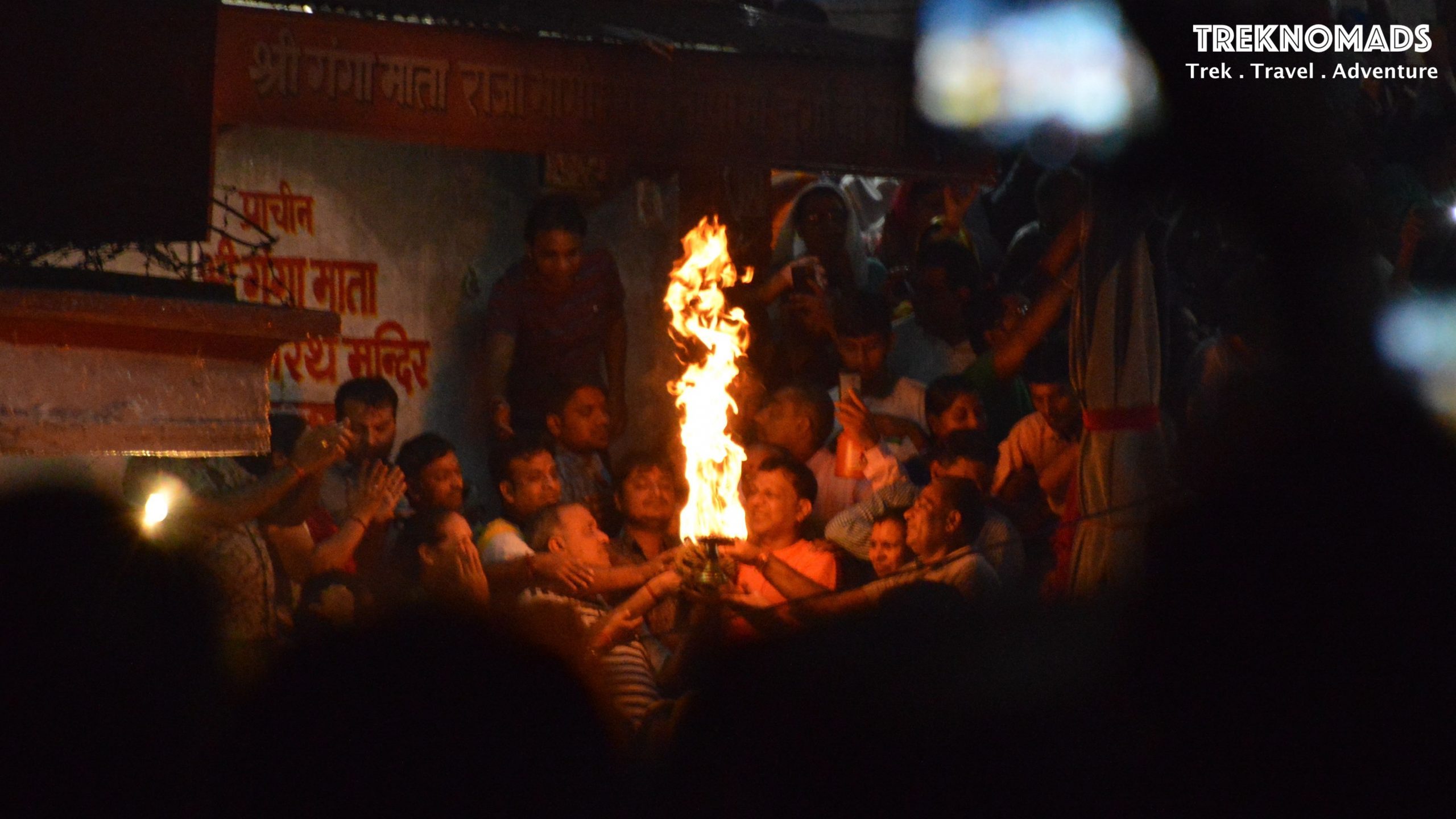
The revered Ganga Arati is something that we do not miss during our treks in Uttarakhand.
Day 2: Auli
Altitude: 8,202 ft (2,500 m)
Travel Distance / Duration: 270 kms / 8-10 hours
On day 2 of hemkund sahib valley of flowers trek, you start your journey from Rishikesh to Auli. Witness the four confluences of the sacred River Ganga (Devprayag, Rudraprayag, Karnaprayag, Nandprayag) en route and also get the very first glimpse of the snow-clad peaks when you're about to arrive in Auli. Check in to the hotel and stay the night at Auli.

The drive from Rishikesh to Auli is super rewarding with views of endless mountains and rivers flowing alongside.
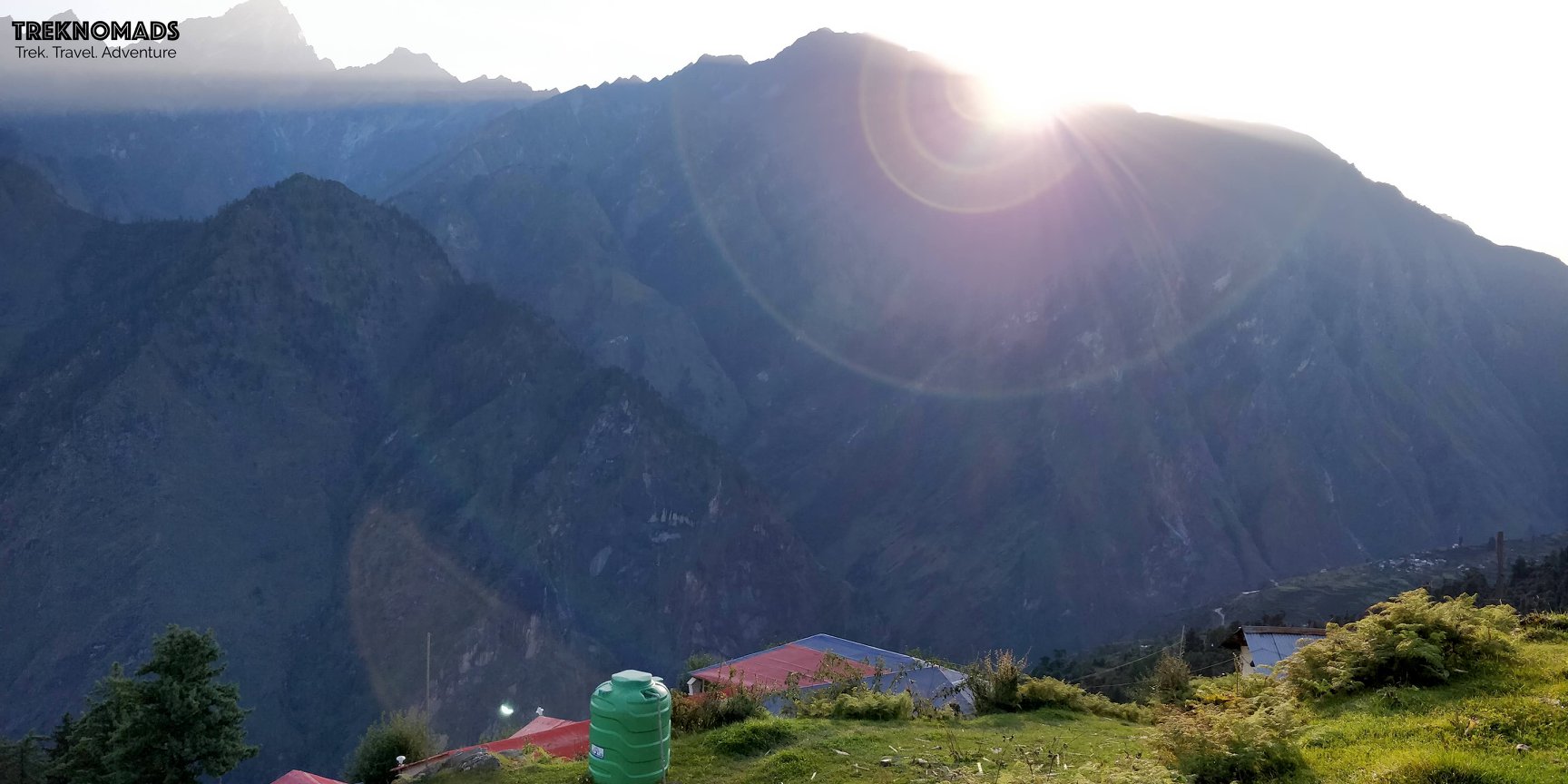
We thrive for sunrises, and the sunrise on your first morning in Auli is something you should definitely not miss!
Day 3: Gorsan Bugyal
Altitude: 10,544 ft (3,214 m)
Trek Distance / Duration: 7-8 kms / 5 hours
According to day 3 of valley of flowers uttarakhandvalley of flowers trek itinerary, wake up early in the morning and head out on an acclimatization trek to the extremely beautiful Gorsan Bugyal. Valley of flowers height is 13,000 ft. So acclimatisaion is important. Pass through one of India's high altitude man-made lakes - Chenab Lake and also get a good view of the revered Mt. Nanda Devi along with other peaks such as Hathi Parvat, Ghoda Parvat and Mt. Dronagiri. Stay the night in Auli.
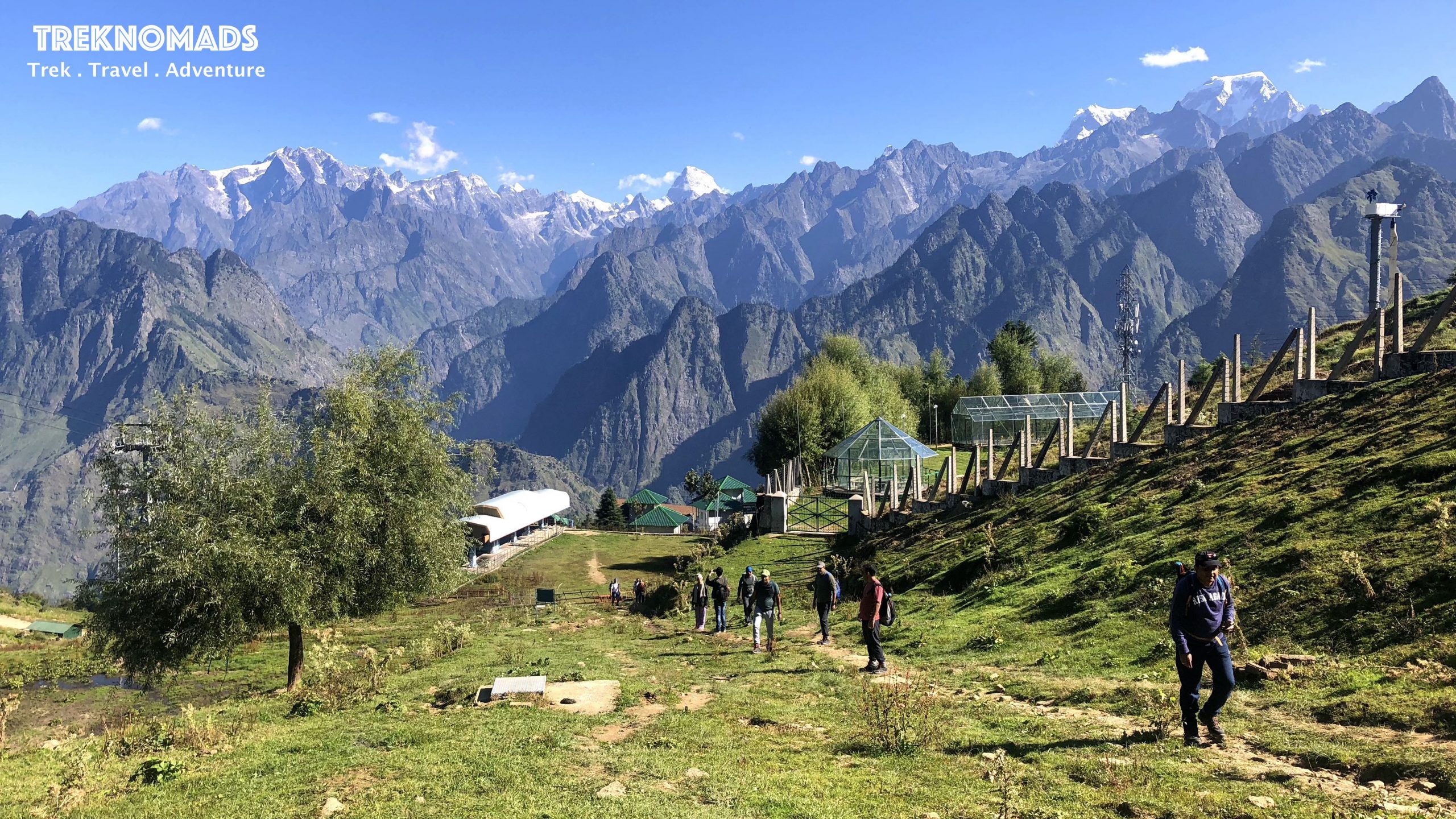
The trek to Gorson Bugyal is quite a sight to behold as seen in the picture. The further you trek, the more the snow clad mountains open up. Best time to visit valley of flowers is June onwards.
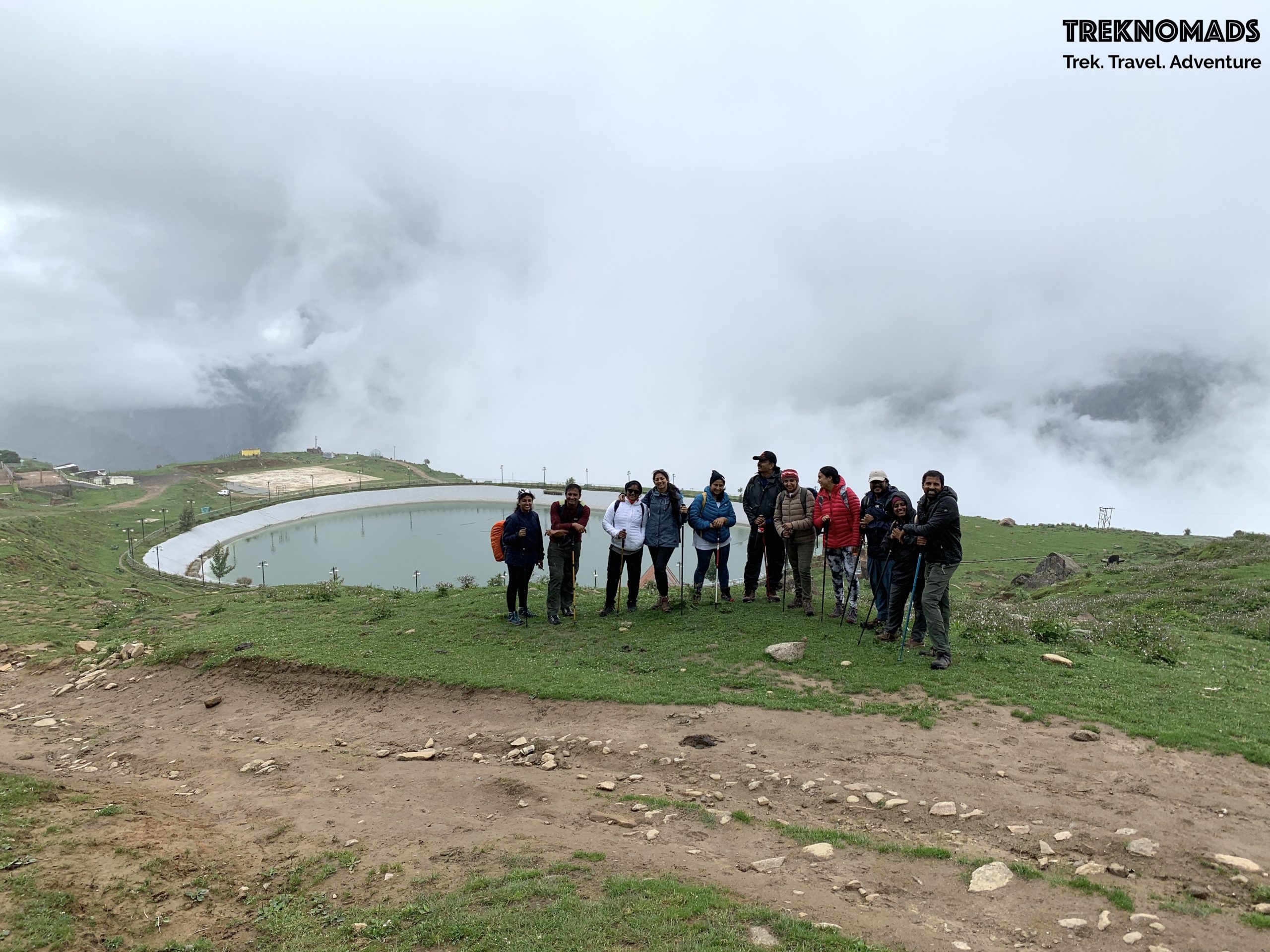
One of the attractions of the Gorson Bugyal trek is the man-made lake you see on the way.
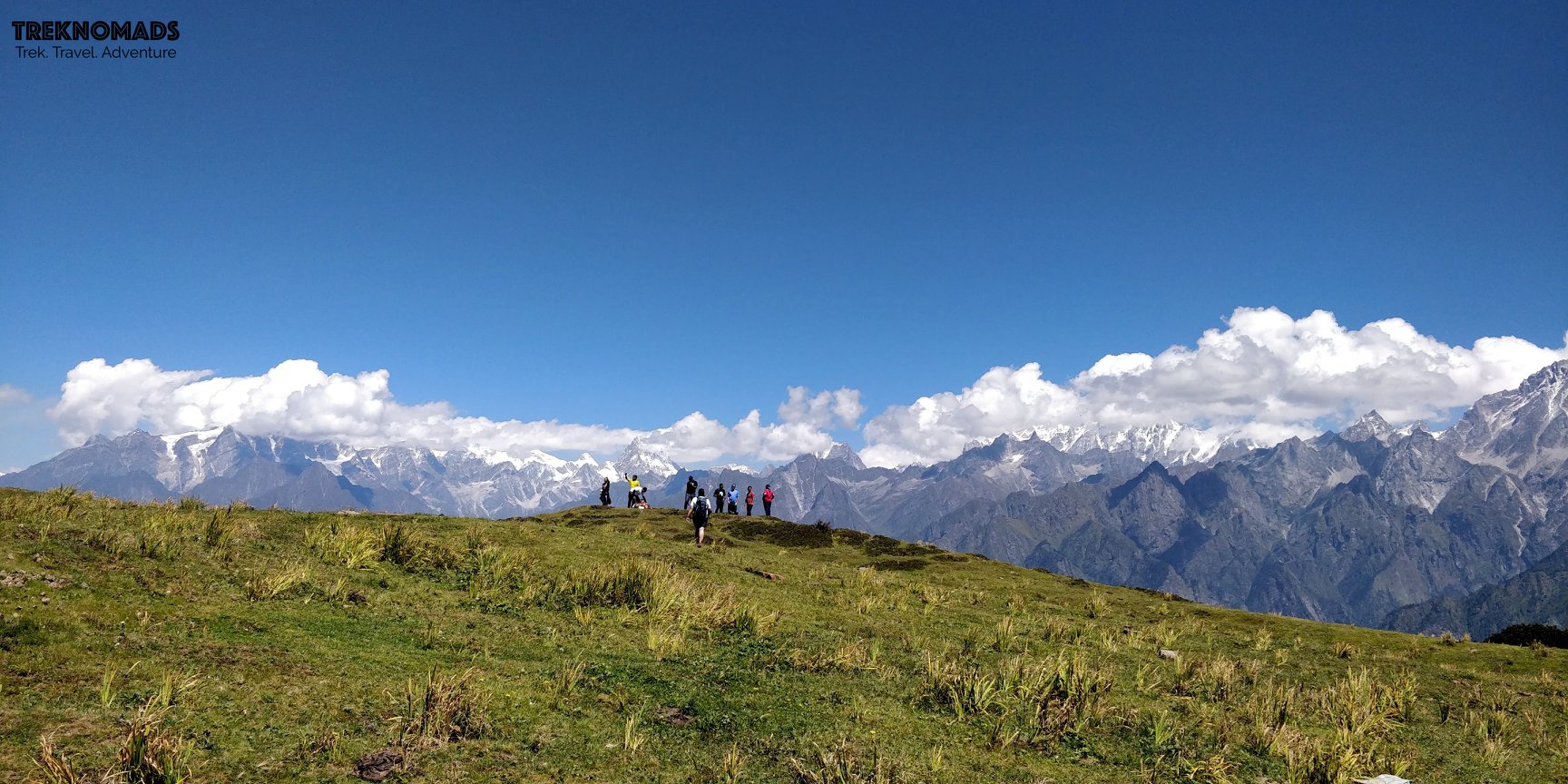
The view after reaching Gorson Bugyal is incredibly satisfying.
Day 4: Govind Ghat to Ghangariya
Altitude: 10,003 ft (3,049 m)
Trek Distance / Duration: 10 kms / 5-6 hours
On Day 4 of the valley of flowers trek uttarakhand, you start your journey towards Govindghat via Joshimath and then start your trek to Ghangariya.The route all through to Ghangariya from Govindghat is man-made with rest stops, shops all along the way. You will also find a lot of pilgrims trekking up to Gurudwara Shri Hemkund Sahib. Get a good glimpse of the confluence of Bhyunder Ganga and river Pushpavati which forms the Lakshman Ganga. Stay the night in Ghangariya. DM us to check valley of flowers trek package.
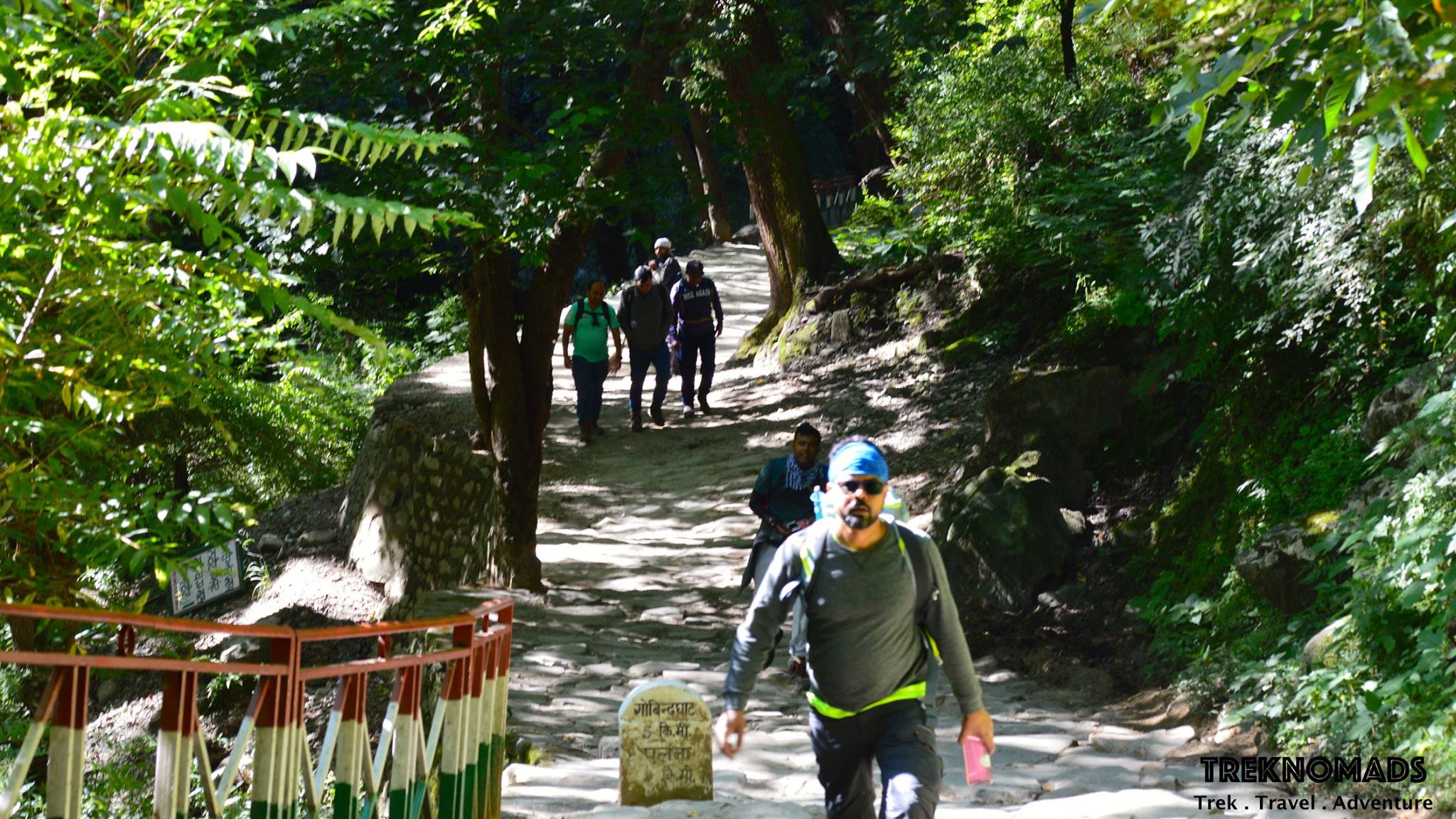
The well-made trail to Ghangariya offers many rest stops, dhabas and washrooms/water fill-up points.
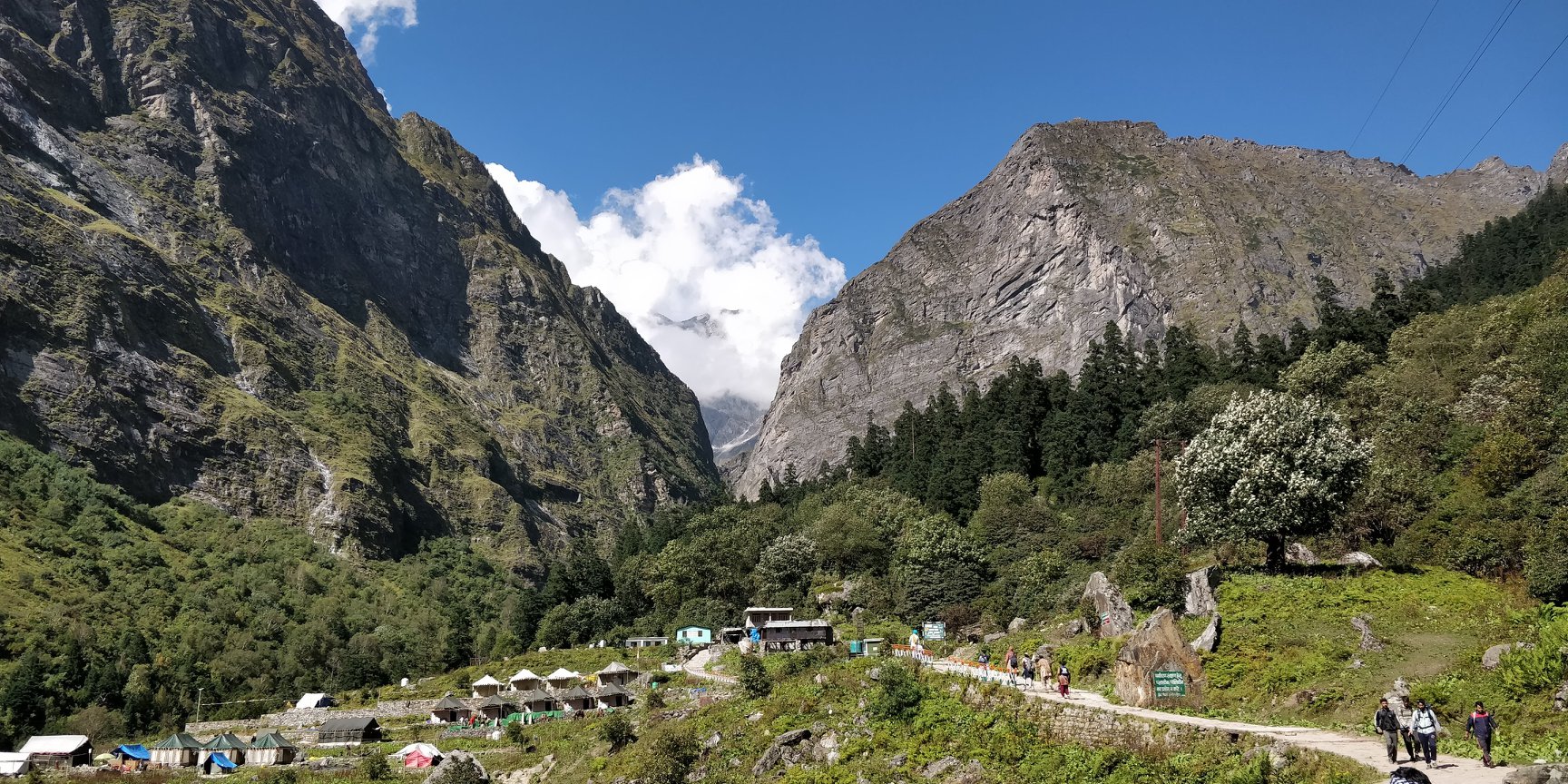
The first glimpse of Ghangariya
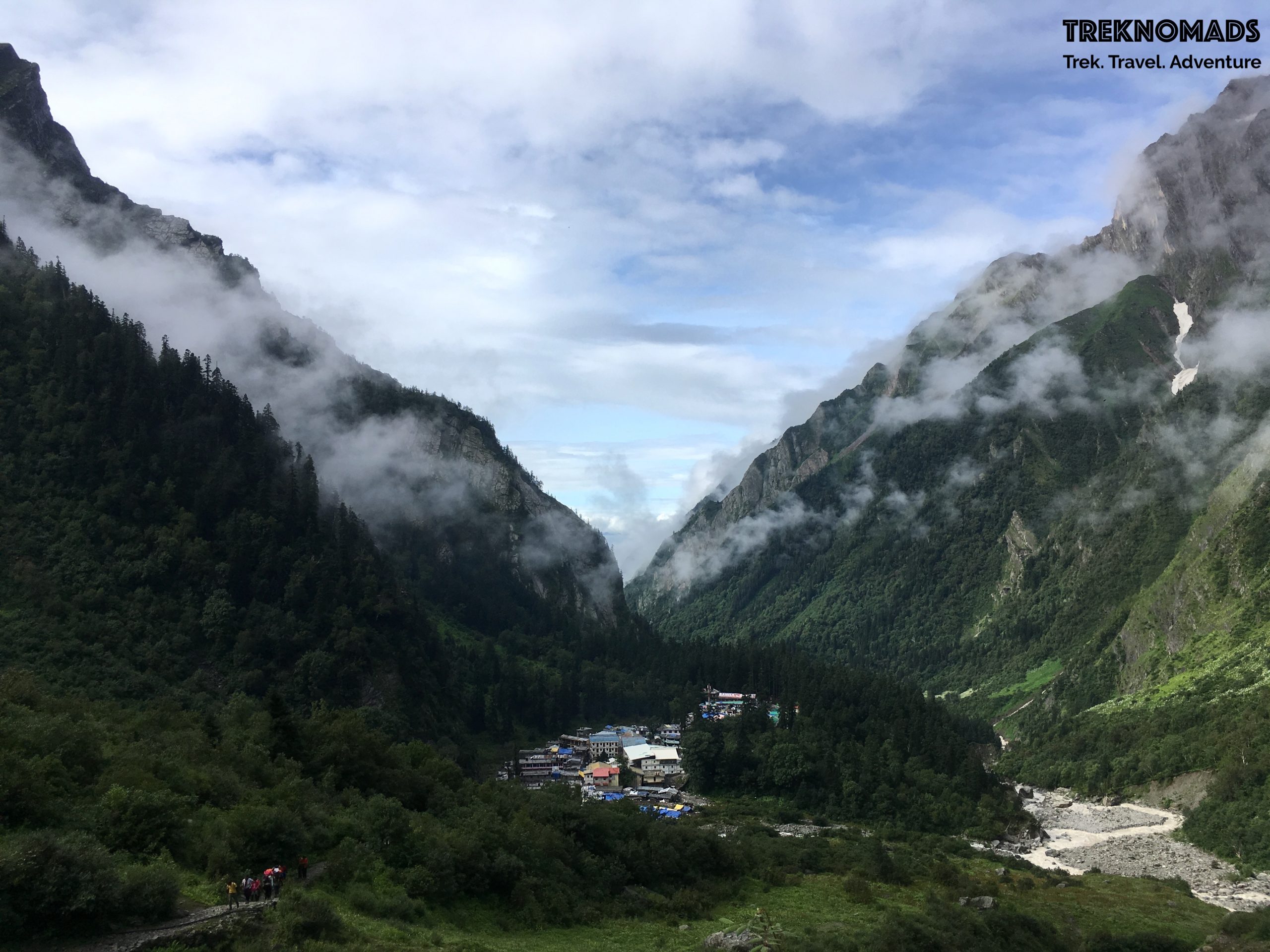
A birds-eye view of the small town of Ghangariya nestled amidst the mountains. This view can be seen from the Hemkund Sahib trek trail.
Day 5: Hemkund Sahib
Altitude: 15,200 ft (4,633 m)
Trek Distance / Duration: 14 kms / 7-8 hours
Today's trek to the Gurudwara is tedious yet the whole vibe is extremely pious and positive. You can hear the chants from the Gurudwara all through the trail. The winding trail also passes through a forested region before opening up and giving you a glimpse of the surrounding peaks. After paying your respects at the Gurudwara you can also visit the gorgeous alpine lake - Hemkund, behind the Gurudwara. Stay the night in Ghangariya.
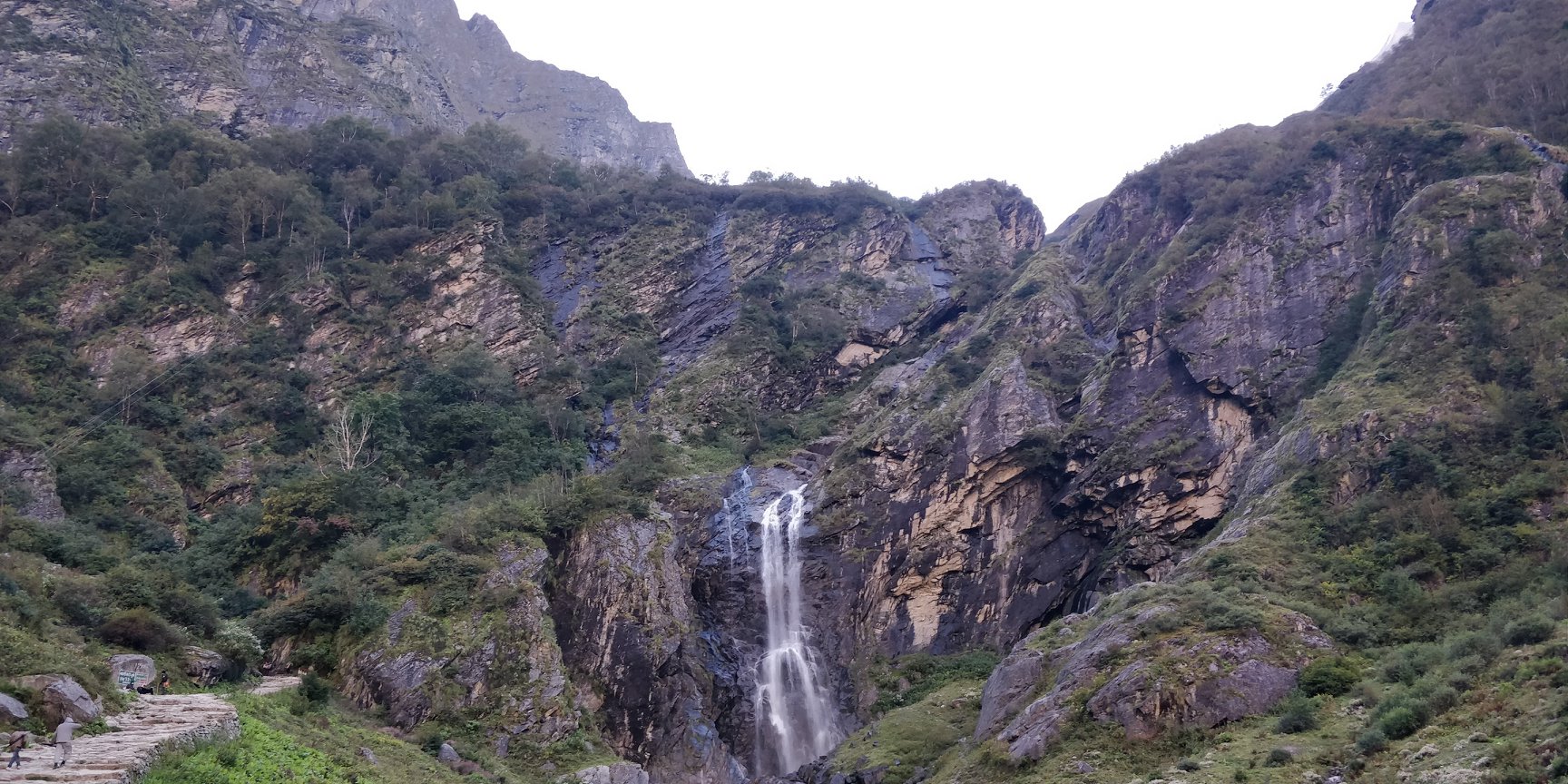
The highlight at the start of the Hemkund Sahib trek is this perennial waterfall. What you see on the extreme left is the trail to Hemkund Sahib.
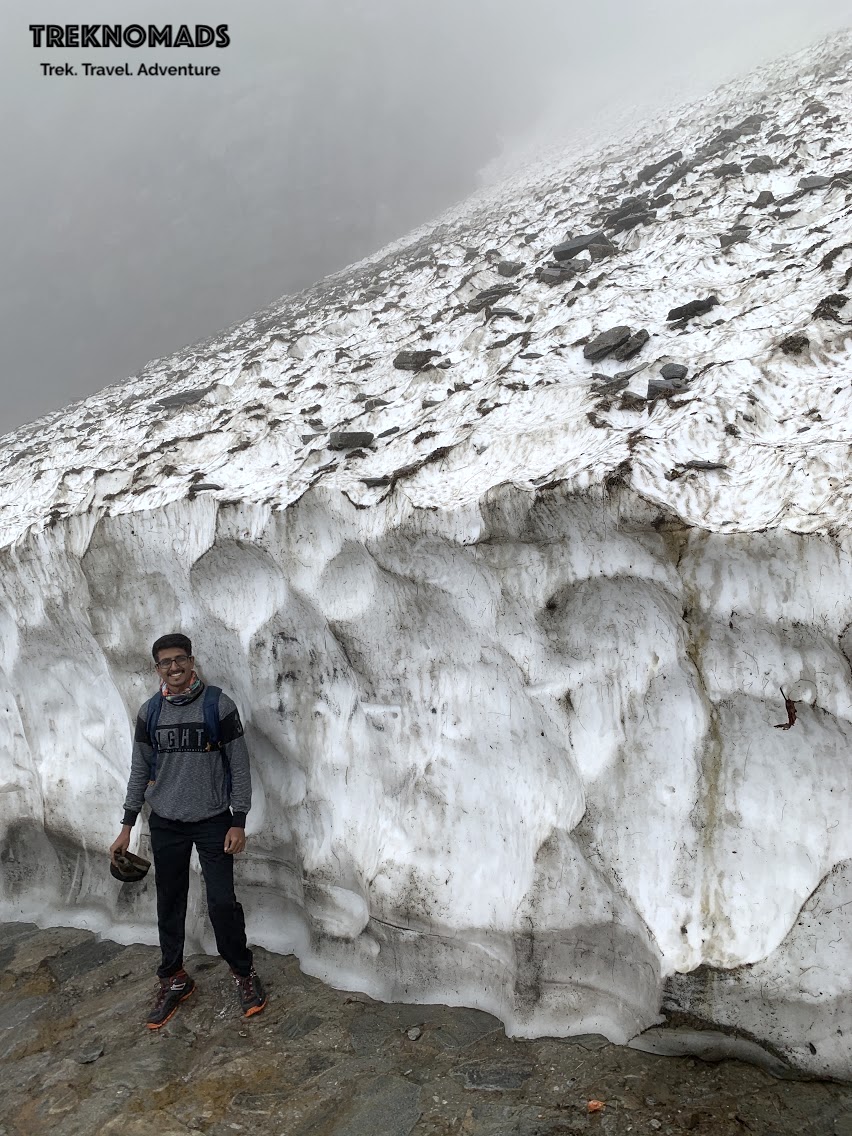
In early June and July, you can find ice on the Hemkund Sahib trail, making this trek even more thrilling.
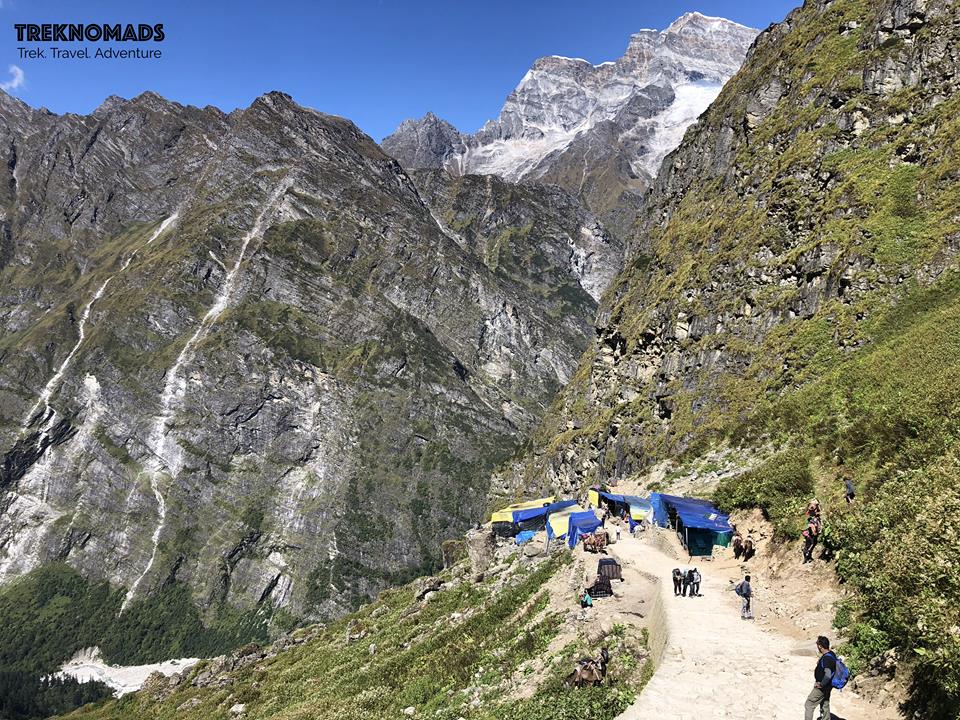
The long and steep trail to Hemkund Sahib, this is where your endurance gets tested.

The first glimpse of the Gurudwara and you can see a small sneak peek of the lake Hemkund behind the Gurudwara.
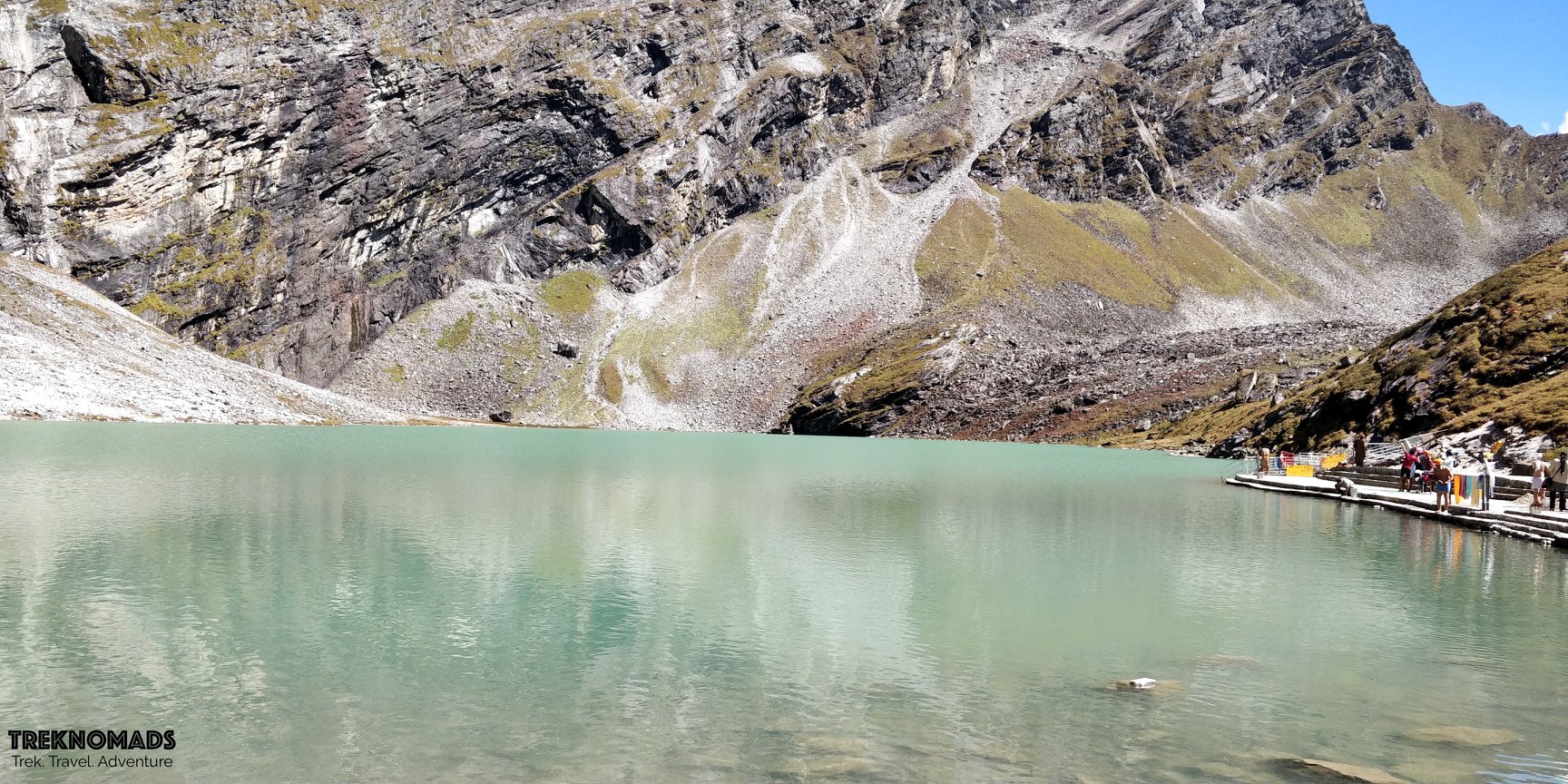
The pristine and diving Hemkund Lake.
Day 6: Valley of Flowers Trek
Altitude: 12,002 ft (3,658 m)
Trek Distance / Duration: 7-8 kms / 5-6 hours
Trek to the UNESCO's World Heritage site, the Valley of Flowers trek. Visit the famous Legge's grave and some of the most picturesque spots in the valley. Stay the night in Ghangariya.
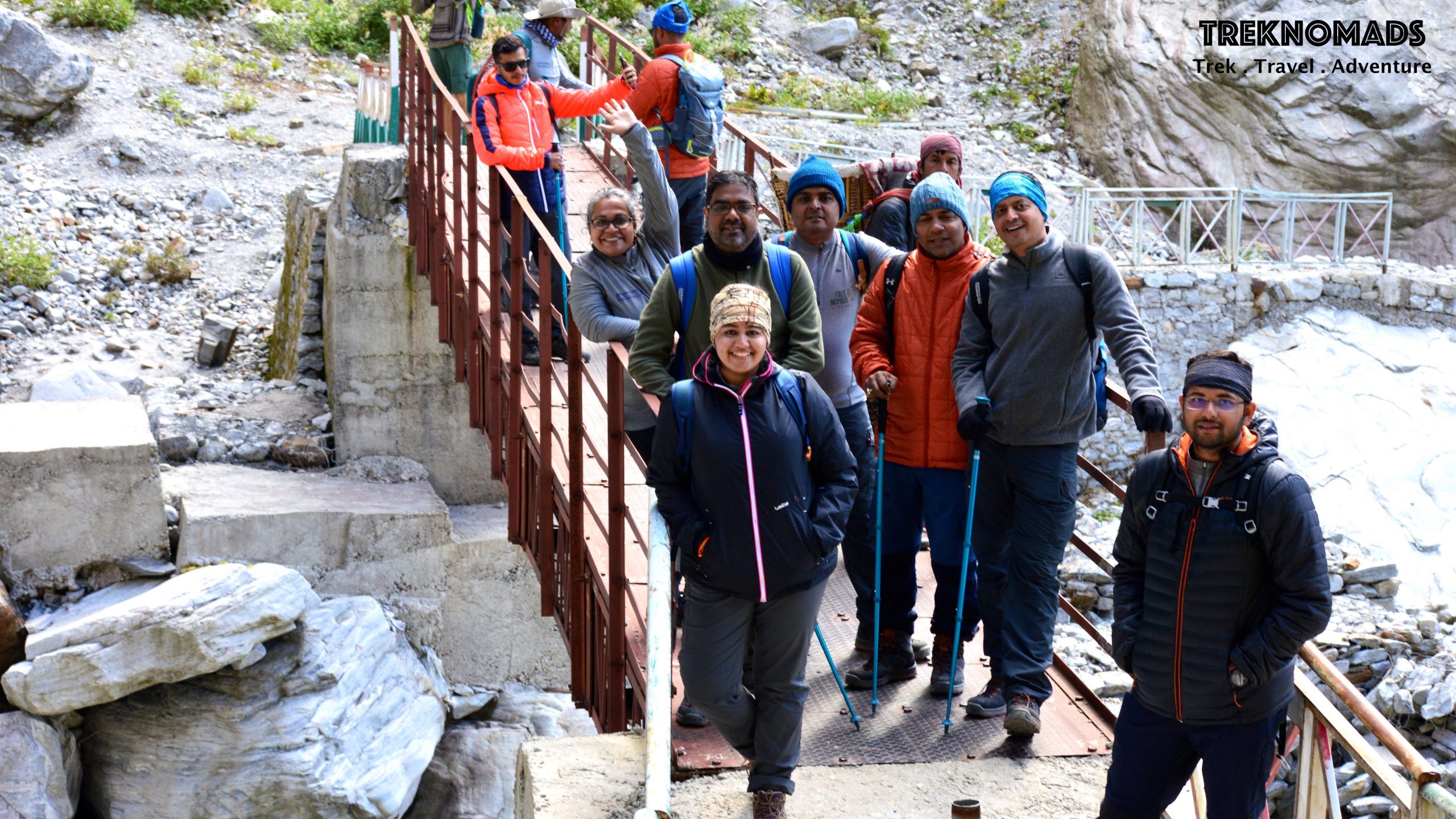
The iconic bridge that you cross at the start of the Valley of Flowers trek.
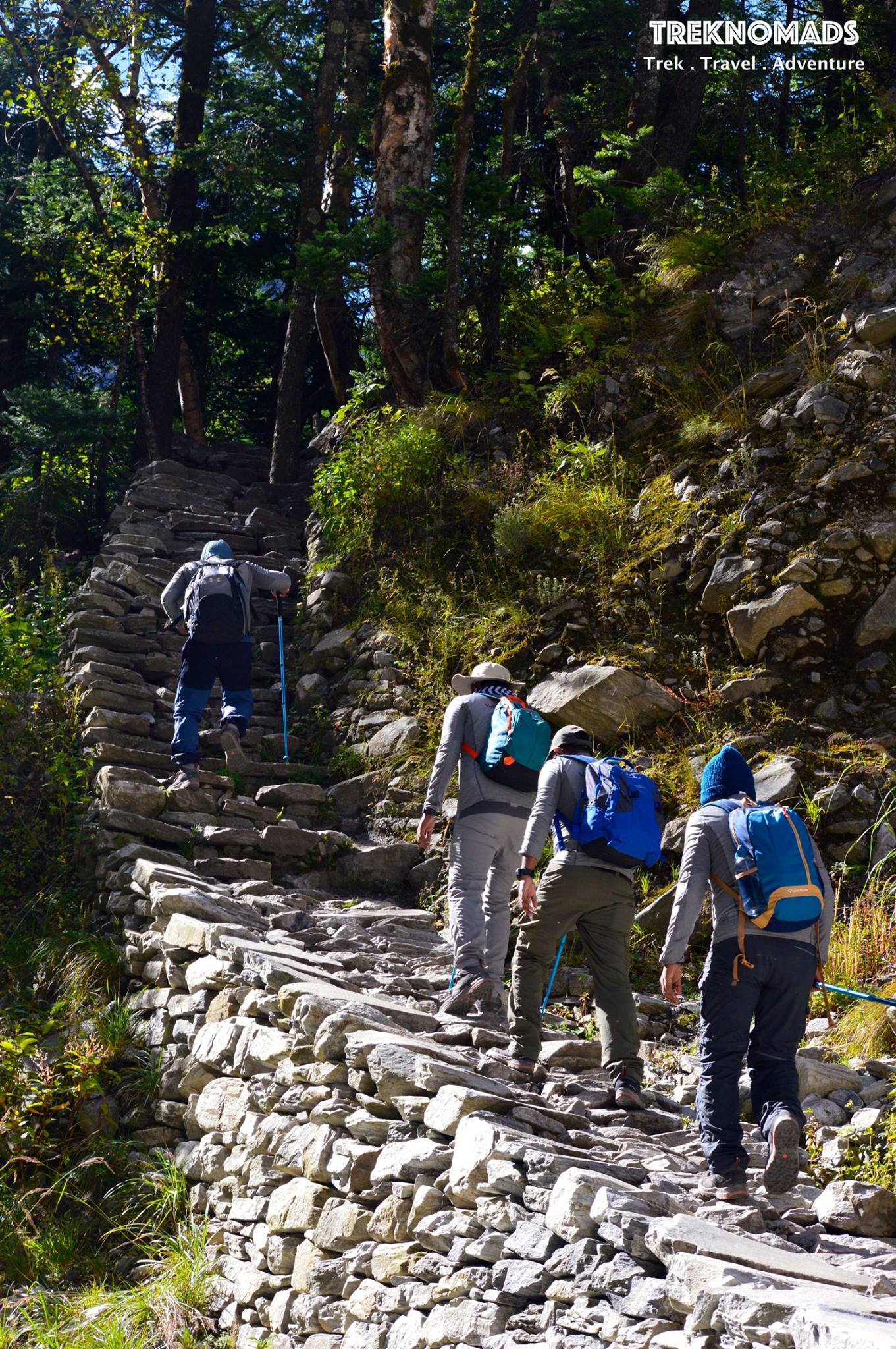
The rocky trail that you have to climb through a small forest before reaching the opening.
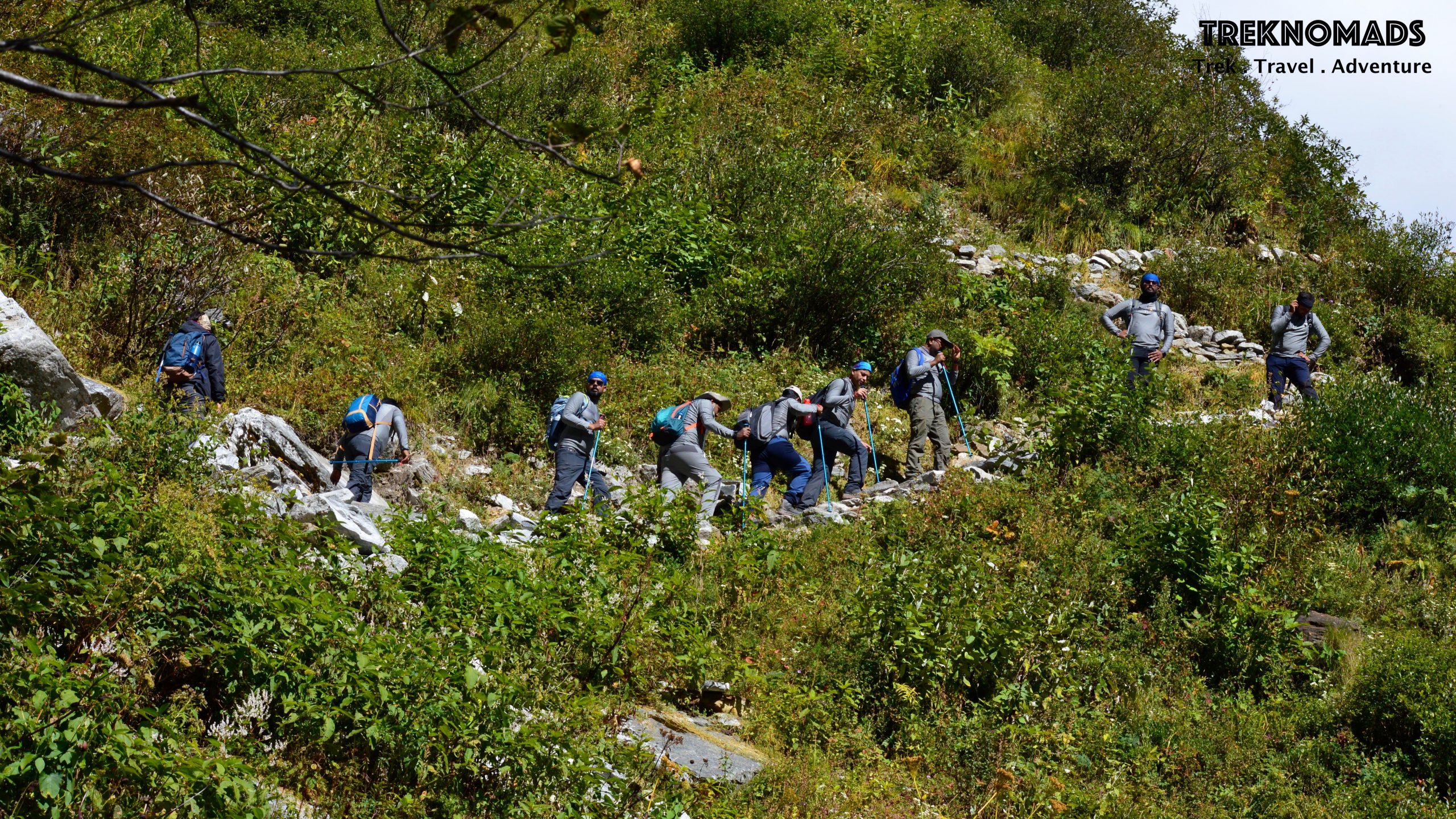
The trail once the rocky path opens up.
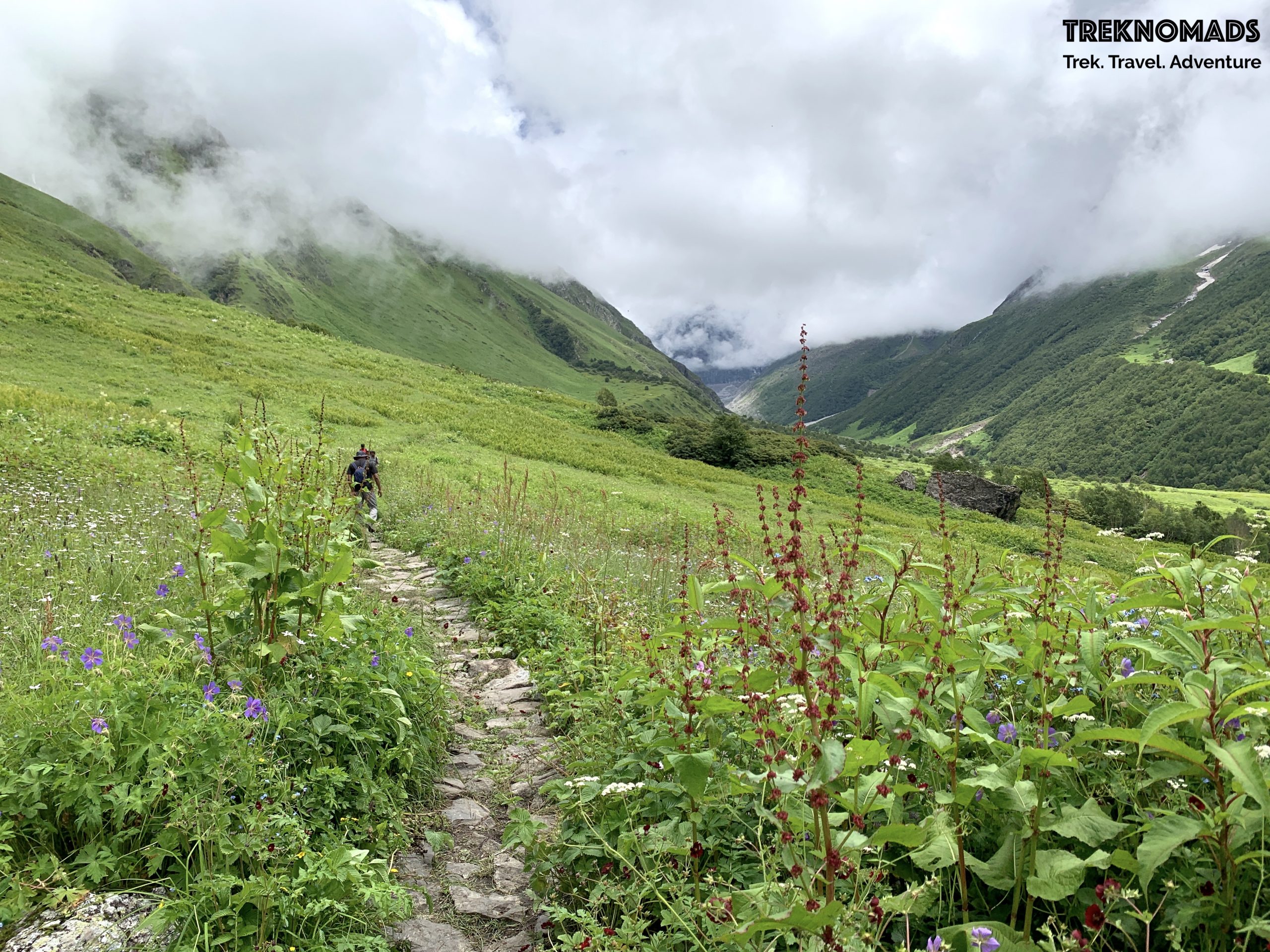
Entering the gorgeous Valley of Flowers!
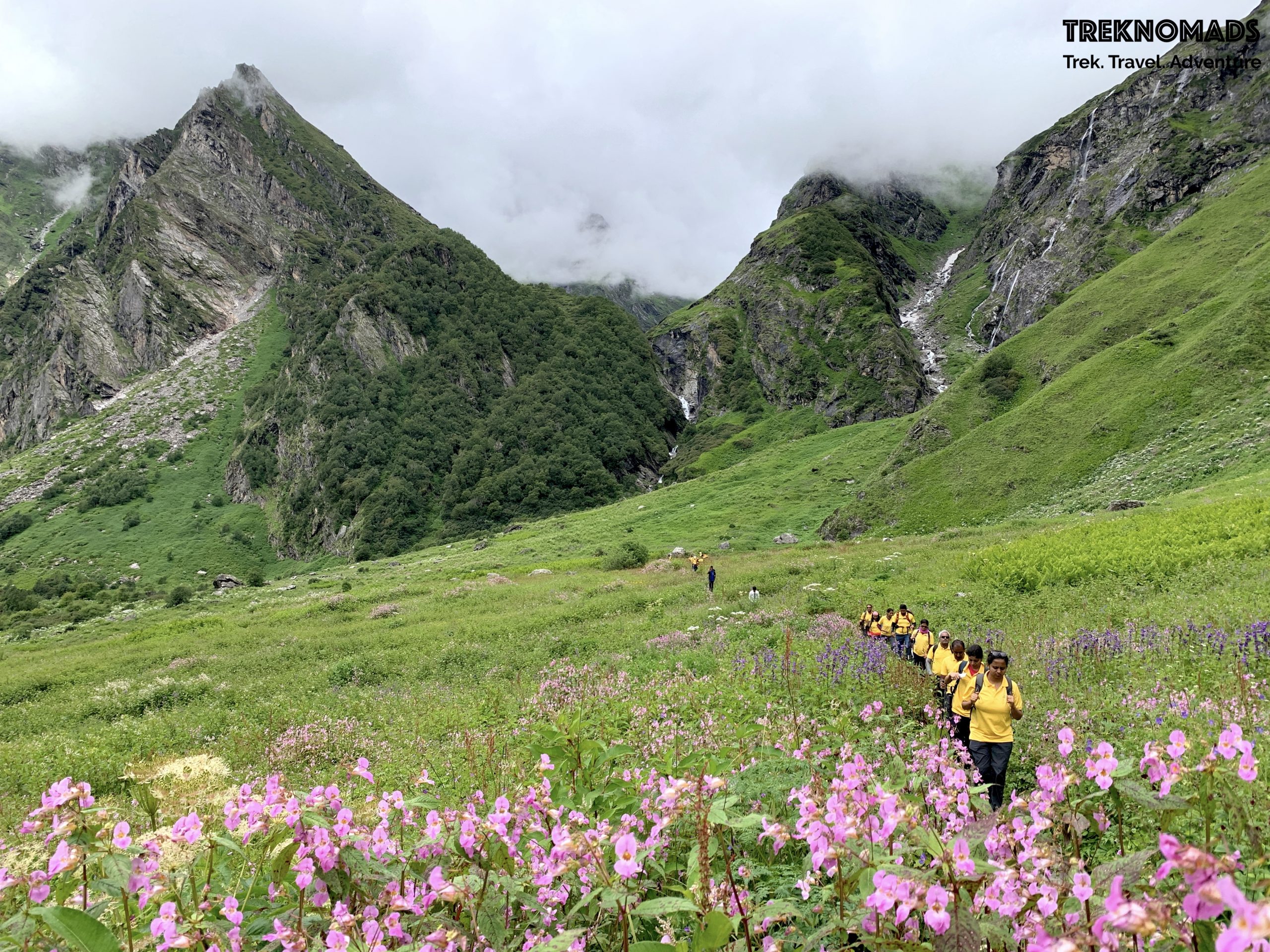
Carpeted in flowers.
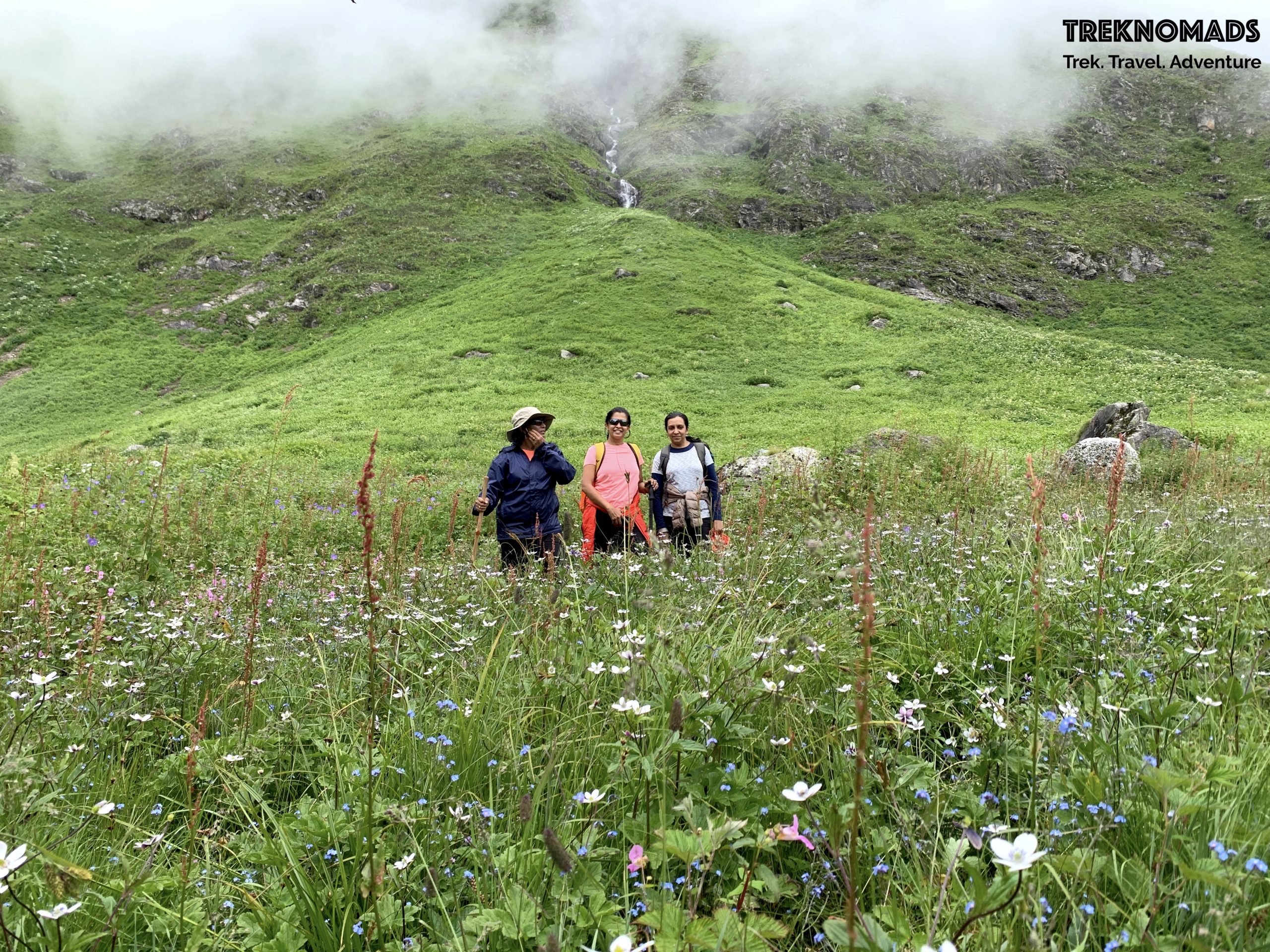
At Legge's grave.
Day 7: Badrinath and Mana Village*
Altitude: 6,150 ft (1,875 m)
Trek Distance / Duration: 10 kms / 3-4 hours
Travel Distance / Duration: 60 kms / 3-4 hours
Trek back to Govindghat from Ghangariya and visit the holy Badrinath Temple and India's last village, Mana (this depends on the time taken to descend back to Govindghat from Ghangariya and only if weather permits). Badrinath to valley of flowers trek distance is 25kms. Stay the night in Joshimath.

The Badrinath temple, one of the Char Dhams in India.

A short visit to Mana before we head back to Joshimath.
Day 8: Rishikesh
Altitude: 1,030 ft (312 m)
Travel Distance / Duration: 250 kms / 8-10 hours
On your last day, you travel back to Rishikesh from Joshimath via road giving you the final few glimpses of the white peaks and the beautiful Himalayas. You will reach Rishikesh by night time or late evening. Stay the night in Rishikesh.
Day 9: Your City
Today you travel back to your city.
Trek Insurance for Valley of Flowers Trek
Trekking in the Himalayas comes with its own set of risks. While adventure is fun and can be extremely thrilling, nature can be unpredictable, and to help secure you during your trek, it is of utmost importance that you are covered with insurance.
We've gone a step ahead and made sure that you don't have to worry about scouting for the best insurance option out there. When you trek with us, your insurance comes as a part of your inclusions. To know more about the benefits covered and sum insured, click here .
Risk and Liability for Valley of Flowers Trek
We will endeavor to make your program smooth and as pleasant as possible. However, the entire course of trekking depends on the ranges of the mighty mountains, physical health, and environmental conditions. Therefore, TrekNomads shall not be responsible for any changes in the itineraries due to unavoidable circumstance and natural disasters such as landslide, road blockage, flood, snowing, cancellation of flight and delay, any types of sickness including altitude sickness
Fitness Criteria for Valley of Flowers Trek
High-altitude/Himalayan treks require every participant to maintain a certain form of physical fitness that will help them trek with ease. A good fitness regime followed by a healthy diet can help you get fit for a Himalayan/high-altitude trek. However, it is advised that you consult with your doctor and then participate in a Himalayan/high-altitude trek.
- Begin your training about 6 weeks before your departure
- Focus on building your stamina through Aerobics, Running, Stair Climbing, Swimming or Cycling about 3 - 4 times a week
- Build your core strength with resistance training through Squats, Lunges, Hip Hinging, Step Ups, Planks at least 3- 4 times a week
- Work on developing a breathing rhythm and expanding your lung capacity with deep breathing and Yoga
- As your trek approaches, head out on smaller treks to help you acclimatize yourself
- Don't miss out on exercising if you can help it, even a 30-minute workout regime followed religiously can take you a long way.
Cancellation Policy for Valley of Flowers Trek:
With the changing travel advisories and newer regulations coming into the picture, we understand that deciding and booking a trek can get tricky. We have relaxed our cancellation policy, read our new terms and conditions for cancellation here
Do’s and Don’ts for Valley of Flowers Trek:
- We believe in leaving the mountains in a better condition, which is why we follow a no-litter policy on our treks. Each trekker will have to bring back the waste that is created during the trek.
- Trekking is best enjoyed when you’ve worn comfortable clothes. Try and avoid wearing Jeans, bright colours and heavy apparels as much as possible.
- A lighter backpack always helps you have a better trek, try and carry just as much as needed.
- Always be in sight of your trek lead, if you feel the need to stop for any reason at all, please keep the trek lead informed.
- If you do come across any reptiles, animals or even insects during the trek, please keep your calm and let it patiently pass by. Any kind of noise and panic will scare them as well.
- Do not venture out into the forest/waterfalls on your own as it may be dangerous.
- Trekking is a good adventure, having said that, it is our primary responsibility to take good care of ourselves and be compassionate towards fellow trekkers
- If, at any point, during the trek, you feel uneasy or unwell, please inform the trek lead immediately
- Tune in to the sounds of nature while on a trek and avoid carrying speakers or playing music during the course of the trek
- To help you enjoy the trek to the fullest, we avoid smoking and consumption of alcohol, and other intoxicants during the course of the trek
What is included in the tour
- Transportation to & fro from Rishikesh in a private vehicle
- 2 nights 3-star hotel stay with breakfast at Rishikesh
- 3 nights resort stay at Auli
- 3 nights hotel stay at Ghanghariya
- Accommodation on a double-sharing basis
- Porter for 1 - 60 ltr Bag (Max 10 kgs)
- 1 litre of mineral drinking water every day in the room
- Snacks box during trekking days
- Entry Permit Fee, Guide Fee & Driver Bata
- Standard vegetarian food for breakfast, lunch, evening snacks, and dinner during trek days
- Visit Badrinath and Mana Village (if and only if time and weather permit)
- 9 days of trekking with an experienced, English-speaking and government-licensed trek guide and assistant trek guide (Number of guides depending on the group size)
- 1 Mountaineering qualified & professional trek Leader
- Insurance, meals, transportation daily salary of guide & porter
- Basic First aid Kit with a portable oxygen cylinder
- Personal accident insurance
- All government, local taxes and service charges
- TrekNomads Fee, Trek Captain support and expertise
- ~15% discount on Fast&Up products
- 15% discount on BMore products
- Personalized Dri-Fit T-shirt and Cap
- TrekNomads goodies
What is NOT included in the tour
- The cost to reach Rishikesh and back
- Airport Pick up and Drop Off
- Personal trekking gear
- Tips for guide, chef, porter, etc (calculated per person)
- Excess baggage charges, if it exceeds 10 kg
- Local sightseeing and entrance fee, camera fee, etc
- Mineral water or any type of soft drinks
- Hot water for shower, etc, during the trek
- Extra meals apart from inclusions
- Food during travel days
- Lunch and dinner at Rishikesh 3-star hotel stay
- Any other tickets like cable chair, cable car, etc.
- Any other expenses incurred apart from inclusions
- All personal, medical, evacuation and emergency expenses like extra day stay out of itinerary, helicopter services and vehicle charges due to delays, landslides, evacuation
- Expenses incurred for guide or porter during extra days stay, transport, flight, helicopter service, etc (divided amongst the group which utilises the services of guides/porters on extra days)
Altitude Map:
- Joshimath: 6,150 ft (1,875 m)
- Auli: 8,366 ft (2,550 m)
- Gorson Bugyal: 10,544 ft (3,214 m)
- Govindghat: 5,997 ft (1,828 m)
- Ghangariya: 10,003 ft (3,049 m)
- Hemkund Sahib: 15,200 ft (4,633 m)
- Valley of Flowers: 12,002 ft (3,658 m)
- Badrinath: 10,828 ft (3,300 m)
- Mana: 10,561 ft (3,219 m)
Other Details:
- Trek Gradient: Moderate
- Trek Distance: 40+ Km
- Assembling Point: Rishikesh
- Average Temperature: 5°C to 20°C
- Travel Distance: 720+ Km
- Best Months to trek: June, July, August, September
Valley of Flowers Trek FAQs
What is the valley of flowers trek difficulty level.
The valley of flowers trek difficulty level ranges from easy to moderate. The treks from Govind Ghat to Ghangariya, Ghangariya to Valley of Flowers, and Hemkund Sahib are all well-defined man-made paths, making it a relatively easy trek. If you think the trek is too difficult, you can always hire a pony or a Dholi to complete it for additional charges. However, we recommend walking the entire trail to fully appreciate its beauty.
When is the valley of flowers trek best time?
Valley of flowers trek best time is supposed to be from June to September are the best months to do the Valley of Flowers Trek as you get to see 520 species of high altitude plants including angiosperms, gymnosperms, and pteridophytes, of which 498 are flowering plants.
What should I carry on the Valley of Flowers trek?
We will share a detailed checklist of all equipment and essential items that you would need to carry on this trek once you register for the trek. If you need any assistance in buying/understanding what to buy for the trek, our team will be happy to help you.
Do I need to carry a medical kit on the Valley of Flowers trek?
Our trek lead/captain will be carrying a basic first aid kit along. We recommend that you carry your personal medication and consult your doctor on the medicines you are required to take for the Valley of Flowers trek.
Do you practice responsible trekking on your treks?
We do not allow plastic on our treks; this means that we do not provide plastic bags, bottles or even lunch boxes on our treks. You will have to carry your own lunch box, water bottle, and cutlery that you will use during the trek. Not only does this help you go plastic-free it also helps prevent litter.
Where is Valley of Flowers trek?
Valley of Flowers National Park is an Indian national park which was established in 1982. It is located in Chamoli in the state of Uttarakhand and is known for its meadows of endemic alpine flowers and the variety of flora. Valley of flowers himalayas trek is the most sought after trek among the trekking community.
What kind of flowers do we get to see in the Valley of flowers?
The Valley of Flowers is endowed with 520 species of high altitude plants including angiosperms, gymnosperms, and pteridophytes, of which 498 are flowering plants. The Valley of Flowers in Uttarakhand is a haven for shutterbugs and professional photographers, with rich Himalayan flora including several rare medicinal plants such as Aconitum Heterophyllum, A. Falconeri, Arnebia Benthamii, Dactylorhiza Hatagirea, Gymnadenia orchids, Megacarpaea Polyandra, Picrorhiza Kurroa, Podophyllum Haxandrum,
How much valley of flowers trek distance will be covered in the span of 9 days?
We will be covering a distance of around 50km on the Valley of flowers Trek. According to the valley of flowers itinerary, the trek route will be as follows: Govindghat --> Ghanghariya --> VOF-->Ghanghariya--> Hemkund Sahib --> Ghanghariya -->Govindghat. When you add acclamatisation trek in Auli, the Valley of Flowers trek distance will be around 65 Kms in total.
What is the temperature like on the Valley of flowers trek?
Minimum temperature on the trek to valley of flowers in the winter is observed to be 5°C to 20°C. At times, it may go below zero as well especially if it rains or snows. On usual days, valley of flowers trek tempreature is 25°C.
Do I need a porter and mule to carry my luggage during the trek?
Porters and mules come as a part of your inclusion when you trek with TrekNomads. Each trekker can get their rucksack (1 – 60-liter bag that weighs up to 10 kg max) transported by porters without any extra cost all through the trail. However if you wish to book an additional porter or mule, you may speak to the trek lead.
Will there be an ATM available on the trail of Valley of Flowers trek?
There is no ATM facility available in Ghangariya. There are ATM facilities available in Joshimath, however, they too run out of cash very often. We recommend you withdraw the required amount at Rishikesh or while traveling to Rishikesh.
What types of stays/accomadation will be available on Valley of Flowers trek?
The stays all through the trek will be in private rooms with private washrooms:
- 3 star or similar hotel stay in Rishikesh
- Resort stay in Auli
- Semi deluxe stay in Ghangariya
- Resort/hotel stay in Joshimath
What type of toilets/rest rooms will be available on Valley of Flowers trek?
The hotel rooms in Joshimath and Auli will have proper washrooms available. Proper running water and english toilets will be available during the stay on this trek in Ghanghariya also.
Will there be Network Availability in Valley of Flowers trek?
On valley of flowers trip, you will not get a good network signal until Joshimath. You will get 4G network at Auli as well - on day 1. On the trail, you might have intermittent signals on the first and last day of the trek. At the base camp, you will get Jio and BSNL network coverage if the weather conditions are good.
What is the Nearest train station to valley of flowers uttarakhand trek?
Nearest railway stations to the valley of flowers trek Dehradun and Haridwar.
Which is the nearest big city to Hemkund sahib valley of flowers trek? How to reach from here?
Nearest big city to Hemkund sahib valley of flowers trek is Rishikesh. The further journey to Joshimath shall be done by road.
Can you share more details about your valley of flowers trek package?
The valley of flowers uttarakhand trek is a 9-day trek. The valley of flowers trek cost with TrekNomads is Rs. 24,999 per person. To check out departure dates and batch details, valley of flowers trek itinerary, valley of flowers trek package, visit here .
What is the valley of flowers trek itinerary?
The assembling point of the valley of flowers trek is Rishikesh. From RIshikesh, you head towards Joshimath. Joshimath to valley of flowers distance is 21km. And the trek starts from Auli. You can check out detailed valley of flowers trek itinerary here .
What is valley of flowers height? Is acclimatisation really important?
Valley of flowers altitude is as high as15,200 ft. High altitude acclimatisation is the process in which our body becomes accustomed to lower levels of oxygen in the surrounding air. If individuals cannot acclimatise to high altitude, they may suffer from a high-altitude disease, such as acute mountain sickness (AMS) or chronic mountain sickness (CMS).
You will be acclimatising in Auli for a day. There will be an acclimatisation trek to Gorson Bugyal followed by the rest of the trek.
Loading the map...
- CONNECT WITH US
- TREKNICAL DETAILS

Recognitions

OTHER POPULAR TOURS
![Kashmir Great Lakes Trek [Premium] - Tour Kashmir Great Lakes Trek [Premium] - Tour](https://vl-prod-static.b-cdn.net/system/images/000/414/735/bed5a46f080cd0e89659ed19c0c6d7aa/x400gt/TrekNomads_Website_Banner__13_.png?1684931452)
Kashmir Great Lakes Trek [Premium]
![Everest Base Camp Trek [Premium] - Tour Everest Base Camp Trek [Premium] - Tour](https://vl-prod-static.b-cdn.net/system/images/000/352/493/2f06596a5543585d0f67bc5c9eabe2dd/x400gt/Everest_Base_Camp.png?1684317973)
Everest Base Camp Trek [Premium]
![Chadar Frozen River Trek [Premium] - Tour Chadar Frozen River Trek [Premium] - Tour](https://vl-prod-static.b-cdn.net/system/images/000/368/624/b01f657970710dd69fd60e5a8a5fe331/x400gt/30897158504_d919736d36_o.jpg?1688435753)
Chadar Frozen River Trek [Premium]
OTHER ACTIVITIES

- Testimonials
- Customized Private Treks
- Corporate Outings
- Cancellation Policy
Online booking system by Vacation Labs | © 2024 TrekNomads

IMAGES
VIDEO
COMMENTS
When it comes to Hemkund Sahib trek difficulty, it's a not-so-difficult trek for most part. However, the last 6 km of the trek are very steep, and can be way more challenging than the nearby Valley of Flowers trek. In order to reach Hemkund Sahib, you need to start the trek from Govindghat, which is about 14 km from the basecamp, Ghangaria.
Overall, Hemkund Sahib trek difficulty is moderate. It is not a particularly difficult trek but it can be a little tiring during to the incessant rainfall and the concrete steps that are laid out for the pilgrims. Hemkund Sahib Trek Route. As I mentioned earlier, Hemkund Sahib Trek is a 6 km trek from Ghangaria village and can take around 3-4 ...
Hemkund Sahib Trek Difficulty Level. It is a revered Sikh pilgrimage site with the pristine beauty of the Himalayas. The trek spans approximately 10 kilometers, winding through breathtaking landscapes that will leave you in awe.
Hemkund Sahib History - Hemkund in the Sanskrit language means a Lake or a bowl of Snow, a name attributed to the glacial lake. Hemkund Sahib Yatra is a sacred pilgrimage experience for the Sikhs. Hemkund Gurudwara or Sri Hemkunt Sahib is dedicated to its 10th leader, Guru Gobind Singh. It's the highest Gurudwara in the world at over 15,000 ...
History of Hemkund Sahib Trek. Hemkund Sahib (also spelled Hemkunt), formally known as Gurudwara Shri Hemkund Sahib Ji, is a Sikh place of worship and pilgrimage site in Chamoli district, Uttarakhand, India. It is devoted to Guru Gobind Singh (1666-1708), the tenth Sikh Guru, and finds mention in Dasam Granth, a work presumed to be dictated ...
Hemkund Sahib Pilgrimage: A Divine Odyssey. At an awe-inspiring altitude of 4,632 meters above sea level, Hemkund Sahib Trek is one of the highest Gurudwaras in the world. The pilgrimage to Hemkund Sahib is not just a trek; it's a spiritual odyssey. Devotees from all corners of the globe flock here to seek blessings and solace.
The Hemkund Sahib Trek is a sacred pilgrimage nestled in the lap of the Himalayas. It leads devotees to the revered Hemkund Sahib Gurudwara, a high-altitude Sikh shrine surrounded by stunning landscapes. ... Duration and Difficulty. The Hemkund Sahib Trek typically spans around 6 to 7 days, covering a distance of approximately 19 kilometers ...
The Hemkund is located at a height of 15000 feet (4329 meters) above sea level and is encircled by seven big mountains, as well as a sacred lake that freezes in the winter. ... Difficulty of the Hemkund Sahib Trek. The complete trip from Ghangharia hamlet to Hemkund sahib is 6 kilometers, and the ascent takes around 3 hours. The whole hike ...
Sri Hemkund Sahib Complete Trek Guide | Sri Hemkund Sahib Gurdwara, dedicated to the 10th Sikh Guru, Sri Guru Gobind Singh (1666-1708) Close Menu. ... Sri Hemkund Sahib Gurudwara, situated at an altitude of 4632 meters above sea level, is a very beautiful and grand Gurudwara made of white marble.
The Hemkund Sahib Trek is a popular hiking route that attracts thousands of visitors each year. The trek begins from the town of Govindghat and passes through scenic landscapes, including forests, waterfalls, and rivers. The trek is moderately difficult, with steep climbs and rocky terrain, and takes around 4-5 days to complete.
792. Shri Hemkund Sahib is a beautiful holy place and pilgrimage site located in the Himalayan Mountains. It is a very popular destination for Hindus and Sikhs alike and is known for its scenery and peaceful atmosphere. This Gurudwara is at a height of 15000 feet above sea level and there is very cold weather. The temperature is around 9 degrees.
The heaven for spiritual seeker and nature lover - Hemkund Sahib Few tips for your visit to Sri Hemkund Sahib - Trek trail is little difficult. Basic level of fitness is highly recommended for this trek. - Pony services can be opted in case of any difficulty. However, I will recommend for trekking to enjoy the nature.
The trek distance is 14 km, which can be covered by foot, pony, palki, or helicopter. The trek duration is 6-8 hours from Govind Ghat to Ghangaria (base camp), and 3-4 hours from Ghangaria to Hemkund Sahib. The trek difficulty level is moderate to steep, and requires physical fitness and stamina.
Govindghat, at a height of 6000 ft above sea level, is a 2 fold place. The upper fold has few shops and hotels. This fold is right on the main road which connects Joshimath with Badrinath. ... After an arduous trek, finally I reached Hemkund Sahib (at a height of 16000 ft) at around 8:00 AM. The holy place, which I had seen only on TV or other ...
Best Time to Visit Hemkund Sahib. Best time to go for Hemkund Sahib Trek is in summers (May - June) and Post Monsoon (September - mid October). In May and June, the weather becomes tolerable and the snow also melts, thus making it a bit easier to do the trek. In September and October, the weather becomes cold but the trail is lush with ...
About Hemkund Sahib Yatra Trek Distance Covered: 19 kilometre Palkis/Ponies/Pitthus: Available Duration: 8-10 hours Difficulty Level: Last 2 kms to reach Ghangaria and 6 kms from Ghangaria to Hemkund Sahib can get challenging After reaching Govind Ghat by a suitable means of transportation, one must undertake a 19-km trek to reach Hemkund Sahib.
There are two sections on the trek which determine the difficulty level of the Valley of Flowers trek. Trek To Hemkund Sahib. While on the trek, the toughest day is Day 4. On this day, you trek up-to Hemkund Sahib Gurudwara from Ghangria. Here, trekkers are required to ascend nearly 4500 feet within six hours. The trail is not technically ...
About Hemkund Sahib Trek. The Gurudwara, Hemkund Sahib is situated at a height of about 15,000 feet above sea level and the motorable road extends from Rishikesh to Srinagar, then to Joshimath and to Gobind Ghat from where the rest of the journey has to completed either on foot or by riding mules.
The Hemkund is settled at 15000 ft (4329 m) above sea level and is surrounded by the seven great mountains there is a holy lake as well which gets frozen in winters. This beautiful holy lake is near the Gurudwara sahib and devotees dip into this before entering the Gurudwara Sahib. ... The total Hemkund Sahib trek distance from Govindghat is 20 ...
Hemkund Sahib Trek Difficulty Level. The trek to Hemkund Sahib is considered a moderate to difficult trek. The trek is about 19 km long and involves a steep climb of about 6 km. The altitude gain is significant, and the air gets thinner as you climb higher, making it difficult to breathe.
The difficulty level of the Valley of Flowers. A very well-paved trek, The Valley of Flowers is moderate to easy. ... Start your day early in the morning after having a hearty breakfast. A 10-kilometre trek, aka Hemkund Sahib Yatra, takes you to Hemkund Sahib Gurudwara and Hemkund lake. Hemkund Sahib Gurudwara is the world's highest Gurudwara ...
A birds-eye view of the small town of Ghangariya nestled amidst the mountains. This view can be seen from the Hemkund Sahib trek trail. Day 5: Hemkund Sahib. Altitude: 15,200 ft (4,633 m) Trek Distance / Duration: 14 kms / 7-8 hours. Today's trek to the Gurudwara is tedious yet the whole vibe is extremely pious and positive.
Hemkund Sahib. It is also known as Gurudwara Sri Hemkund Sahib Ji, is a Sikh place of worship located in the Chamoli district of Uttarakhand, India. Situated at an altitude of about 4,300 meters (14,107 feet) above sea level, it is one of the highest gurudwaras (Sikh temples) in the world. The story begins with the Dasam Granth, a religious ...